- BENEFITING LOCALS via UN SDGs
- COMPLETE LIST OF JEEP & CAR TOURS
- Bird Watching and Wildlife
- Karakorum to Hot Springs
- Golden Dunes to Steppe Waterfall
- Gobi Desert Marvels
- Sand to Green Sea
- Crown Gems of Mongolia
- Become A Mountain Nomad
- Become A Desert Nomad
- Kazakh Eagle Festival
- Gobi Desert to Oasis
- BEST of Northern Mongolia
- Tavan Bogd Mountain Region
- Zavkhan Dunes to Otgontenger Mountain
- Triple Lakes
- National Naadam Festival
- Legendary Art of Mongolian Archery
- Learn the Mongolian Horse-head Fiddle
- Mongolian Khoomei
- Learn the Elite Art of Mongolian Calligraphy
- Learn the Famed Fine Asian Arts
- Empowerment Impacts
- 7 Days – Khuvsgul Lake Horse Riding
- 7 Days – Nomadic Homestay at Terelj National Park
- 5 Days – Experience Western Mongolia’s Kazakh Lifestyle
- Horse Riding Trails with Nomadic Community Support (2024 TBD)
- Complete List of Community Based Nomadic Trails (2024 TBD)
- LEARNING AREA: Language, Culture, etc.
- Mongolian Foods
- Mongolia Horse Riding Tours and Culture
- How to Successfully Homestay
- Winter Mongolia Homestays
- Eastern Mongolia Homestays
- Western Mongolia Homestays
- Northern Mongolia Homestays
- Mongolia’s Shamanism
- 1. Gobi Desert
- 2. White Lake
- 3. Lake Khuvsgul
- 4. Gobi’s Flaming Cliffs
- 5. Tavan Bogd Mountain
- 6. Khar Nuur Lake
- 7. Karakorum
- 8. Golden Ulgii Mountain
- 9. Bird Watching and Wildlife
- Lunar New Year Info
- Winter Ice Festival – Khuvsgul
- Thousand Camel Festival
- Ulaanbaatar Marathon
- Deeltei Mongolia Day
- Tsaatan Reindeer Festival
- Yak Festival
- Nomadic Cultural Naadam
- Danshig Naadam and Tsam
- Eagle Festival
- Ulaanbaatar City Food
- Choiljin Lam Temple
- Natural History Museum
- Bogd Khan Winter Palace
- Gandan Monastery
- Sukhbaatar Square
- Zanabazar Museum
- MONGOLIA’S NATIONAL PARKS & TOURS
- Khuvsgul Trekking Trails
- Terelj Trekking Trails
- Northern Mongolia
- Eastern Mongolia
- Southern Mongolia
- Western Mongolia
- Preperations – FAQs
- GER to GER Mongolia Blogs
- TRAVEL TO MONGOLIA Flights, Trains, Mongolian Visas, Embassy
- Mongolian Climate
- MONGOLEI REISEN – Deutsch Sprachheft
- GEOTOURISM MONGOLIA – Mongolei Reisen
- What to Expect
- Local Living VS Package
- Suitability Check
- Terms and Conditions
- SECURE DEPOSITS/FINAL PAYMENTS


MongoliaN Community Based Tourism (CBT)
Truly benefiting locals.
Authored between 2002-04 and launched in 2005, GER to GER is “THE WORLD’s FIRST” Mongolian Community Based Tourism initiative (social enterprise) to work sustainably with nomadic families across Mongolia for over 15+ years.
ADVANCING COMMUNITIES ETHICALLY
At ger to ger we advance the united nations goals within our community based tourism operations across mongolia – it hasn’t been easy but it’s been worth it, our sdg achievements via community based tourism in mongolia.
AT GERtoGER we are able to tangibly prove how we advance the UN’s MDGs/SDGs in our day-to-day community based tourism operations for DECADES (SINCE I started AUTHORing IT from 2002):
- SDG 1 – NO POVERTY: up to 80% of Humanitarian Trips’ finances are returned to rural nomads, drivers, etc.; 20% towards rural communities’ marketing and workshops.
- SDG 2 – ZERO HUNGER: We have/continue to employ nomadic families who are the poorest of the poor, marginalized, challenged, etc.
- SDG 3 – GOOD HEALTH AND WELLBEING: trainings on health/safety/reduce sanitation illnesses (Hepatitis, etc.); incomes for medical insurance, visits, medication, surgeries, etc.
- SDG 4 – QUALITY EDUCATION: Via workshops/incomes nomadic adults/children are receiving education via workshops (locals/internationals), schools, high schools and universities.
- SDG 5 – GENDER EQUALITY: Over 70% of our national managers are women; rurally, women care for travelers’ family experience (food, drink, etc.) while men generally guide (though some women guide).
- SDG 6 – CLEAN WATER AND SANITATION: VIA TRAINING/OPERATIONS 1) nomads/travelers – “Leave No Trace” 2) waste management to mitigate watershed damages along routes, etc.
- SDG 7 – AFFORDABLE AND CLEAN ENERGY: assisted all nomadic families to obtain savings accounts across Mongolia – credit histories used for financial services/small-loans to procure solar/wind powered units and other environmentally safe and affordable tech to make their lives more comfortable and safe (solar freezers for meet/foods, etc.).
- SDG 8 – DECENT WORK AND ECONOMIC GROWTH: Social economic development via tourism while combating negative aspects of open market growth (mainly “ Karens “). Over 90% of HR are rural; via “Geotourism” we strengthen rural supply chains and via community based tourism development we actively seek both direct and indirect means to further advance a variety of social economic development initiatives with both local and international partners e.g. renovating and equipping schools/kindergartens with not only educational materials but also with heating systems (as many student freeze in winter in northern/central Mongolia) as well as enhancing schools’ decors to make them more pleasant for both students and teachers.
- SDG 9 – INDUSTRY, INNOVATION AND INFRASTRUCTURE: “GER to GER” is the Mongol Empire’s ancient “kinetic supply chain” – today this ancient supply chain advances Mongolia’s social economic aspirations.
- do you know
- about Mongolia
Nomadic by Nature
Welcome to Mongolia

You have probably heard of Mongolia through the famous tales of Genghis Khan, history books and Hollywood films. Very few have actually witnessed the raw beauty, culture and heritage of the country. When people talk about the road less travelled, there is no better place than Mongolia as it is one of the world’s least explored travel destinations.
Imagine vast lands as far as the eyes can see, deterred only by tall mountains and trees. Cobalt blue skies hover over scenic landscape encompassing rivers, lakes, forests and deserts. Here, nature is only rivalled by the traditional hospitality of its people, their culture and heritage.
Come and experience the culture and heritage of the last surviving nomadic societies. Adventure awaits you…
- Did you know
- that we are always
- on the move but still
- welcome everyone into
- our communities ?
The world is changing around us but we have always managed to stay true to our millennia-old nomadic lifestyle. Over a third of Mongolia people are still nomadic herders.
Growing trends and shifts toward sustainability and community-based tourism makes Mongolia the ideal destination for travellers who seek just that. Through locally-led tours, visitors can discover the natural beauty, delicious food, exciting festivals and immerse themselves in the cultural heritage of local communities.
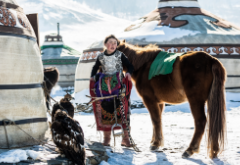
Guvanbulag Community
Find out more how Mongolian Communities are welcome travelers to their homes and heaths.
- the Man of the
- Millennium is
- Mongolian ?
We have all heard the tales of the (in)famous Genghis Khan. A warrior. A leader. An emperor of one of the biggest empires – the Mongols. In history, there is no one who else has been as feared and respected simultaneously. No one who was as controversial or rather, misunderstood.
Genghis Khan conquered vast lands stretching from the Pacific Ocean to Eastern Europe, from Siberia to the Persian Gulf thereby changing the course of history. He was the beginning to where we are now. By creating his empire, he shrank the world as did Christopher Columbus after him.
Despite the greatness of Genghis Khan, he embodied the nomadic way of life of the Mongolians. This is what makes him Man of the Millennium and he was a Mongolian. Only by visiting the country will you truly learn of his dynasty and our history.
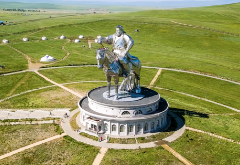
Genghis Khan Equestrian Statue
Mongolia has a millennia-old history and culture. We are proud of and feel connected to our ancestry.
- Mongolia has more
- than 500 bird species ?
With beautiful untouched nature comes exotic wildlife. In particular, Mongolia is especially known for hundreds of migratory and rare birds. Thus, bird watching has become a popular attraction over the years. Visitors and bird enthusiasts will be able to see all sorts of species of falcons, eagles, owls, ducks, swans, buntings and many others.
In November 2012, the Saker Falcon was recognized as our national bird. A fascinating creature indeed.
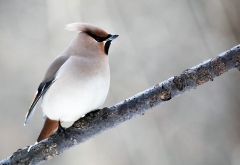
Bohemian Waxing
Explore Mongolia for birding. See which species we have and where to see them best.
- that in Mongolia the Milky Way’s stars
- appear closer and clearer than
- anywhere else in the world?
Mongolia is just as beautiful at night as it is during the day. Imagine camping in a vast open space, cuddled in your warm blanket with a glass of milk in your hand. At night, look above and you’ll be mesmerized by the sky and Milky Way stars. They appear so close and clear, you would not believe it.
If stargazing is your thing, then we invite you to Mongolia as an unrivalled destination.
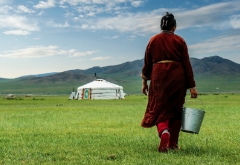
Ger Camping Experience
Gers are the traditional homes of many Mongolians. It is perfect for a nomadic lifestyle.
- Mongolia has
- a horseracing
As part of our nomadic culture, most people learn to ride a horse at a young age. To celebrate cultural heritage, each year an exciting but challenging horse race festival is prepared. Without a doubt, jockeys and horses go through intense training leading up to the event.
It is one of three games that take place during the Naadam festival. Other games are wrestling and archery.
Typically held from July 11 – 15, Naadam festival brings together communities and villages. However, some villages prefer to do it on their own at another time. So, if you miss it during July, there’s always another chance to see it in another part of the country.
Naadam festival is more than just a sporting event, it’s considered our national holiday. So, come – travel to Mongolia and experience this exciting festival for yourself.
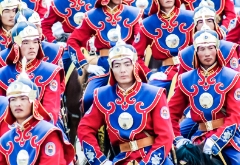
NAADAM Festival
Mongolians know how to celebrate! Find out more about our many events and festivals.
- than 800 buddhist
- monasteries ?
We have always practised Shamanism throughout history, but after the 16th century, Tibetan Buddhism gained more popularity in Mongolia. Since then, despite communism and anti-religious campaigns, we still have hundreds of Buddhist monasteries that highlight our culture, heritage and religious traditions.
These magnificent monasteries and temples hold wonder and magnificence in the eyes of the locals and visitors alike.
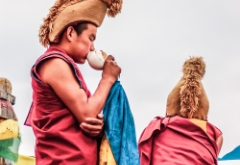
Buddhist Tourism
Mongolia is a land of wonder. Explore our monasteries, festivals, and sights.
Mongolia isn’t just a destination you visit to tick off a bunch of bucket list items. It’s a place you go to just be. For first time visitors, as with any travel planning, it is important to know as much about the country beforehand.
Outside of the cities, where the real culture and adventure lies, travel is rugged and immersive. Expect to stay in local camps (Gers), be on bumpy roads for long hours and away from the modern conveniences of civilization. If you are open-minded and adventurous, there is so much the country has to offer with its culture, history and nature.
Getting to Mongolia
Direct flights are available from countries such as China, Russia, Germany, Korea, Hong Kong, and Turkey. You can also visit Mongolia by train via Trans-Mongolian Line, which is part of the Trans-Siberian Railway. If you’re looking for an adventure and depending on your nationality, you can even drive to Mongolia from Russia or China.
Travel around
While you can get around most of Mongolia by air, the country is still vast and requires a lot of driving to get to places. Getting to distant places and worthwhile destinations require a lot of patience and travel know-how. However, there are plenty of tour operators and logistics companies that are able to help visitors get around the country.
Mongolia has many famous festivals. Find out when and where you can emerge yourself in the festivities.
Family Activities
Families are important to us. Mongolians has strong family bonds and we welcome anyone regardless of age
Bird Watching
We are a paradise for birding. Find out why you should come to Mongolia to watch birds from all over the world.
Mongolia is nature. Nature is Mongolia. Come to the land of endless steppes, forests and mountains.
History & Culture
We are one of the oldest cultures in the region. Explore more about our story and come to see it for yourself.
With numerous temples and relicts, Mongolia is a spiritual place to visit and explore yourself.
Taste of Mongolia
We have dishes you have never tasted anywhere else. Find out more about Mongolian cuisine here.
Community Based Tourism
Our communities welcome you to Mongolia. Find out how you can experiences the nomadic way of life.
Ride through the wide country, take a road trip of your lifetime or hike through the mountains. Mongolia is a haven for adventures. Come and find yours.
Though the meetings, incentive, conference, and exhibition sector is still new for us. Mongolia offers a number of venues and activities that make your event outstanding.
Ulaanbaatar & Surrounding
Ulaanbaatar is the capital of Mongolia. It’s in the Tuul River valley, bordering the Bogd Khan Uul National Park. Originally a nomadic Buddhist center, it became a permanent site in the 18th century. Soviet control in the 20th century led to a religious purge. Soviet-era buildings, museums within surviving monasteries, and a vibrant conjunction of traditional and 21st-century lifestyles typify the modern city.

18 Best Places To Visit In Mongolia
By Jessie Festa. This guide to planning a trip to Mongolia contains affiliate links to trusted partners.
Looking for the best places to visit in Mongolia ?
This guide can help!
Located in Asia between Russia and China, Mongolia is one of the world’s most unique places to visit.
Unlike many destinations, Mongolia remains largely untouched by mass tourism. Because of this, you’ll typically get a more authentic experience when it comes to discovering its history, culture, and scenery.
And there certainly is a lot to discover.
Along with breathtaking landscapes that range from steppe grasslands to rugged mountains to dramatic deserts, you can immerse yourself in local culture by doing a ger homestay, visit historic sites to get a glimpse into the country’s fascinating past, spot diverse wildlife that includes rare and endangered species, and visit true bucket list destinations like the famed Gobi Desert.
But, where can you have these experiences? And what are the most important places and landmarks in Mongolia to see?
Keep reading to learn some of the most unforgettable destinations you should consider adding to your Mongolia itinerary !
⏳ My top Mongolia travel recommendations include: ✈️ Airport Transfer: Book that here 🏨 Hotel: Puma Imperial Hotel (in Ulaanbaatar) 🗺️ Tours: Viator 🎒 Multi-Day Tour Operator: WHOA – use code JESSIEONAJOURNEY for $100 off! 📍 Recommended Excursions: 🐎 Genghis Khan Statue with Terelj National Park & Aryabal Temple 🇲🇳 4-Day Essencence on Mongolia Tour 🛍️ Full-Day Tour of Ulaanbaatar with Museum & Black Market 🥾 Bogd Khan National Park Hiking Day Trip 🥘 Cooking Class: Cooking Class in a Traditional Ger Home in Ulaanbaatar Suburbs 🏥 Travel Insurance: SafetyWing 📞 Staying Connected: Airalo eSIM
Table of Contents
Free Mongolia Travel Planning Resources
But first, before we go over some incredible Mongolia tourist attractions , I invite you to grab access to my free Ultimate Travel Planning Kit — which includes 40+ travel resources — from printables to quizzes to itineraries — all meant to help you explore the world beyond the guidebook!
Some highlights of the kit include:
- Free “Where Should You Travel Next?” personality quiz
- Pre-plotted Google Maps for 45+ destinations
- Printable travel journal with writing prompts
- Packing lists for different types of trips
Once you’ve grabbed your copy , keep reading to discover some of the top Mongolia things to do.
Mongolia Travel Map
To help give you a lay of the land, here is a map for visiting Mongolia in Asia . It includes the recommended places to visit in Mongolia mentioned below pre-plotted:
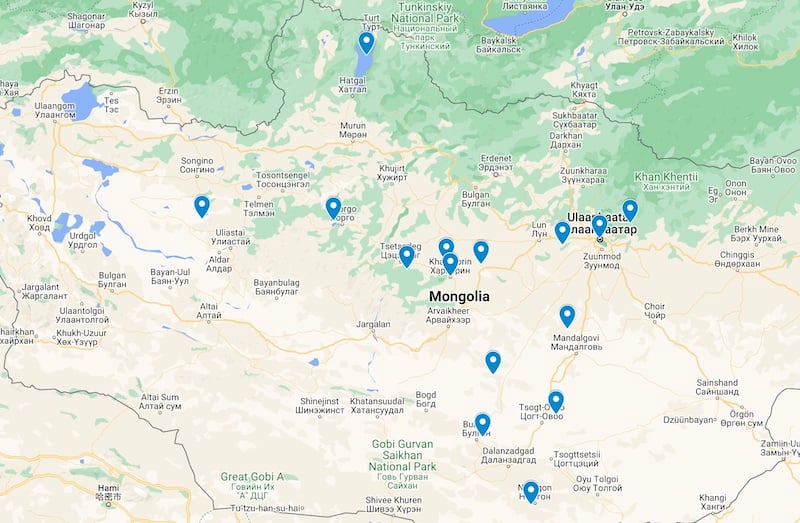
Click here for an interactive version of the Mongolia map .
Best Places To Visit In Mongolia
On that note, let’s dive into some of the top places you should add to your Mongolia itinerary. As you’ll soon see, a few main draws to visiting Mongolia include its astounding natural beauty, rich culture, and fascinating history, all of which you can explore through the below spots.
1. Ulaanbaatar
No trip to Mongolia would be complete without spending time in the capital city of Ulaanbaatar. This is the country’s cultural hub where you can explore Mongolian heritage while also enjoying modern amenities. Museums, art galleries, performances, restaurants, and cultural events can all be enjoyed here.
While there are many fun things to add to an Ulaanbaatar itinerary, a few not to miss Mongolia attractions in the city include:
Zaisan Hill Memorial was built between 1971 and 1974 to show gratitude to the Soviet Union (USSR) for its assistance during Mongolia’s fight against Japanese forces. It features a memorial complex honoring the Soviet soldiers who lost their lives during WWII.
Additionally, you can enjoy sweeping views over Ulaanbaatar as you take in the city skyline, the Tuul River, and the surrounding hills and mountains.
Just note that to reach the top you’ll need to walk up 600 steps, though you can cheat a bit by going inside the mall at the base of the hill. Here there is an elevator that can get you about halfway up.
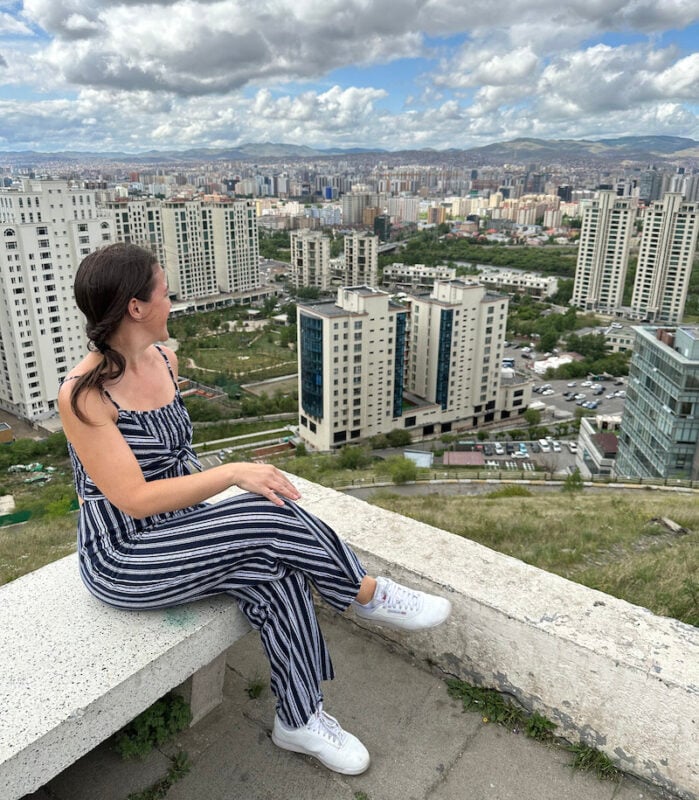
Gandantegchinlen Monastery (Gandan Monastery) was founded in 1838 and is one of Mongolia’s only Buddhist monasteries to survive Soviet rule when many of these sacred places were destroyed. Today, it’s the country’s largest active monastery. Inside, you can also view a golden 26.5-meter-tall Avalokiteshvara, the Buddha of Compassion.
The National Museum of Mongolia is one of the most important museums in the country. Here you can peruse a huge collection of artifacts and exhibits that showcase the country’s history, from prehistoric times to the present. A few highlights of the museum include viewing traditional costumes, archaeological discoveries, and religious artifacts.
2. Gorkhi-Terelj National Park (Töv Province)
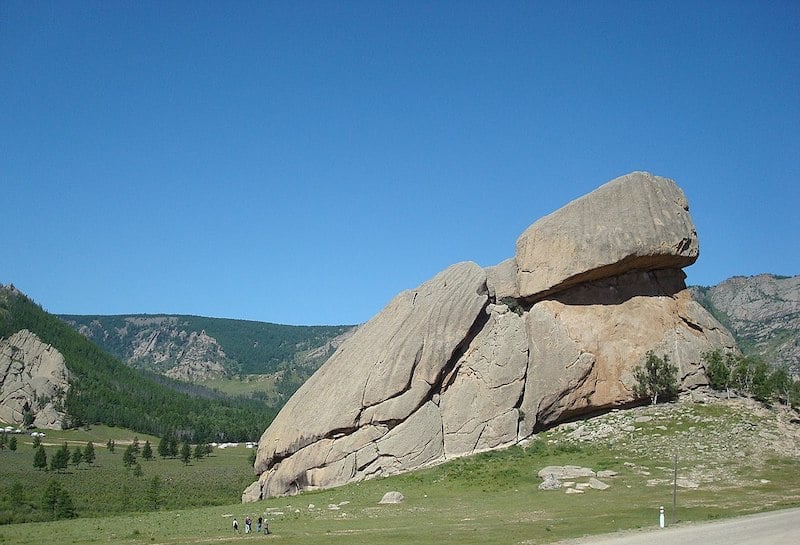
If you’re looking for Mongolia places to visit near Ulaanbaatar, Gorkhi-Terelj National Park is a top pick. Known for its stunning landscapes that range from vast valleys to lush forests to towering rock formations, it’s a great place for hiking, horseback riding, rock climbing, and camping.
Additionally, you can interact with nomadic families and can even stay overnight in a ger — a must-have experience during a visit to Mongolia. A ger is a portable and round traditional dwelling that is similar to a yurt, though there are some regional and cultural variations in the terminology and design.
Two popular attractions in this park include Turtle Rock , a giant rock you can hike up that looks like a turtle, and Ariyabal Meditation Temple , a spiritual retreat where you can meditate and relax in a serene setting.
3. Hustai National Park (Töv Province)
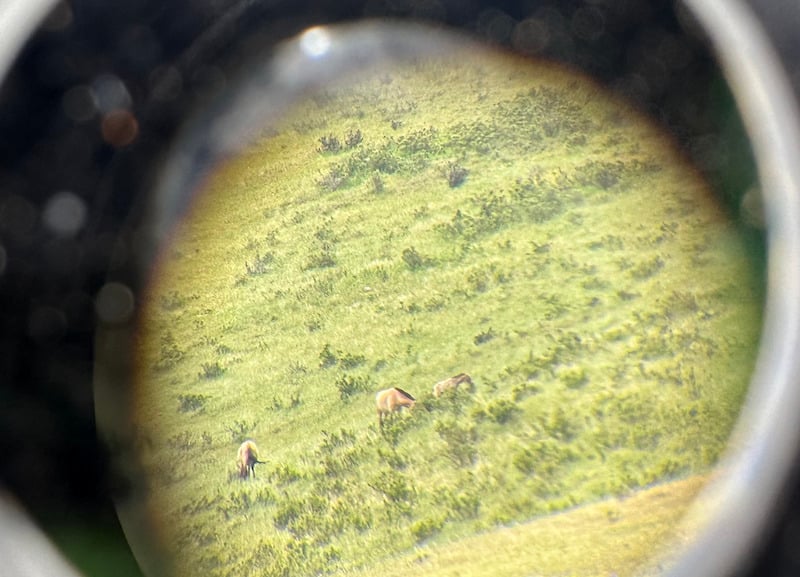
Home to beautiful landscapes and diverse wildlife, the main reason this is one of the best places to see in Mongolia is its wild horses.
In fact, Hustai National Park is famous for reintroducing the endangered Przewalski’s horse, also known as the Takhi or Mongolian wild horse.
Today, the park acts as a protected area and reserve for these horses which, according to my guide when I visited, is the only true wild horse in the world.
You can drive around on your own or with a biologist to try to spot these beautiful creatures. Additionally, keep your eyes peeled for marmots (you’ll see a ton of them), red deer, Mongolian gazelles, and a variety of bird species.
To further your education, the Hustai Visitor Center has a small but informative museum, video viewing room, and gift shop.
4. Gun-Galuut Nature Reserve (Töv Province)
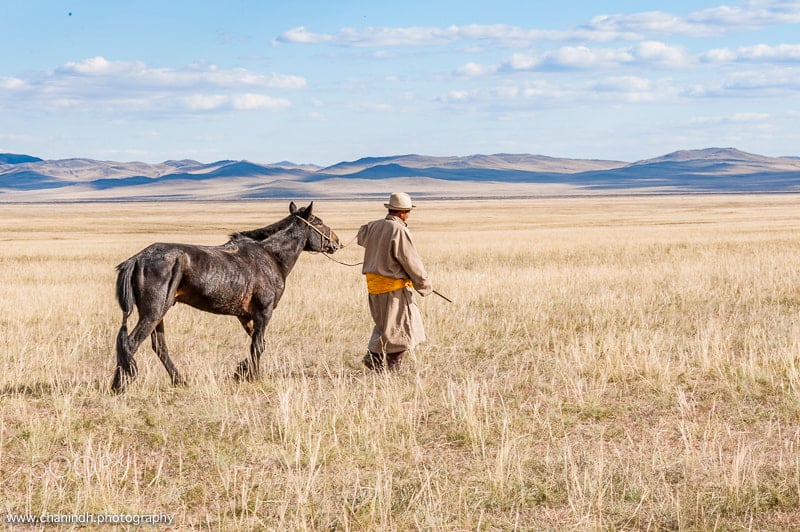
This protected area in Mongolia showcases diverse landscapes — including wetlands, mountains, rivers, and grasslands.
If you enjoy outdoor adventure , it’s one of the top places in Mongolia for hiking, horseback riding, and cycling. Birdwatching is also popular, particularly around beautiful Lake Khökh .
Additionally, the nearby Kherlen River provides opportunities for kayaking, rafting, and fishing.
If you enjoy wildlife spotting, Gun-Galuut Nature Reserve is home to animals like the endangered Saker falcon, Mongolian gazelle, argali sheep, and wild boar.
Want to immerse yourself in Mongolian culture? Opt to stay overnight in a ger!
5. Lake Khovsgol National Park (Khövsgöl Province)
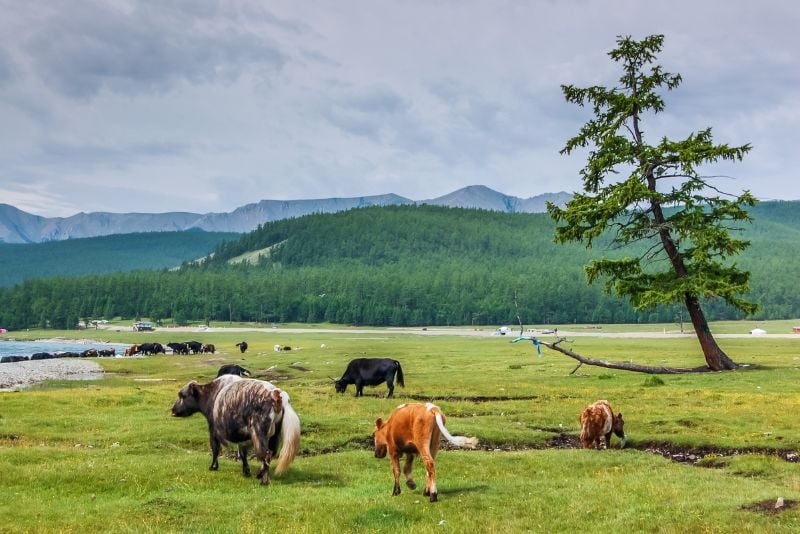
Lake Khovsgol National Park, also known as Khövsgöl Nuur National Park, features 8,865 square kilometers (3,423 square miles) of natural beauty.
Along with typical outdoor adventures like hiking, horseback riding, and camping, it’s one of the best places in Mongolia for wildlife spotting. This is because it’s home to several endangered and rare species, such as the Siberian ibex, argali sheep, Eurasian lynx, and the gray wolf.
The main attraction within the park is the namesake Lake Khövsgöl — one of Central Asia’s largest and deepest freshwater lakes and one of the best places to visit in Mongolia.
Showcasing crystal clear waters surrounded by mountains, meadows, and forest, its nickname is the “Blue Pearl of Mongolia.”
6. Amarbayasgalant Monastery (Selenge Province)
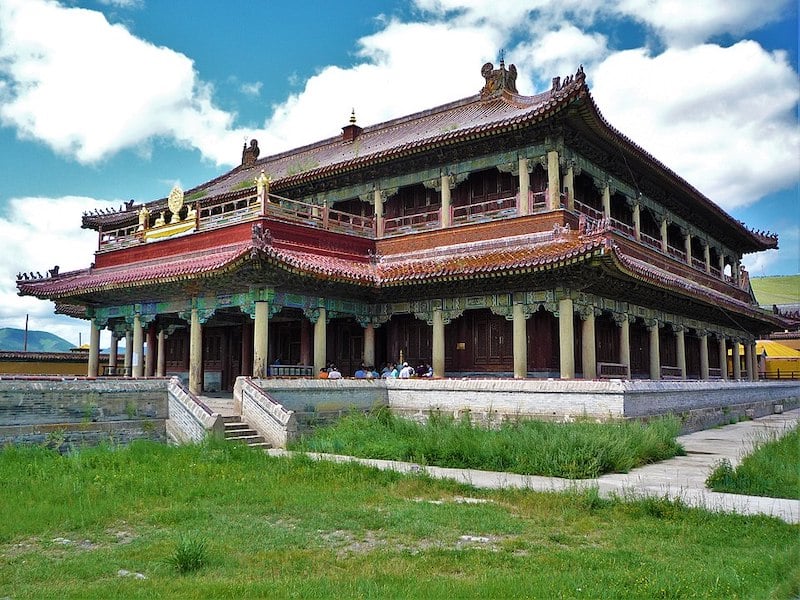
The main reasons to visit this Buddhist monastery include its cultural significance and stunning traditional architecture with intricate artwork, detailed carvings, and vibrant murals.
In terms of design, the Amarbayasgalant Monastery complex features several temples, prayer halls, dormitories for monks, and administrative buildings — with the most impressive structure being the Zuu Temple , which houses a large statue of Buddha Amitayus.
Amarbayasgalant Monastery was originally constructed in the 18th century to honor Zanabazar, a spiritual leader and an influential figure in Mongolian Buddhism.
7. Gobi Desert (Several Provinces)
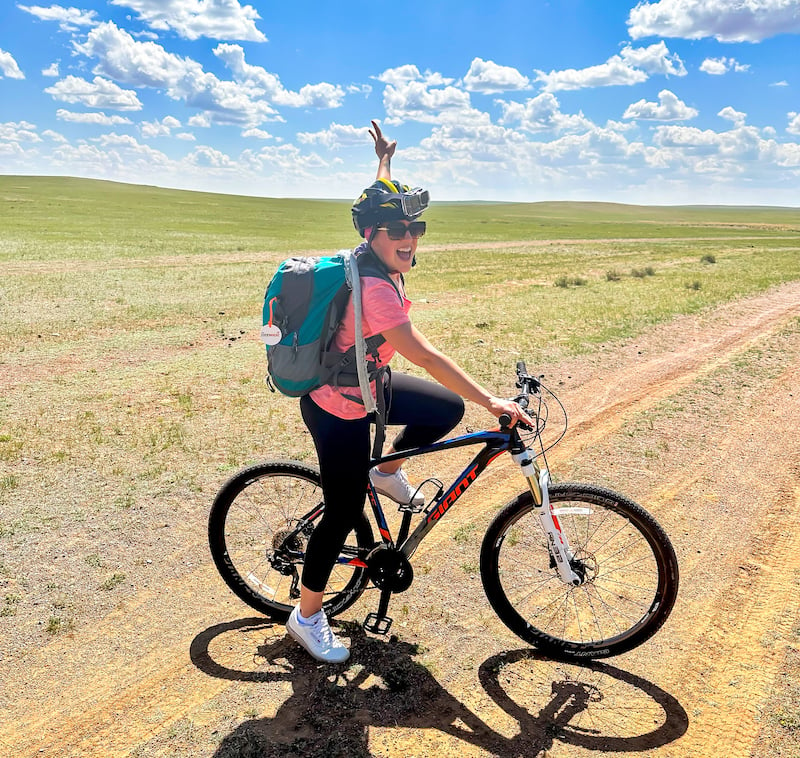
No list of the best places to visit in Mongolia would be complete without mentioning the Gobi Desert. Personally, this was a main highlight for me when I visited Mongolia thanks to its magnificent scenery, diverse landscapes, and outdoor adventure opportunities.
As the Gobi Desert is vast, it actually spans several provinces, including:
- Ömnögovi Province
- Dundgovi Province
- Bayankhongor Province
- Dornogovi Province
This also means you’ll encounter a wide variety of landscapes: open spaces, rolling sand dunes, rocky cliffs, canyons, and steppe grasslands that seem to stretch on forever.
In terms of other worthwhile activities in Mongolia, keep your eyes peeled for snow leopards, Bactrian camels, Gobi bears, Gobi gazelles, and numerous bird species.
Speaking of camels, did you know Mongolia is one of the few places in the world where you can see two-humped camels? During my three days in the Gobi, I saw these rare camels multiple times, so your odds of spotting them are pretty good.
Something really neat about the Mongolian Gobi Desert is that it’s the largest dinosaur fossil reservoir in the world, according to UNESCO . I’ll share more about how to explore this when we discuss Bayanzag!
8. Baga Gazriin Chuluu Nature Reserve (Dundgovi Province)
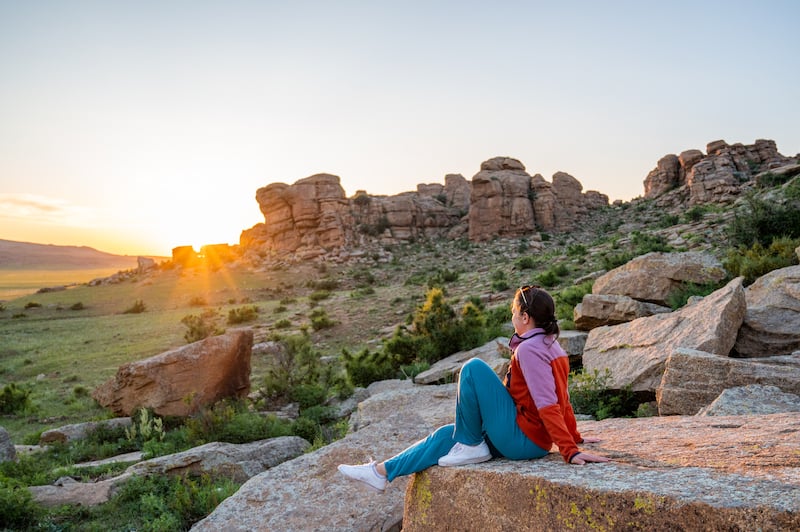
I’ll never forget driving through the Gobi Desert and approaching Baga Gazriin Chuluu Nature Reserve. Suddenly, vast open space turned to giant rock formations and granite outcroppings begging to be climbed and photographed.
Interestingly, only 5% of the Gobi Desert is covered in sand , and this reserve in particular showcases a landscape so different from what you might typically picture when thinking of a desert.
It’s recommended to camp overnight so that you can be perfectly situated for evening stargazing and a morning sunrise hike. Also be on the lookout for snow leopards, argali sheep, ibex, and various bird species.
9. Tsagaan Suvarga (Dundgovi Province)

Also known as White Stupa, this unique geological formation showcases giant limestone cliffs that look like a row of stacked stupas due to erosion and weathering over millions of years.
Not only does the shape of the cliffs make them striking, but also the colors, as they range from white to orange and red. Definitely bring your camera to take photos from a variety of angles as you walk the designated paths.
Another highlight of Tsagaan Suvarga: the panoramic views of the surrounding desert landscape and Mongolian countryside!
10. Ongi Monastery Ruins (Dundgovi Province)
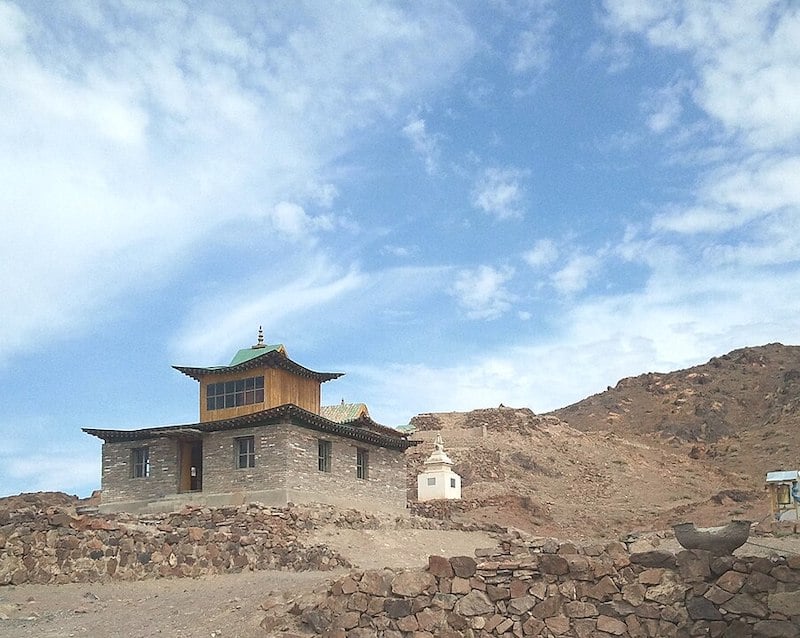
During the late 1930s, a series of political repressions and purges known as the Mongolian Purges took place. They were the result of Soviet leader Joseph Stalin and his policies that aimed to eliminate perceived threats to his regime and establish tighter control over Mongolia.
This included replacing religious beliefs with communist ideology. It is estimated that thousands of Buddhist lamas were killed or imprisoned during the purges and over 700 monasteries were destroyed.
The Ongi Monastery was sadly one of these, though it is still one of the top places to visit in Mongolia due to its cultural significance as well as its architectural beauty. The latter can still be seen despite the tragedy, especially as work is being done to restore the monastery.
Established in the 18th century, Ongi Monastery was one of the largest monastic complexes in Mongolia until its destruction. At its peak, it housed over 1,000 monks and consisted of two main sections, the Barlim Monastery and the Khutagt Monastery.
Pilgrims would come from all over Mongolia and beyond to visit the sacred site, see the ornate temples, and view huge collections of religious artifacts.
Today, the ruins of the temples, stupas, and other monastery structures offer a glimpse into the rich history and spiritual significance of Buddhism in Mongolia while allowing you to take in the beauty of the vast Mongolian steppe.
11. Bayanzag (Ömnögovi Province)
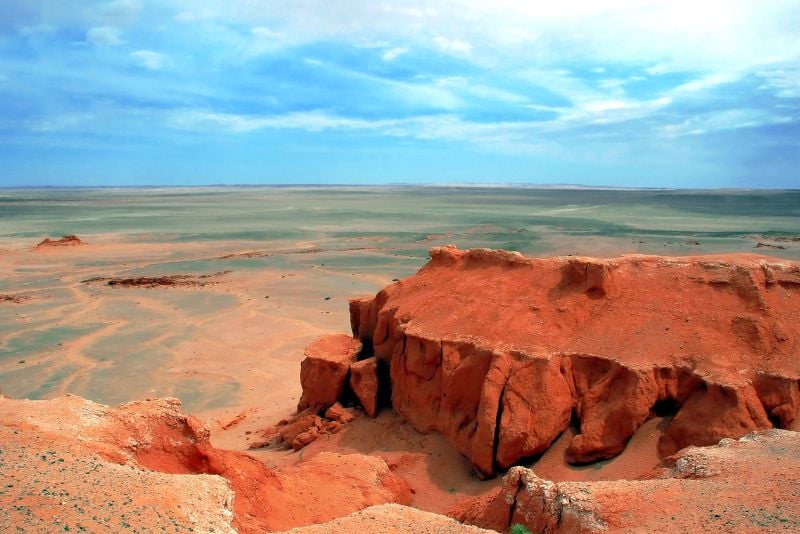
Also known as the Flaming Cliffs, Bayanzag is a famous paleontological site within the Gobi Desert. Everything from dinosaur eggs to the remains of various dinosaur species has been found here.
You’ll be able to explore the site, learn about the region’s prehistoric past at a small nearby museum and, if you’re lucky, you might even spot ongoing excavations.
Another highlight of Bayanzag is hiking around the striking red sandstone “Flaming Cliffs.” Sunrise and sunset are particularly amazing here.
12. Orkhon Valley (Arkhangai Province)
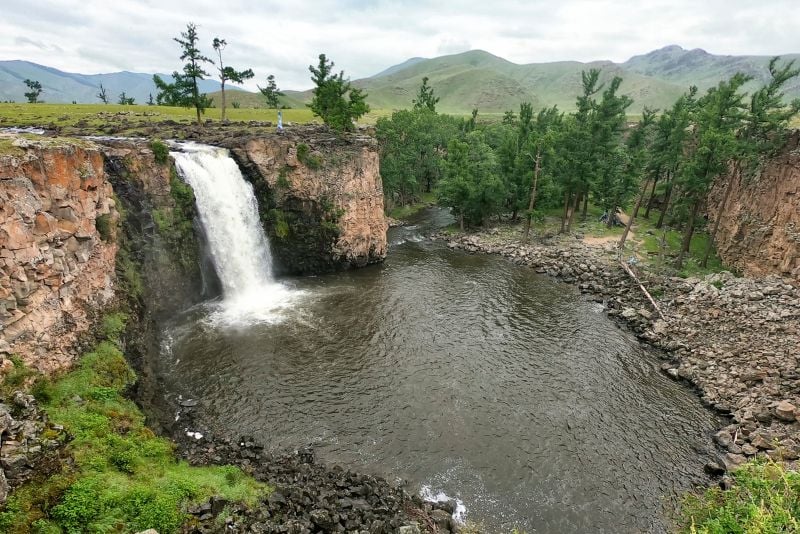
A UNESCO World Heritage Site , the Orkhon Valley is one of the top Mongolia tourist spots thanks to its historical, cultural, and natural significance.
First of all, it’s breathtaking with expansive grasslands, rolling hills, winding rivers, and picturesque waterfalls.
In fact, it’s home to Mongolia’s largest waterfall, Ulaan Tsutgalan (Orkhon Waterfall), which measures about 10 meters (33 feet) wide and 20 meters (66 feet) tall. It’s truly one of the most beautiful places in Mongolia!
Hiking, fishing, camping, and other outdoor adventure activities are popular here — as is staying in a Mongolian ger to learn more about traditional nomadic life.
The Orkhon Valley is also one of the more important historical places in Mongolia, as it once sat at the center of the ancient Mongol Empire. Today, you can explore various archaeological sites — including the ruins of ancient cities, burial mounds, and stone monuments.
13. Khorgo-Terkhiin Tsagaan Nuur National Park (Arkhangai Province)
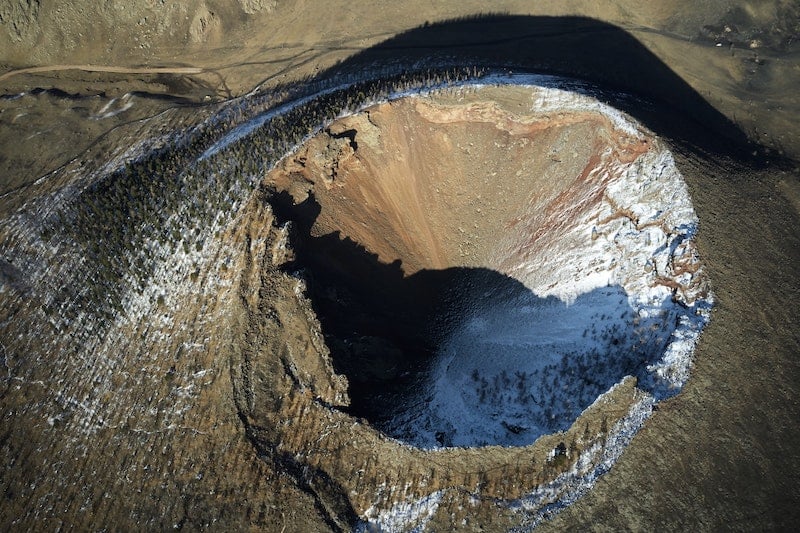
The thing that makes this protected area one of the top tourist spots in Mongolia is its incredible natural beauty, with its two main features being Khorgo , a dormant volcano, and Terkhiin Tsagaan Nuur (White Lake), a pristine alpine lake.
If you love adventure, one of the best things to do in Mongolia is to hike to the top of Khorgo and take in panoramic views of the surrounding volcanic landscapes. Follow this with some camping along the shore of the lake, which is also a great spot for boating and fishing.
Other fun activities in Khorgo-Terkhiin Tsagaan Nuur National Park that make it worth the trip include hiking other scenic trails, horseback riding, and trying to spot wildlife like ibex, argali sheep, and various bird species.
14. Tsenkher Hot Springs (Arkhangai Province)
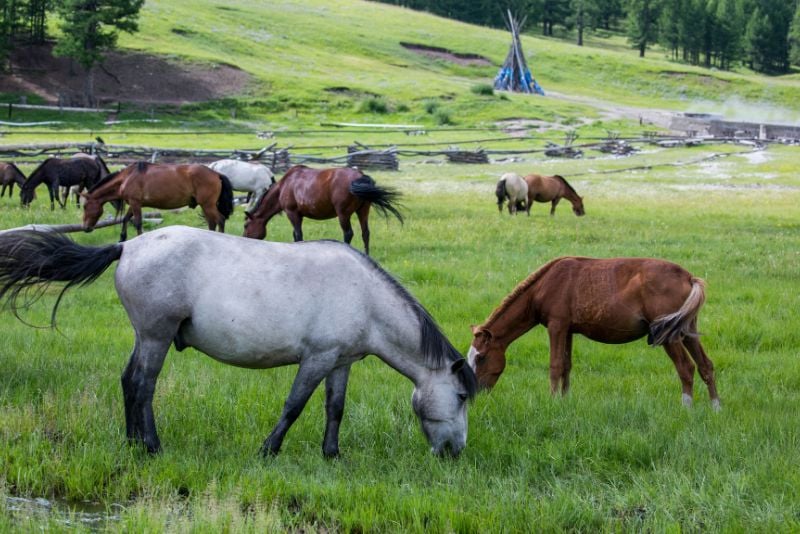
Looking to enjoy wellness travel in Mongolia? The Tsenkher Hot Springs are renowned for their therapeutic benefits and are one of the best places to visit in Mongolia.
The temperature of the water can reach up to 86°C (187°F), but it is usually cooled down for bathing.
You’ll be able to soak in several pools with water containing minerals that are believed to have healing properties for certain skin conditions, joint pain, and other ailments.
The hot springs offer the perfect way to unwind after a day hiking around the local forests and meadows or kayaking and fishing on the nearby Tsenkher River.
And for a dose of local culture, consider staying overnight in a ger camp!
15. Kharkhorin (Övörkhangai Province)
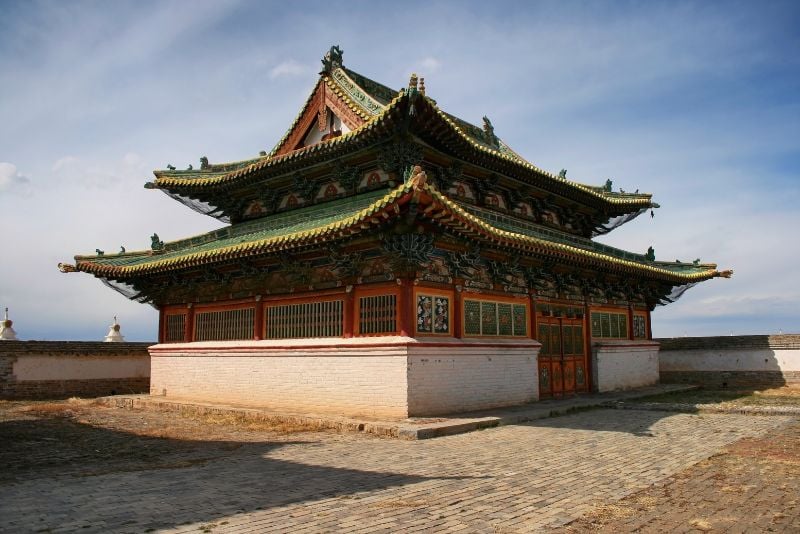
Established by Genghis Khan in 1220, Kharkhorin was once the ancient capital of the Mongol Empire, then known as Karakorum.
Strategically located along the Silk Road, it was a place of trade and cultural exchanges between East and West. Interestingly, even famed explorer Marco Polo visited !
While much of the city was destroyed and abandoned in the 14th century following the collapse of the Mongol Empire and subsequent invasions, today it remains a fascinating place to explore Mongolian history.
Here you can visit archaeological remains — including the remnants of the palace of Ogedei Khan — and visit the Kharakhorum Museum .
Another highlight is visiting the Erdene Zuu Monastery , which sits just outside the ruins. Built in the 16th century, it’s considered one of the oldest and most important monastic complexes in Mongolia.
16. Khögnö Khan Strictly Protected Area (Bulgan Province)
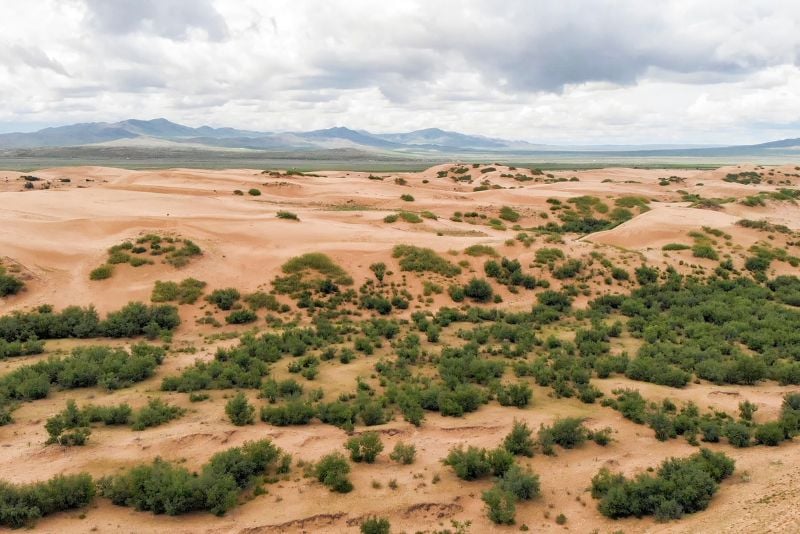
The Khögnö Khan Strictly Protected Area — sometimes also called Khögnö Khan Nature Reserve or Khögnö Khan National Park — is one of the top places of interest in Mongolia as it’s an important conservation area showcasing a variety of ecosystems and attractions.
Named after the park’s Khögnö Khan Mountain, you can explore mountain ranges, steppe grasslands, sand dunes, and rocky outcrops.
In terms of Mongolia sightseeing in the park, you’ll definitely want to visit the Elsen Tasarkhai Sand Dunes . These dunes stretch for 80 kilometers (50 miles) and are often referred to as the “Mini Gobi.”
It’s the perfect place for some sandboarding — one of the more unique things to do in Mongolia — and taking in a gorgeous sunset.
Other fun things to do in Mongolia in this park include hiking, horseback riding, camping, and trying to spot wildlife like argali sheep, Siberian ibex, and numerous bird species.
17. Altai Mountains (Bayan-Ölgii Province)
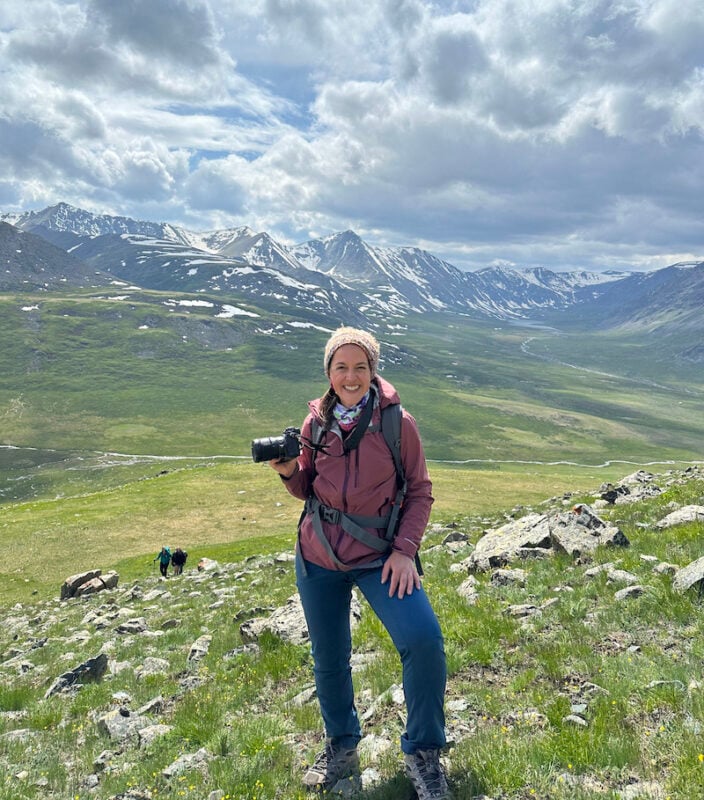
In my opinion, Mongolia’s Altai Mountains offer some of the most jaw-dropping scenery I’ve ever seen. Prepare to be wowed by the snowcapped peaks and colorful mountains that stretch dramatically toward the puffy clouds above. Crystal rivers cut through a landscape dotted with gers, livestock, and colorful wildflowers.
When visiting, you’ll fly into Ulgii (Ölgii) — the capital city of the Bayan-Ölgii Province in western Mongolia — to begin your exploration. Within this mountain-hugged city, you can enjoy hotels, restaurants, markets, and museums, though I highly recommend also driving out into the countryside.
One thing to realize is this area is predominantly inhabited by the nomadic Kazakh ethnic group. You’ll be able to immerse yourself in local Kazakh culture and partake in cultural activities by staying in a ger with a Kazakh family, witnessing eagle hunting demonstrations, experiencing Kazakh music, viewing local handicraft displays, and eating traditional Kazakh cuisine.
For example, when I stayed with a couple named Asker and Ahgul and their family, they hosted a big welcome feast. This included Beshbarmak, a Kazakh dish of boiled meat and noodles meant to be eaten with the hands.
The family also took me hiking to explore towering mountains, glacial lakes, and other gorgeous landscapes. In my opinion, the Altai Mountains are home to some of the most amazing hiking trails in the world !
Love festivals? Attend during the annual Golden Eagle Festival, of the top Mongolian festivals !
18. Altai Tavan Bogd National Park (Bayan-Ölgii Province)
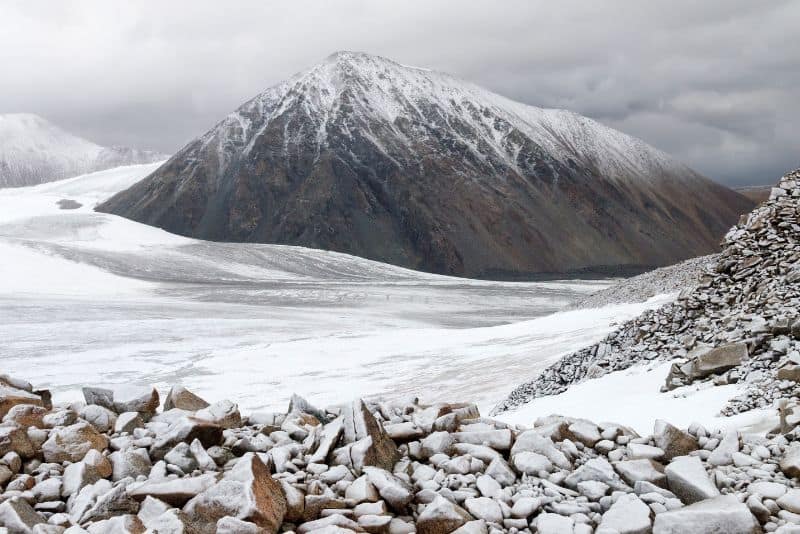
Building on things to see in Mongolia specifically in the Altai Mountains, Altai Tavan Bogd National Park is highly recommended.
Here you’ll find Mongolia’s highest peak, Khuiten Peak , as well as beautiful lakes, glaciers, and diverse wildlife. Actually, the park is home to the five highest peaks in Mongolia, which form a stunning natural backdrop for activities like hiking, rock climbing, fishing, and horseback riding.
Another attraction not to miss is Potanin Glacier , the largest glacier in Mongolia. This alongside other glaciers helps to contribute to the park’s stunning topography.
Love wildlife? Have your camera ready as you try to spot ibex, argali sheep, and snow leopards. The park is also a top location for bird-watching in Mongolia.
And for a bit of history, Altai Tavan Bogd National Park features ancient rock art, including petroglyphs (rock carvings) that depict scenes from ancient times.
Basically, this park has it all and is a must see in Mongolia, and it’s worth spending at least three nights here — more if you have the time!
Top Mongolia Tours
Along with the above-mentioned Mongolia tourist places, it’s recommended to book a few tours with a knowledgeable local guide. This can help you truly learn about the place you’re visiting and immerse yourself in the culture without having to worry about transportation.
A few top-rated Mongolia tours, each departing from Ulaanbaatar, include:
- 🐎 Genghis Khan Statue with Terelj National Park & Aryabal Temple
- 🥘 Cooking Class in a Traditional Ger Home in Ulaanbaatar Suburbs
- 🇲🇳 4-Day Essencence on Mongolia Tour
- 🛍️ Full-Day Tour of Ulaanbaatar with Museum & Black Market
- 🥾 Bogd Khan National Park Hiking Day Trip
👉 Click here for a full list of Mongolia tours .
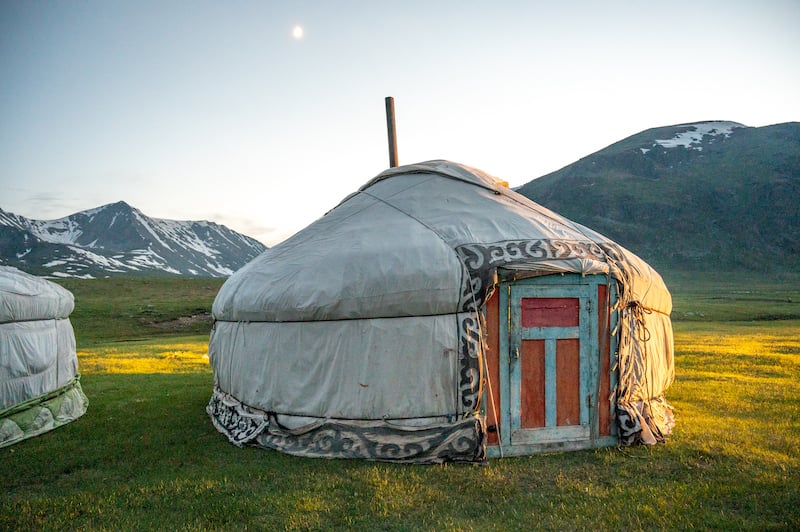
Mongolia Travel Tips
As you explore the best places to visit in Mongolia, make sure to keep the following advice in mind:
Work with a local tour operator. Many of the experiences mentioned above, such as staying with a local family in a ger, can be tricky to book on your own — not to mention navigating Mongolia’s roads is very challenging. Then once you’re there you’ll need someone to translate.
When I visited Mongolia, my experiences were booked through a local company called Eternal Landscapes . They were excellent!
Additionally, if you’re a woman who loves adventure, I highly recommend WHOA Travel ‘s Mongolia itinerary.
Visit Mongolia with a go-with-the-flow attitude. Things will not always go according to plan; but, remember that is all part of the adventure. Instead of getting frustrated, be grateful that you’re experiencing a place many don’t get the chance to.
Carry a lot of protein-rich snacks if you’re a vegetarian. Mongolians eat a very meat-heavy diet. As a vegetarian myself, it would have been nearly impossible to avoid meat had it not been for my local guides who helped prepare special meals for me.
If you don’t have a guide who can help, create a plan for how you’ll stay nourished, particularly outside of Ulaanbaatar where you’ll have a wide range of restaurants.
Adding on this, dairy is also a huge part of the Mongolian diet, so if you’re vegan you’ll need to plan for this as well.
Prep for long drives on bumpy roads. During my trip to Mongolia, there were many days where I spent over four hours in a car — and this typically isn’t on pavement.
Along with downloading audiobooks and podcasts to pass the time, consider how you might make the drive more comfortable, such as with cozy socks or a travel pillow. And if you get carsick you’ll absolutely want to have medication to help combat this.
Always drink the milk or milk tea offered by hosts. When doing a ger homestay, you’ll always be offered some type of warm milk or milk tea drink. This is a gesture meant to welcome and show respect to visitors, and it reflects their nomadic way of life where dairy products are essential and also symbolize abundance. It is rude to refuse it, so drink up.
Pack essential hygiene products. When doing a ger homestay, there isn’t typically a formal bathroom. Instead, you’ll be cleaning yourself up in your ger and going to the bathroom in a small shed with a hole in the ground. While I often found there was soap and water readily available outside, you’ll definitely want to bring toilet paper, hand sanitizer, and biodegradable baby wipes. I also suggest bringing self-care products that don’t require water, like biodegradable face wipes.
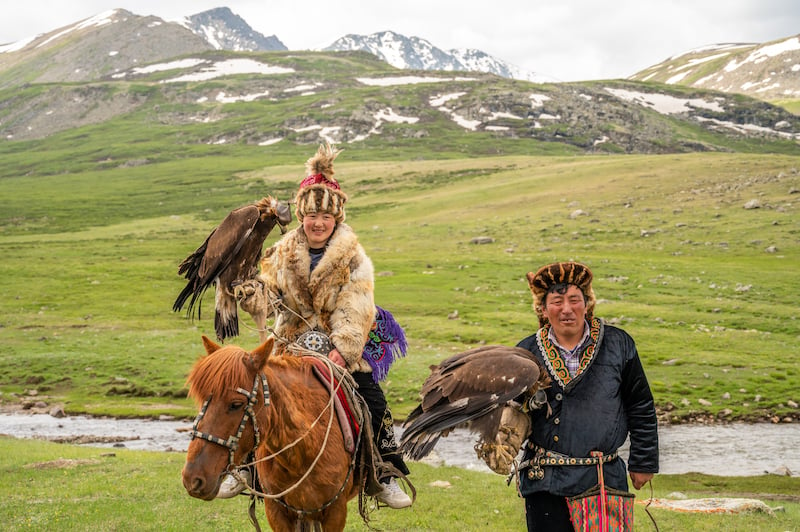
Best Places To Visit In Mongolia FAQ
Here are answers to frequently asked questions about visiting Mongolia:
Q) What is Mongolia best known for?
Mongolia is known for its diverse landscapes, nomadic culture, rich history — including Genghis Khan and the Mongol Empire — and world-renowned tourist attractions like the Gobi Desert.
Q) Is Mongolia safe?
According to Travel-Safe Abroad , the risk of being the victim of a violent crime in Mongolia is low. That being said, you should be careful of pickpockets and other scams in the capital city of Ulaanbaatar.
Q) Is Mongolia worth visiting?
Mongolia is absolutely worth visiting, particularly if you want to experience authentic culture and gorgeous landscapes. Because Mongolia is largely untouched by mass tourism, it can be both challenging and rewarding to travel through.
Q) Is Mongolia pretty?
Mongolia is home to an array of diverse landscapes that are striking and vast. It is truly stunning and you’ll definitely want to bring your camera. If you have a telephoto lens, you’ll also be able to capture epic shots of the local wildlife.
Q) Is Mongolia an expensive country?
While someone’s opinion on a country being cheap or expensive is relative, in general, Mongolia is considered a very budget-friendly country to travel through. Budget travelers can expect to spend around $30 to $50 per day, while mid-range travelers may spend approximately $70 to $100 per day.
Q) What is the best time to visit Mongolia ?
While you can visit Mongolia any time of year, summer (mid-June to late August) is typically considered the best time to visit. This is when you’ll experience warm temperatures and pleasant weather and can attend the famous Naadam Festival in July.
Mongolia Travel Insurance
When visiting Mongolia — or anywhere else in the world — it’s wise to get travel insurance.
One of the best travel medical insurance for travelers is SafetyWing as they’ve got a large network and offer both short-term and long-term coverage — including coverage if you’re traveling for months as well as limited coverage in your home country.
Additionally, SafetyWing is budget-friendly and offers $250,000 worth of coverage with just one low overall deductible of $250.
Click here to price out travel insurance for your trip in just a few clicks .
Final Thoughts On Visiting Mongolia
Mongolia is an incredible travel destination for those wanting to explore astounding natural beauty, rich history, and authentic culture.
And because the country hasn’t seen mass tourism, you’ll be able to enjoy your trip without crowds and in a very genuine way.
Adding the above-mentioned places to visit in Mongolia to your itinerary can also help ensure you see the best of the destination. Visiting just a few of these places will undoubtedly lead to an unforgettable trip!
What places to visit in Mongolia would you add to this list?
Related posts:.

Hi, I’m Jessie on a journey!
I'm a conscious solo traveler on a mission to take you beyond the guidebook to inspire you to live your best life through travel. Come join me!
Want to live your best life through travel?
Subscribe for FREE access to my library of fun blogging worksheets and learn how to get paid to travel more!

Turn Your Travel Blog Into A Profitable Business
Subscribe to my email list to snag instant access to my library of workbooks, checklists, tutorials and other resources to help you earn more money -- and have more fun -- blogging. Oh, and it's totally FREE! :) // Privacy Policy .
Check your inbox for your welcome email + resource library password!
Leave a Comment Cancel Reply

No videos yet!
Click on "Watch later" to put videos here
Mongolia Travel Guide – Everything You Need to Know

Nestled between Russia and China, Mongolia beckons adventurous travelers with its vast, untamed landscapes and nomadic heritage. Renowned for the legendary Genghis Khan and the vastness of the Mongolian steppe, this landlocked country offers a unique blend of ancient traditions and rugged natural beauty. From the serene expanse of the Gobi Desert to the dramatic peaks of the Altai Mountains, Mongolia is a haven for those seeking an escape into the wilderness. Nomadic hospitality, the vibrant Naadam Festival, and the timeless allure of the nomadic way of life make Mongolia a destination where history, culture, and the raw beauty of the great outdoors converge to create an unparalleled adventure.
What’s the Best Time to Visit? 📅
The best time to visit Mongolia as a tourist largely depends on your preferences for weather and the type of experiences you seek. Mongolia experiences a continental climate with distinct seasons. Here’s a breakdown of the seasons:
- Best Time for Travel: This is the peak tourist season when temperatures are milder, ranging from 20°C to 30°C (68°F to 86°F).
- Activities: Summer is ideal for outdoor activities, such as trekking, horseback riding, and attending festivals. The countryside is lush and vibrant during this time.
- Weather: The temperatures start to cool down, ranging from 10°C to 20°C (50°F to 68°F).
- Activities: Autumn offers beautiful landscapes with changing foliage. It’s a good time for trekking, and you can still experience the nomadic way of life.
- Weather: Winter is cold, with temperatures often dropping below freezing. In January, temperatures can reach -30°C (-22°F).
- Activities: Winter is suitable for those interested in experiencing Mongolia’s unique winter festivals, ice festivals, and winter sports. The landscapes are covered in snow.
- Weather: Spring sees a gradual warming, with temperatures ranging from -5°C to 15°C (23°F to 59°F).
- Activities: Spring is a transitional period, and it’s a good time for birdwatching and witnessing the renewal of the countryside. Nomadic families begin moving to their summer pastures.
Considerations:
- Mongolia’s climate can be extreme, so pack accordingly based on the season of your visit.
- The Naadam Festival in July is a major cultural event featuring traditional Mongolian sports, making it an exciting time to visit.
Ultimately, the best time to visit Mongolia depends on your interests. If you prefer milder temperatures and lush landscapes, summer is ideal. If you want to experience winter festivities and snowy landscapes, the winter months are suitable.
What’s the Best Way to Get Around? 🚌
Getting around Mongolia as a tourist requires planning, as the vast and diverse landscapes present various transportation challenges. Here are some ways to navigate the country:
- Advantages: Mongolia has domestic airports in major cities. Domestic flights are the quickest way to cover long distances.
- Considerations: Flights may be limited to certain regions, and schedules can be affected by weather conditions.
- Advantages: Joining an organized tour with a local guide and driver is a popular option. It provides access to remote areas and ensures a smooth journey.
- Considerations: Mongolia’s vastness makes overland travel time-consuming, but it allows you to experience the diverse landscapes and nomadic culture.
- Advantages: Buses connect major cities and towns. They are economical and offer a chance to interact with locals.
- Considerations: Schedules may not always be reliable, and routes can be limited, especially in rural areas.
- Advantages: Shared taxis and minivans operate on popular routes, providing flexibility and faster travel.
- Considerations: Availability may vary, and vehicles might not be as comfortable as private transportation.
- Advantages: Renting a car allows you to explore at your own pace, especially in more remote areas.
- Considerations: Mongolia’s road conditions can be challenging, and navigation might be difficult. Ensure your vehicle is suitable for off-road driving.
- Advantages: For the adventurous, exploring Mongolia on a motorcycle or bicycle can be a rewarding experience.
- Considerations: Conditions may be tough, and it’s essential to be well-prepared with suitable equipment and navigation tools.
- Advantages: In certain regions, especially the Gobi Desert, camel or horse trekking offers a unique way to experience the landscape.
- Considerations: This is more of an activity than a primary means of transportation, and it requires proper planning.
- Advantages: In extremely remote areas, local airlines and charter flights may be available.
- Considerations: These services may be expensive and are subject to weather conditions.
When planning transportation in Mongolia, it’s crucial to consider the distances, weather conditions, and the level of adventure you seek. Many travelers opt for a combination of transportation modes depending on the regions they wish to explore.
Where to Stay? 🏨
In Mongolia, as a tourist, you can find accommodation options ranging from traditional nomadic ger camps to modern hotels in urban areas. Here are some suggestions on where to stay in Mongolia:
- Hotels: The capital city, Ulaanbaatar, offers a range of hotels catering to various budgets. You can find international hotel chains, boutique hotels, and guesthouses.
- Ger Camps: Some ger camps are located on the outskirts of Ulaanbaatar, providing a unique experience of staying in traditional Mongolian gers while still having access to the city.
- Traditional Gers: Experience traditional Mongolian nomadic life by staying in gers in the countryside. Ger camps are often set in picturesque locations, providing an authentic cultural experience.
- Tented Camps: In more remote areas, tented camps may be available for those seeking a closer connection to nature.
- Eco-Camps: In national parks and natural reserves, you may find eco-camps that offer comfortable accommodations with minimal environmental impact.
- Community-Based Tourism: In some areas, community-based tourism initiatives offer guesthouse stays, providing an opportunity to interact with local communities.
- Ger Camps and Homestays: In the western part of Mongolia, known for its Kazakh culture and stunning landscapes, you can find ger camps and homestays.
- Ger Camps: Explore the vast Gobi Desert by staying in ger camps that offer a blend of comfort and a taste of nomadic life.
- Lakeside Camps: Enjoy the pristine beauty of Khuvsgul Lake by staying in camps along its shores, offering tranquility and breathtaking views.
When choosing accommodation, consider the type of experience you seek, whether it’s a more urban stay in Ulaanbaatar, an immersion into nomadic life in the countryside, or a combination of both. It’s advisable to book accommodations in advance, especially during peak tourist seasons.
What to Eat? 🍽️
Mongolian cuisine reflects the nomadic lifestyle and the harsh climate of the region. Here are some must-try foods in Mongolia:
- Description: Buuz are traditional Mongolian dumplings filled with minced meat (usually beef or mutton) and sometimes onions. They are typically steamed.
- Experience: Buuz are a staple during Mongolian holidays and celebrations, and trying them offers a taste of authentic Mongolian comfort food.
- Description: Khorkhog is a traditional Mongolian barbecue. It involves cooking meat (often lamb or goat) with vegetables and stones heated over an open fire.
- Experience: Khorkhog is not only delicious but also a cultural experience, as the cooking method is unique to Mongolia.
- Description: Khuushuur are deep-fried pastries filled with minced meat, typically beef or mutton, and sometimes onions.
- Experience: Often enjoyed during festivals and gatherings, khuushuur are a savory treat with a crispy exterior and flavorful filling.
- Description: Airag is fermented mare’s milk, a traditional Mongolian beverage. It has a slightly sour taste and a low alcohol content.
- Experience: Trying airag provides a glimpse into the nomadic way of life, as it has been a traditional drink among Mongolian herders for centuries.
- Description: Tsagaan idee, or “white food,” refers to dairy products like aaruul (dried curds), cheese, and yogurt.
- Experience: Dairy products play a significant role in Mongolian cuisine, and tasting various forms of tsagaan idee is a must.
- Description: Boodog is a unique Mongolian dish where meat, usually marmot or goat, is cooked inside the animal’s skin, along with hot stones, over an open flame.
- Experience: Boodog is not only a culinary experience but also a cultural one, showcasing traditional nomadic cooking methods.
- Description: Tsuivan is a noodle dish made with stir-fried meat (often beef or mutton), vegetables, and handmade noodles.
- Experience: Tsuivan is a hearty and satisfying dish, commonly enjoyed in both rural and urban settings.
Trying these dishes will give you a taste of Mongolia’s rich culinary heritage and the nomadic traditions that influence its cuisine.
What to See? 🔍
Mongolia is a vast and diverse country with stunning landscapes and a rich cultural heritage. Here are some must-see places for tourists in Mongolia:
- Description: Explore the vast and unique landscapes of the Gobi Desert, known for its towering sand dunes, rocky canyons, and diverse wildlife.
- Highlights: Khongoryn Els sand dunes, Flaming Cliffs (Bayanzag), Yolyn Am (Ice Valley), and the stunning landscapes of the Gobi.
- Description: Khuvsgul Lake, located in the northern part of the country, is one of the largest and deepest freshwater lakes in Central Asia.
- Highlights: Pristine waters, picturesque landscapes, and opportunities for hiking, horseback riding, and cultural experiences with the local Tsaatan people.
- Description: Terelj National Park, located close to Ulaanbaatar, offers a mix of natural beauty and cultural attractions.
- Highlights: Turtle Rock, Aryabal Meditation Temple, and opportunities for outdoor activities such as hiking, horseback riding, and visiting nomadic families.
- Description: Karakorum was the capital of the Mongol Empire, and Erdene Zuu Monastery, built in 1586, is one of the oldest and most significant monasteries in Mongolia.
- Highlights: Historical artifacts, religious art, and the unique blend of Buddhist and shamanistic influences.
- Description: Hustai National Park is known for its successful reintroduction of the Przewalski’s horse, an endangered wild horse native to the steppes of Central Asia.
- Highlights: Opportunities to see the Przewalski’s horse in its natural habitat, as well as other wildlife such as marmots and red deer.
- Description: The Orkhon Valley, a UNESCO World Heritage Site, is known for its historical and cultural significance, including ancient archaeological sites and nomadic traditions.
- Highlights: Tuvkhun Monastery, Kharkhorin (Karakorum), and the scenic Orkhon River Valley.
- Description: Located in the far west of Mongolia, Altai Tavan Bogd National Park features diverse landscapes, including high mountains, glaciers, and alpine lakes.
- Highlights: The Five Holy Peaks, Potanin Glacier, and opportunities for trekking and mountaineering.
- Description: Khustai National Park is known for its successful reintroduction of the wild Przewalski’s horse, an endangered species.
- Highlights: The chance to see Przewalski’s horses, as well as other wildlife such as marmots and red deer, in their natural habitat.
These are just a few examples of the breathtaking and culturally rich destinations Mongolia has to offer. Whether you’re interested in history, nature, or nomadic culture, Mongolia has something to captivate every traveler.
What to Do? 📸
Mongolia offers a wide range of unique experiences for tourists, allowing them to immerse themselves in the country’s nomadic culture, stunning landscapes, and rich history. Here are some must-do things for tourists in Mongolia:
- Description: Stay with a nomadic family in a traditional ger (yurt) and experience the nomadic way of life. Participate in daily activities like herding animals, milking livestock, and learning traditional crafts.
- Description: Mongolia is known for its small but sturdy horses. Take the opportunity to go horseback riding in the vast steppes, experiencing the nomadic lifestyle from a different perspective.
- Description: Naadam is Mongolia’s traditional “Three Manly Games” festival, featuring wrestling, horse racing, and archery. Attend this lively event, usually held in July, for a taste of Mongolian sports and culture.
- Description: Visit the capital city of Ulaanbaatar to explore museums, historic sites, and vibrant markets. Don’t miss the Gandan Monastery, the National Museum of Mongolia, and the Sukhbaatar Square.
- Description: Explore Gandan Monastery in Ulaanbaatar, one of the most important Buddhist monasteries in Mongolia. Witness religious ceremonies and view the impressive Migjid Janraisig statue.
- Description: Head to Terelj National Park for hiking adventures with stunning views. Visit iconic landmarks like Turtle Rock and Aryabal Meditation Temple while enjoying the natural beauty.
- Description: Visit the UNESCO-listed petroglyphs in the Gobi Desert or the Bayanzag area to see ancient rock carvings depicting scenes from daily life, animals, and rituals.
- Description: In the Altai Mountains, witness the ancient art of eagle hunting practiced by the Kazakh nomads. Local eagle hunters showcase their skills, and visitors may have the chance to interact with these majestic birds.
- Description: Explore the ancient capital of the Mongol Empire at Karakorum and visit Erdene Zuu Monastery, surrounded by impressive walls with 108 stupas.
- Description: Visit the Genghis Khan Statue Complex, featuring a colossal statue of Genghis Khan on horseback. Climb to the top for panoramic views of the surrounding landscapes.
- Description: Experience camel trekking in the Gobi Desert, where you can explore the vast landscapes and sand dunes, especially at Khongoryn Els.
- Description: Enjoy traditional Mongolian performances featuring throat singing, traditional music, and dance. Many cultural shows are held in Ulaanbaatar.
These activities provide a diverse and immersive experience, allowing tourists to appreciate Mongolia’s unique blend of history, culture, and natural beauty.
Culture and Safety 🦺
Culture in mongolia:.
1. Nomadic Heritage:
- Nomadic Lifestyle: Mongolia has a strong nomadic culture, and many people still live in traditional gers (yurts) and follow a pastoral way of life.
- Hospitality: Nomadic families are known for their warm hospitality. It’s common for visitors to be offered traditional dairy products, such as airag (fermented mare’s milk) and kumis.
2. Religion:
- Buddhism and Shamanism: Buddhism, particularly Tibetan Buddhism, has deep roots in Mongolia. Shamanistic practices are also prevalent, and you may encounter ceremonies and rituals during your travels.
3. Naadam Festival:
- Traditional Sports: The Naadam Festival, held annually in July, showcases Mongolia’s “Three Manly Games”: wrestling, horse racing, and archery. Attending Naadam provides insight into traditional sports and cultural festivities.
4. Language:
- Mongolian Language: The official language is Mongolian, written in the Cyrillic script. While English is not widely spoken in rural areas, you’ll find more English speakers in urban centers.
Safety in Mongolia:
1. Nomadic Hospitality:
- Safe Environment: Mongolia is generally considered safe for travelers. Nomadic communities are welcoming and accustomed to hosting visitors.
2. Health and Hygiene:
- Medical Facilities: Medical facilities may be limited, especially in rural areas. Ensure you have travel insurance and take necessary health precautions, including vaccinations.
3. Transportation:
- Road Conditions: In rural areas, roads may be challenging, and weather conditions can impact travel. Choose reliable transportation options and be prepared for varying road conditions.
4. Altitude Considerations:
- High Altitudes: Certain areas, such as the Altai Mountains, have high altitudes. Take time to acclimatize and stay hydrated.
5. Weather Extremes:
- Varied Climates: Mongolia experiences extreme temperatures. Be prepared for cold winters and hot summers, and pack accordingly.
6. Wildlife Awareness:
- Wildlife Encounters: Mongolia is home to diverse wildlife. While encounters are rare, be aware of your surroundings, especially in more remote areas.
7. Nomadic Etiquette:
- Respect Local Customs: Respect nomadic customs and seek permission before entering ger camps. It’s customary to offer a friendly greeting by saying “Sain bainuu?” (Are you well?).
8. Personal Safety:
- Personal Belongings: Exercise standard precautions for personal safety. Keep valuables secure and be aware of your surroundings.
9. Traveling in Groups:
- Group Travel: Traveling with a guide or in a group can enhance safety, especially in remote regions.
10. Emergency Preparedness: – Emergency Contacts: Familiarize yourself with emergency contact information and know the location of the nearest embassy or consulate.
By respecting local customs, staying informed, and being prepared for the unique aspects of Mongolia’s nomadic culture and environment, travelers can have a safe and enriching experience in this vast and captivating country.
In conclusion, Mongolia offers a captivating blend of nomadic heritage, breathtaking landscapes, and unique cultural experiences for travelers. From the vast steppes to the Gobi Desert, visitors can immerse themselves in the nomadic lifestyle, witness traditional sports at the Naadam Festival, and explore ancient monasteries and historic sites. The warmth of nomadic hospitality, coupled with the thrill of horseback riding, camel treks, and encounters with diverse wildlife, creates a memorable adventure. Travelers are encouraged to embrace the rich culture, respect local customs, and navigate the country’s safety considerations to make the most of their journey through this unique and hospitable land.
You may also like

State of Palestine Travel Guide – Everything You Need to Know

South Sudan Travel Guide – Everything You Need to Know

Democratic Republic of the Congo Travel Guide – Everything You Need to Know
Travel destinations.
- Experiencing Australia 20
- Experiencing Cambodia 5
- Experiencing China 24
- Experiencing Cruise 6
- Experiencing France 5
- Experiencing Germany 3
- Experiencing Indonesia 10
- Experiencing Italy 11
- Experiencing Japan 10
- Experiencing Korea 7
- Experiencing Malaysia 6
- Experiencing Maldives 7
- Experiencing Myanmar 10
- Experiencing New Zealand 17
- Experiencing Singapore 15
- Experiencing Switzerland 4
- Experiencing Taiwan 14
- Experiencing Thailand 18
- Experiencing Vietnam 5
Service We Offer
Our services.
The Mongolian Tourism Association (MTA) plays an important role in the promotion of Mongolia as a travel destination on both the international market and domestic market. Its activities include the development of new marketing strategies and concepts based on specific themes, events, and attractions. The MTA also brings together and optimizes the diverse marketing activities of partners in the Mongolian travel industry.
Tourism Opportunities in Mongolia
Tourism attractions /cultural, environmental, social/, events and festivals, facts and statistics, facilities and services for business visitors, discounted training opportunities for staff, annual “tourism cup” sports competition, international tourism fair and exhibition organization and assistance, educational and promotional materials, social media networking, www.travelmongolia.org official website providing mta activities and mongolian tourism, voting rights in annual meetings and ability to serve on mta board of directors, direct marketing of member services and advise on website brochures, itineraries and various advertising methods, use mta logo exhibition stand rentals.
- About association
- Greeting of the President
- Board Members
- Annual meetings
- Ideology of the MTA
- Exhibitions
- Other events & Activities
- BRANCHES & COUNCILS
Office address:
- 313, 3rd Floor, Tuushin Building Ulaanbaatar, Mongolia
- [email protected]
- +976-99072779
Social List

Borders Of Adventure
Leading Culture and Adventure Travel Blog by Becki Enright. Looking at the world with a different angle to change perceptions of misunderstood places, for the best in travel.
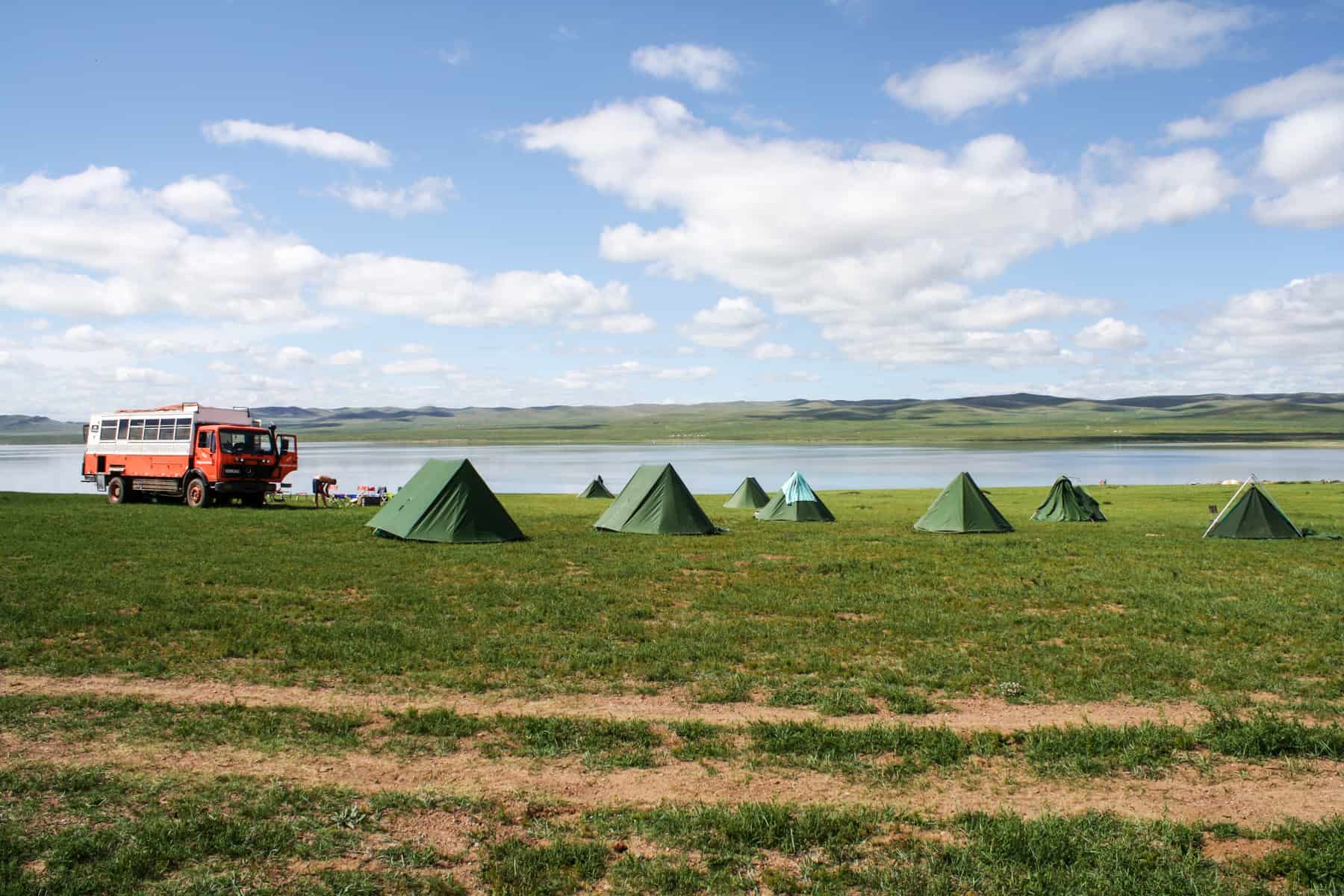
Adventure Travel , Mongolia
This is How to Travel to Mongolia – Overlanding the Least Densely Populated Country in the World
Disclaimer: This post contains affiliate links to handpicked partners, including tours, gear and booking sites. If you click through or buy something via one of them, I may receive a small commission. This is at no extra cost to you and allows this site to keep running.
Want to get to somewhere lesser-known and travel differently? This Mongolia travel guide shows how to go overlanding in the world’s least densely populated country.
Travel to Mongolia means tackling a land of extremes. Both in the landscape, from its vast desert lands and towering dunes to its lush green mountainous national parks, and in its lack of infrastructure, where you become just as frustrated as you are in awe by the country’s areas of extreme isolation.
Visiting Mongolia is to find a canvas of rugged beauty capped by a sky so blue that pollution isn’t even a word that exists here. Passing only wild horses, herds of cattle, an isolated ger in the distance, and the odd truck also on its way to the city, life here is at its purest and most beautiful.
Outside of its unkempt capital, Ulaanbaatar, Mongolia exists with limited facilities, but that’s what makes it attractive. On the road, it can take hours of driving before you pass a small ger community, a Mongolian on horseback or another vehicle, and in between blessed with the most stunning views of a country so desolate that you know you’ve reached the real heart of it.
Overlanding through Mongolia, rather than flying or taking the train, is one of the best decisions I have ever made. This guide will show you how to travel Mongolia from China by land, in a vast loop that takes in some of the country’s most treasured hotspots and wilderness hideaways.
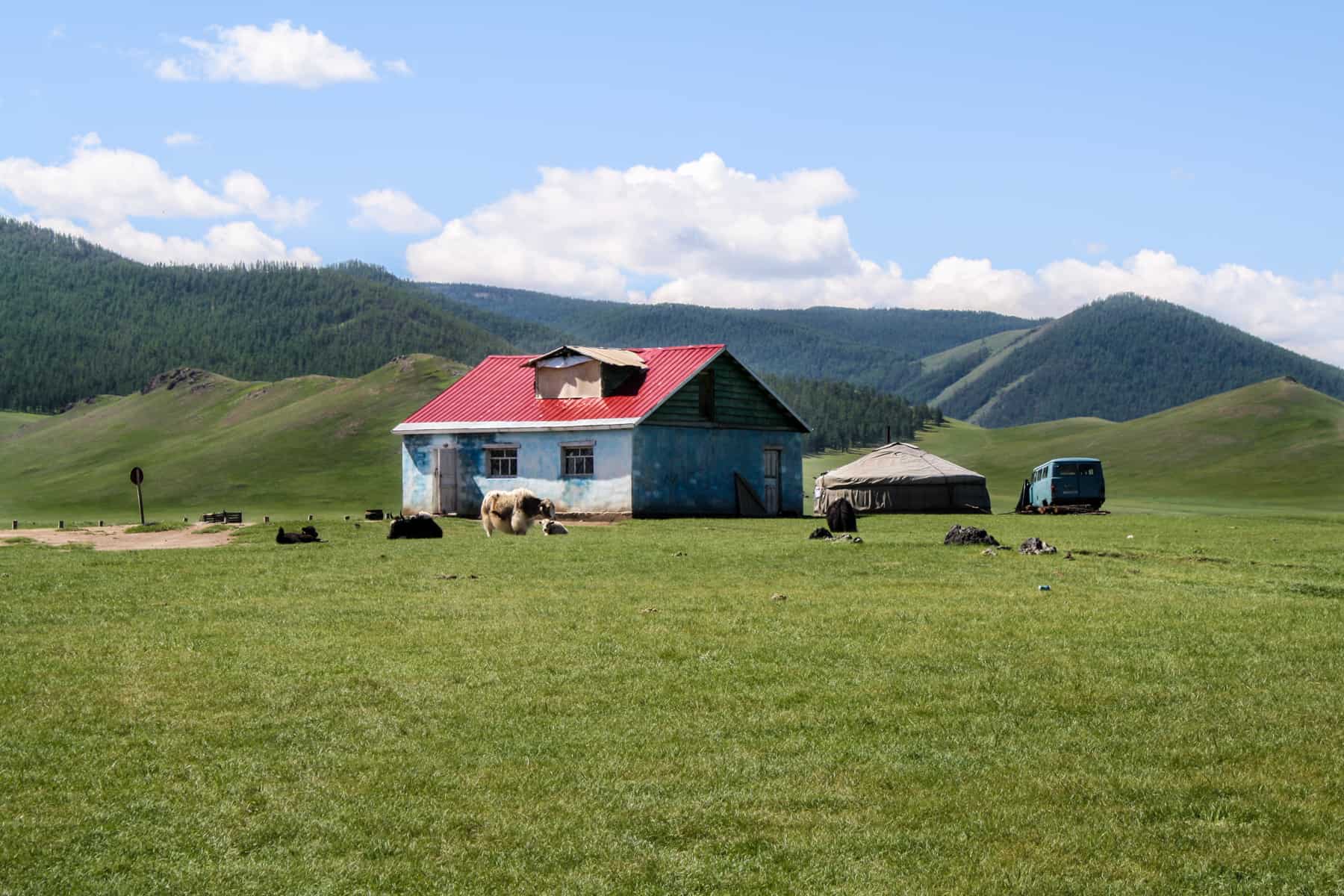
Visit the Least Densely Populated Country in the World
Off the beaten track adventure, when is the best time to go to mongolia, it pays to know a local, classic nomadic mongolia, local living mongolia, discover mongolia – national geographic journeys, experience the naadam festival in mongolia, is mongolia expensive to travel, mongolia visa on arrival, visa-free access to mongolia, day 1: visiting ulaanbaatar, day 2: getting from ulaanbaatar to the gobi desert, day 3: visit the baga gazryn chuluu rock formations, day 4: sleep at a ger camp in the gobi desert, day 5: dalanzagad to gobi discovery ger camp, day 6: hiking in yolin am – mongolia’s ice valley, day 7: a trip to the gobi desert khongoryn els sand dunes, day 8: visiting the bayanzag flaming cliffs, day 9: seeing ongii monastery and driving to arvaikhee, day 10: stuck in mongolia, day 11: hiking in orkhon valley, day 12: seeing the orkhon valley waterfalls, day 13: visiting a mongolian family in a ger, day 14: erdene zuu monastery in kharkhorin, day 15: camping at ugii lake, day 16: visiting hustain national park and seeing przewalski’s horses, day 17: driving to ulaanbaatar and visiting terelj national park, day 18: hiking terelj national park and seeing turtle rock, day 19: a trip to the ghengis khan statue on the tuul river, day 20: back to ulaanbaatar, how to overland in mongolia, building a road in mongolia, getting stuck in the mud, the unexpected river crossing, what to pack for mongolia, planning mongolia travel pin it, why travel to mongolia .
Mongolia travel changes you and makes you appreciate the beautiful patches on the earth’s surface not ruined by extreme modernisation, pollution and overpopulation.
My time in Mongolia meant experiencing everything from bush camping to ger camps, being at one with nature (and not care who sees you squatting in the process) and realising that animals like to roam and Mongolians love to chat – right outside your Ger from 5 am.
I saw a night sky so clear that I didn’t think you could ever see so many stars. I traversed a land so serene in isolation and culture so welcoming that I hope it never, ever becomes ruined by tourist traps or the tight grips of mass capitalism (currently contained to Ulaanbaatar).
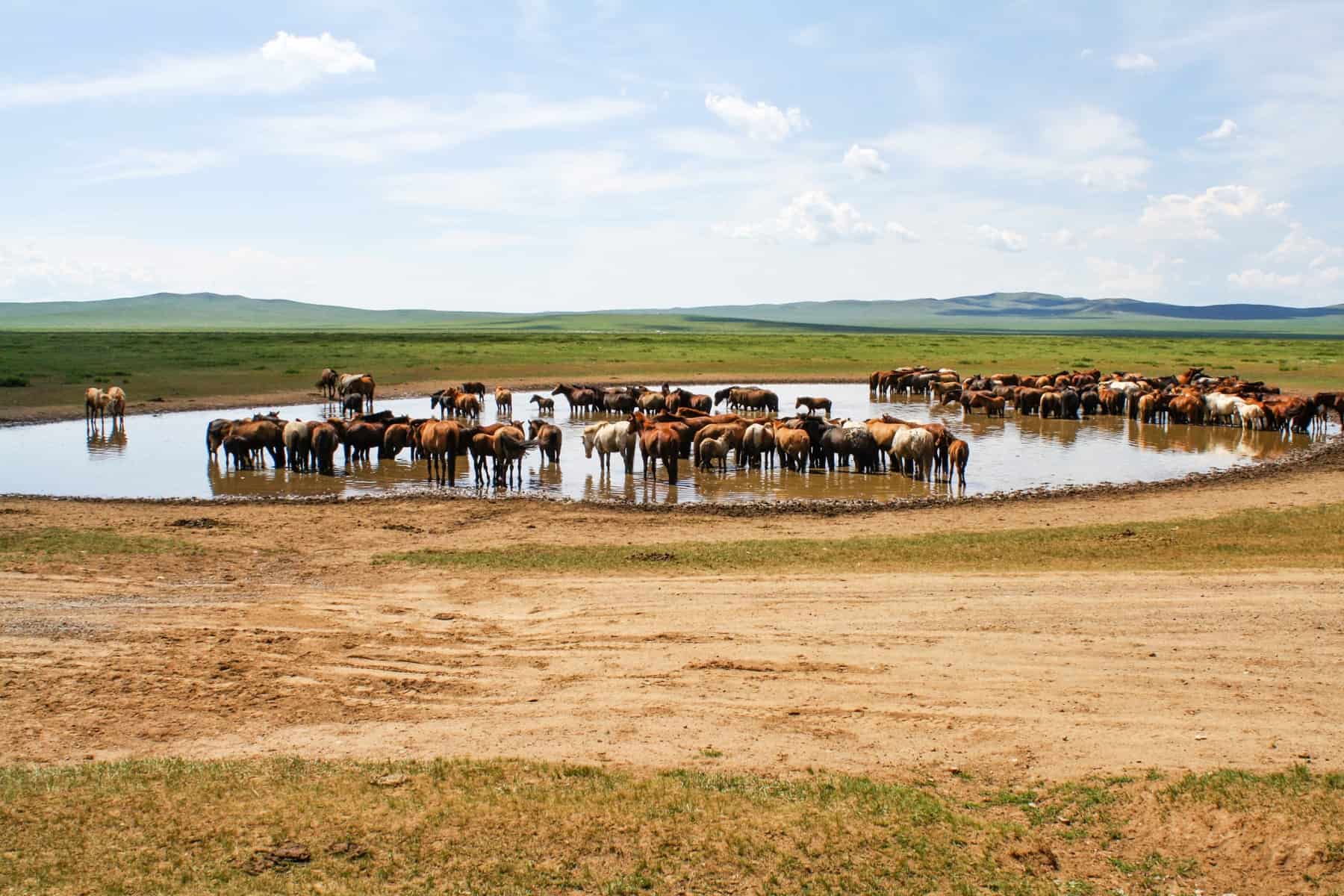
Wild horses in the vast Mongolian landscape
If you want to get off the beaten track, not be on any set grid and take each day as it comes, you will love Mongolia. But this also comes with its frustrations where you need droves of patience and a good chunk of travel time to spare.
There are hardly any roads. Roads are dirt tracks or pre-made grooves in the land pointing the way, and paved highroads are very few and far between.
Mongolia is prone to unpredictable weather conditions. That means random onslaughts of rain and the likelihood that you are likely to get bogged at some point. There were countless numbers of times where we had to dig out and push the truck or find locals to come to the rescue – tractors are a saving grace here.
It’s a vast country that you could get lost in for weeks on end, and when you accept the setbacks, you start to see them as part of the big adventure – travel at its most raw. Back to basics, getting dirty and struggling with the lack of modern amenities we too often take for granted is part of what travelling in Mongolia is all about.
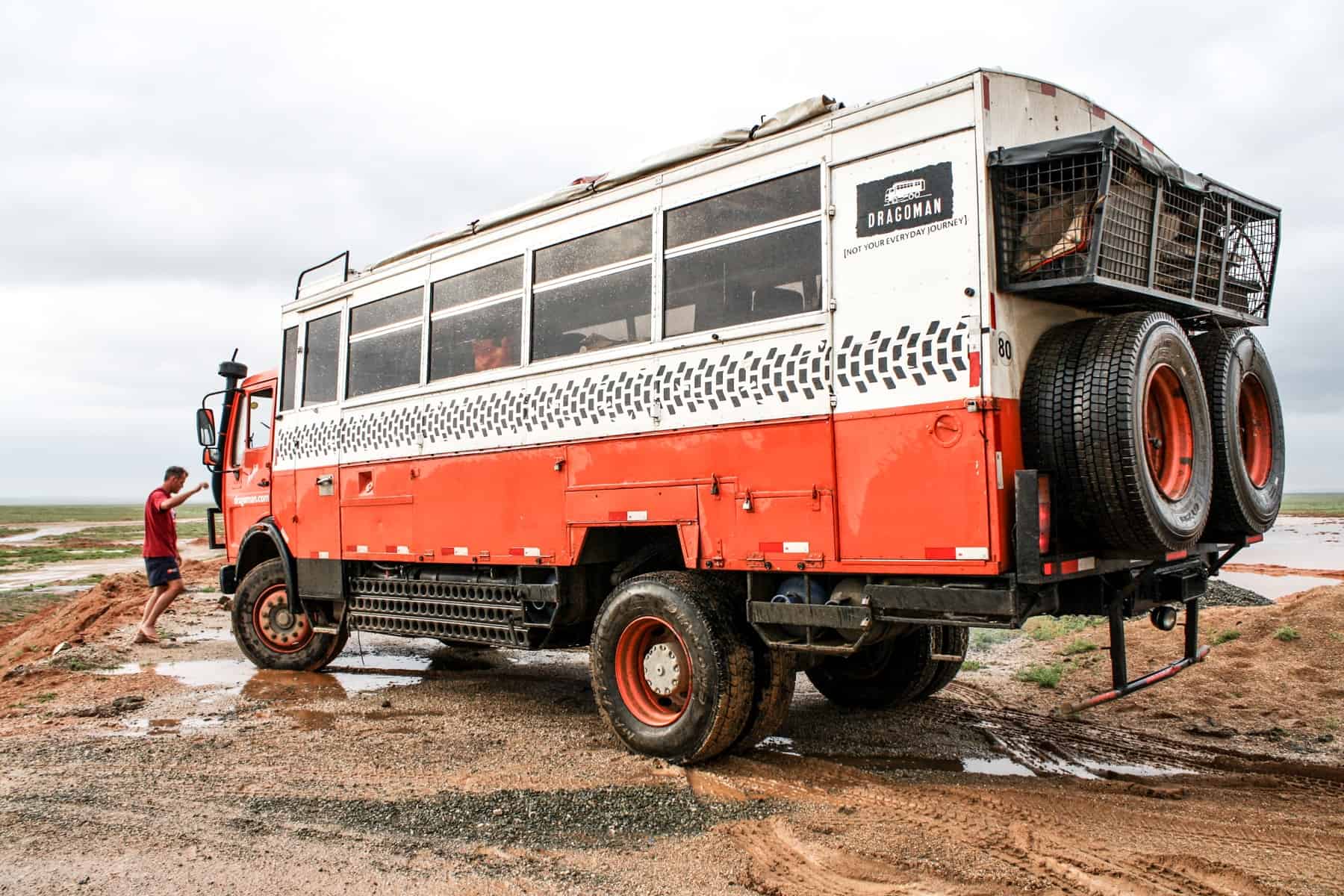
The Overlanding vehicle used to travel to Mongolia and around.
The summer season between May to September is said to be the best time to go to Mongolia. July and August are the hottest months, with temperatures in the Gobi Desert reaching 40°C. Rainfall is at its highest between June and September, balancing out the heat while keeping the forest and valley lands, in particular, lush and fertile. I travelled to Mongolia in July and experienced a lot of rainfall alongside high temperatures.
Mongolia’s winter season is from November to February. While some people like to experience the landscape in this snowy season, temperatures can drop to below minus 20°C – a harsh and challenging environment to travel in. You’ll find that not many companies run tours during this time.
Is it Safe to Travel to Mongolia Safe?
While petty crime and pickpocketing are common in the capital, Ulaanbataar, Mongolia is a relatively safe place to travel, and I never encountered any significant problems. It pays to be more streetwise and alert in the city, as you would in any other. As the landing and departure point for tourists, opportunism poses a higher risk.
Despite the lack of infrastructure and the relative isolation when travelling through the country, the only minor issue we encountered was related to the high levels of alcoholism in the country. We saw drunk drivers on our long drives and an occasion or two when inebriated locals came to our makeshift camp out of curiosity. Even then, it never felt threatening, and we were always within the safety of our group.
On the whole, we rarely saw other people, and when we did, we were met with kindness, invited into homes and welcomed into common spaces such as markets and small-town social spaces.
I also travelled alongside a Mongolian guide – someone who could speak the language when we got stuck, who could walk to a nearby home and explain the need for assistance and who understood the land’s general navigation. Therefore, in Mongolia, it pays to get yourself a local guide, join a small group tour, formulate a small group of your own in Ulaanbataar or be equipped with general wilderness survival skills if going out there entirely on your own.
Mongolia Tours
When I was planning my trip to Mongolia, Dragoman was the only company offering Mongolia tours that lasted from ten days to two weeks. The 21-day overland journey was the first trip itinerary of its kind they were running here, which included Inner Mongolia. Today the 21-day trip, called Nomads & Wilds of Mongolia, is on a loop from Ulaanbaatar and includes Khovsgol Lake in the north. Although Dragoman suspended operations during the pandemic, they are back in 2024.
Adventure travel experts G Adventures, offer Mongolia tours that all start and end in Ulaanbaatar.
A 14-day trip, including all the highlights at an affordable price (from €1999), this Mongolia trip includes a Gobi Desert and Mongolian Grasslands stay, alongside packing in the major historical must-sees and cultural experiences that make Mongolia an unforgettable adventure.
This 10-day local living trip includes staying with three different families in Gers to experience life as a nomad. Mix historical monuments with cultural moments, exploring pastures, forests, lakes and national parks by foot and horseback while helping your host families prepare traditional dinners and learn the skills of their nomadic trades.
G Adventures, in partnership with National Geographic Journeys, offers a two-week comfort adventure through Mongolia . You get to visit Khustai National Park, Karakorum (the ancient capital of Mongolia), Tsenkher Hot Springs, the Orkhon Valley and more. You will also see a nomadic camel-herding family and dive deeper into Mongolia’s culture, as well as support the local community where tourists pass through.
Want to experience the Naadam Festival’s horseracing, archery and wrestling tournaments? This mini adventure takes you to it and throws you right into the buzz of traditional Mongolian festivities.
Mongolia is expensive to travel in and around due to the very nature that it is not overly touristic. Due to the lack of infrastructure, a tour with a local guide and appropriate transport can often be necessary to cover more ground.
- You will need to budget between $2400-$3600 for an extensive trip around the country.
- An average meal (if not making your own on the trip) costs around $5.
- Entrance fees to historic sites and museums average around $2 per ticket.
For those on a budget, day trips can be taken from Ulaanbaatar, or you can try and plan some shorter 3-5 day trips from the city. However, this can often depend on having a minimum amount of people signed up for the trip to run and isn’t always guaranteed.
Do you need a Visa for Mongolia?
If you are not a national of one of the visa-exempt countries listed below, you will need a Mongolia visa.
- A single-entry visa (valid for three months from the date of issue) for up to 30 days – £40/$50
- A double-entry visa (valid for three months from the date of issue) for up to 30 days – £55/$65
It is cheaper to apply directly at a Mongolian Embassy (either at home before you leave or in the country you are travelling in prior). You will need a valid passport, passport photos and supporting trip documents alongside a completed application.
Allow one working week for processing. Some Embassies provide a one-day service for an extra charge.
A 30-day tourist visa on arrival is available for tourists coming from European and other countries where there are no Mongolian Embassies present, obtained at Ulanbataar Airport or the Mongolian land borders. I got my visa in London months before my trip.
The following countries are granted visa-free entry to Mongolia.
Visa-free entry for 90 days: Argentina, Belarus, Brazil, Chile, Kazakhstan, Kyrgyzstan, Serbia, United States (US). Those from Ukraine require a form of invitation.
Visa-free entry for 30 days: Canada, Cuba, Germany, Israel, Japan, Laos, Malaysia, Russia, Singapore, Turkey, Thailand, Uruguay.
Visa-free entry for 21 days: Philippines.
Visa-free entry for 14 days: Hong Kong.
You can find further information on the Embassy of Mongolia website .

Where to Go in Mongolia – Itinerary
I spent 20 days Overlanding in and across the central and western Mongolian plains. We travelled in a big clockwise circle from Ulaanbaatar, through the scorching Gobi Desert to beautiful lakes, forests, canyons and waterfalls, all the while passing vast herds of wild horses, camels, goats, yaks and cows.
Overlanding in Mongolia for Three Weeks:
Kilometres travelled: 2492
Number of significant times the truck got stuck: 2
Number of minor times the truck got stuck: 12
Number of incredible driving days: 15
We spent a full day in Ulaanbaatar exploring outside of the stark Soviet communist-style architecture and moving past the city’s general dodgy feeling. There’s plenty to see and do here, including a walk through the modern Sukhbaatar (Parliament) Square, the Gandan Monastery, the National History Museum and the shopping paradise of the Black Market . In the evening, check out the singing, dancing and contortion talent at the Cultural Show before hitting a few bars and pubs. There’s so many you won’t know where to start.
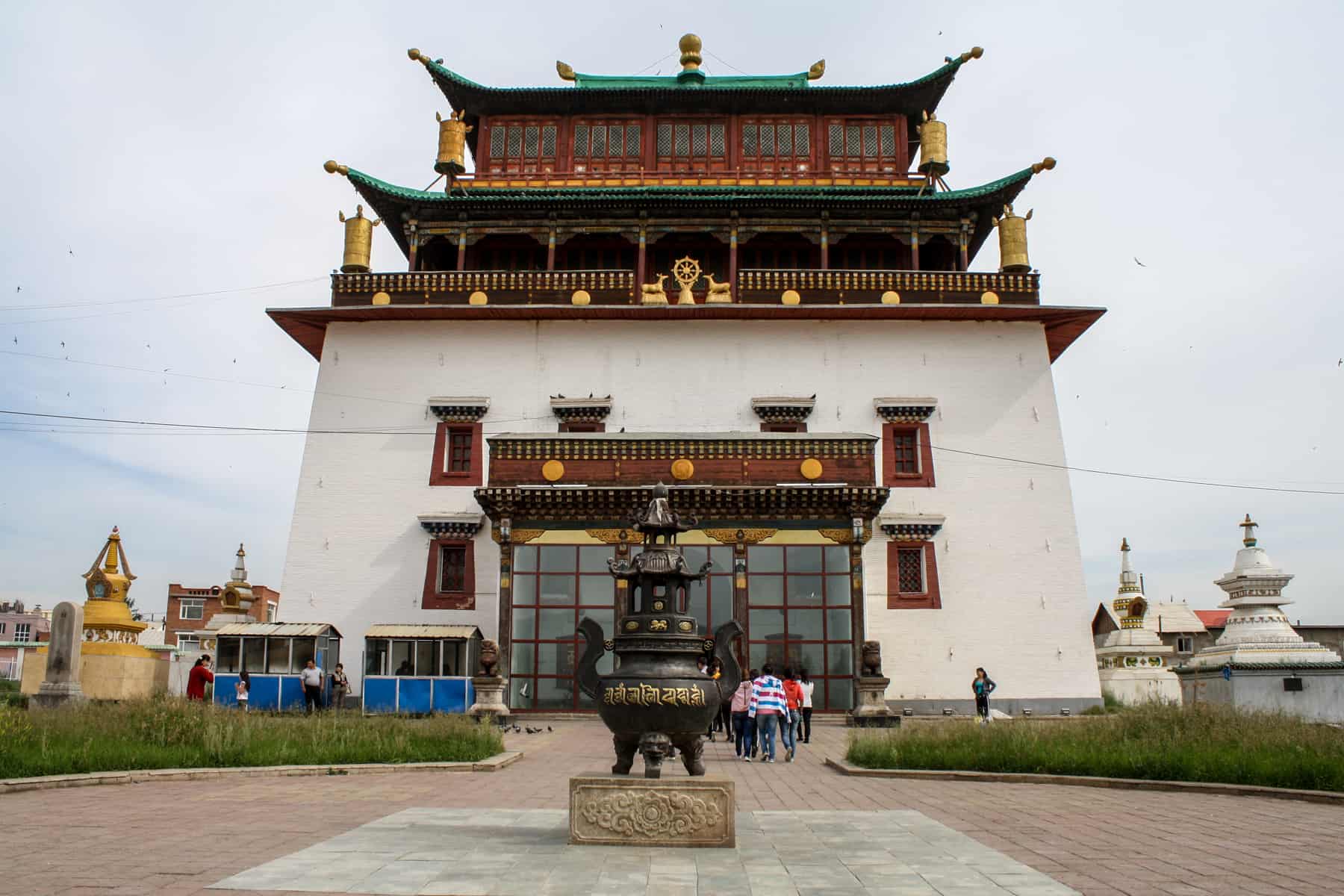
Gandan Monastery in Ulaanbaatar, Mongolia
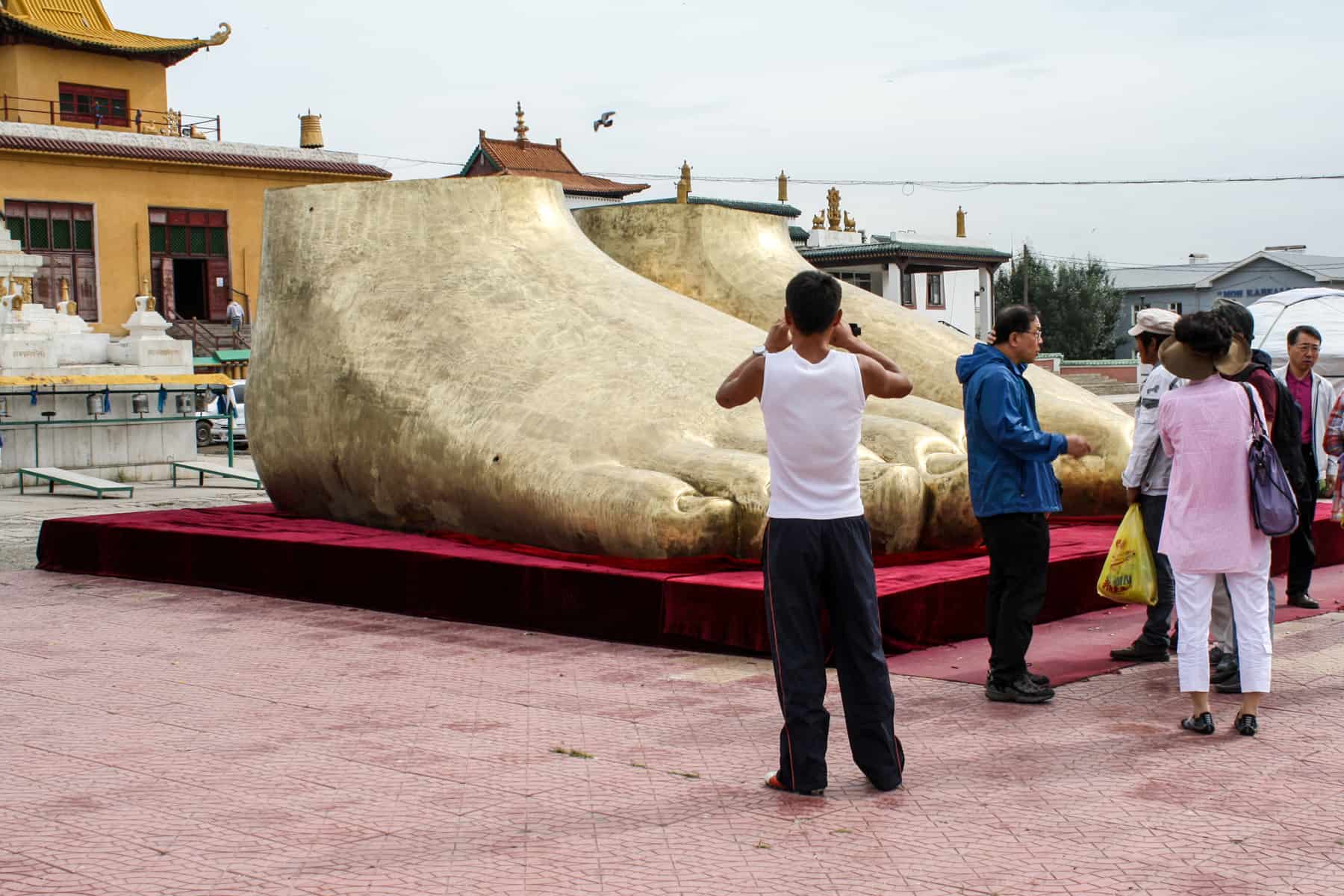
The golden feet outside the Gandan Monastery Ulaanbaatar
We set off in the truck from Ulaanbaatar to drive to the Baga Gazryn Chuluu rock formations in the Gobi desert. Due to heavy traffic when getting out of the city and general road conditions we got delayed and so decided to set up bush camp for the evening. Be prepared for delays in Mongolia but delight in being the only people in the area. All the space is yours.
We got to Baga Gazryn Chuluu – rock formations worshipped by locals who make pilgrimages here partly because legend states that Ghengis Khan camped here – before journeying to the Gobi Desert.
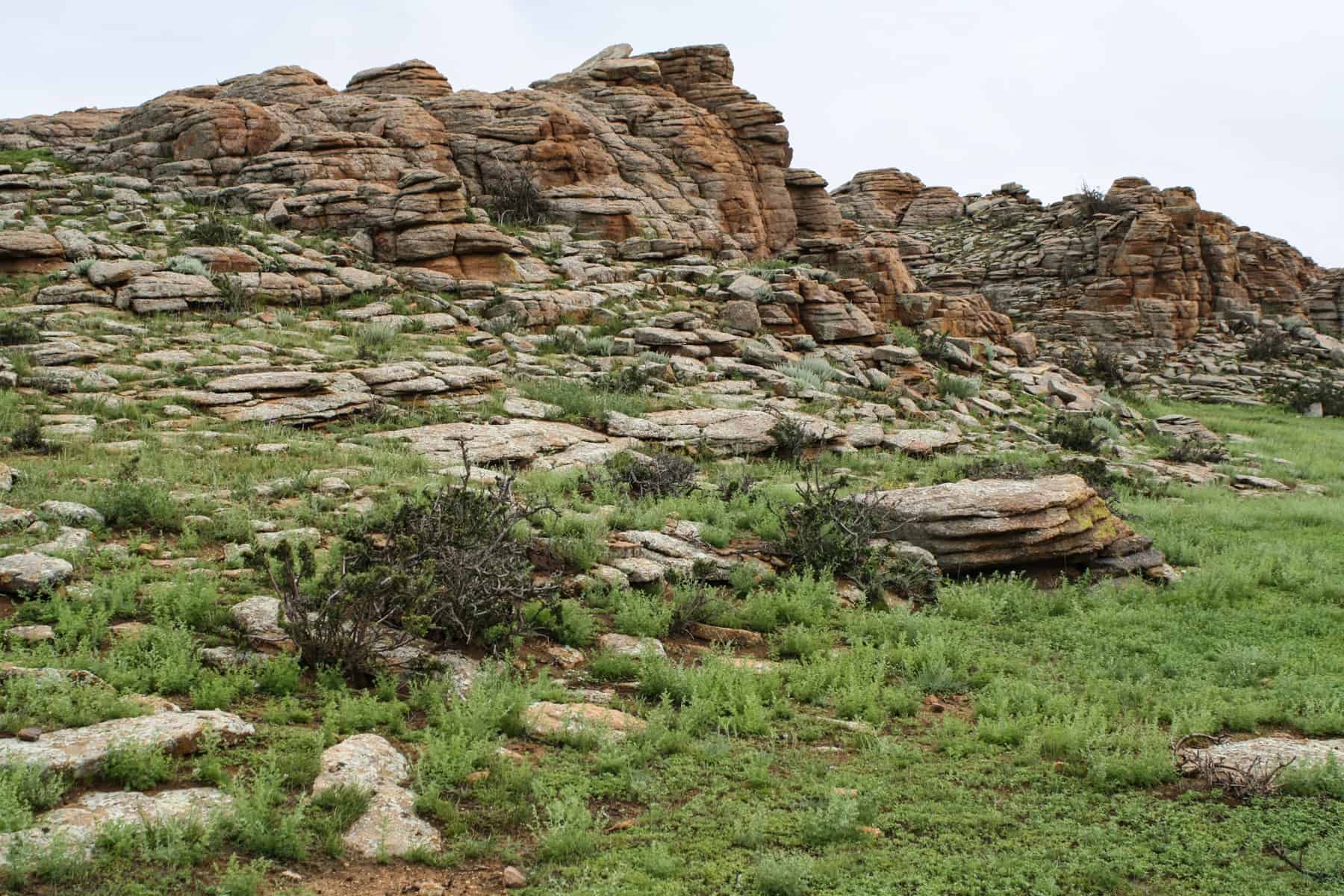
Layers of Baga Gazryn Chuluu rock formations in Mongolia
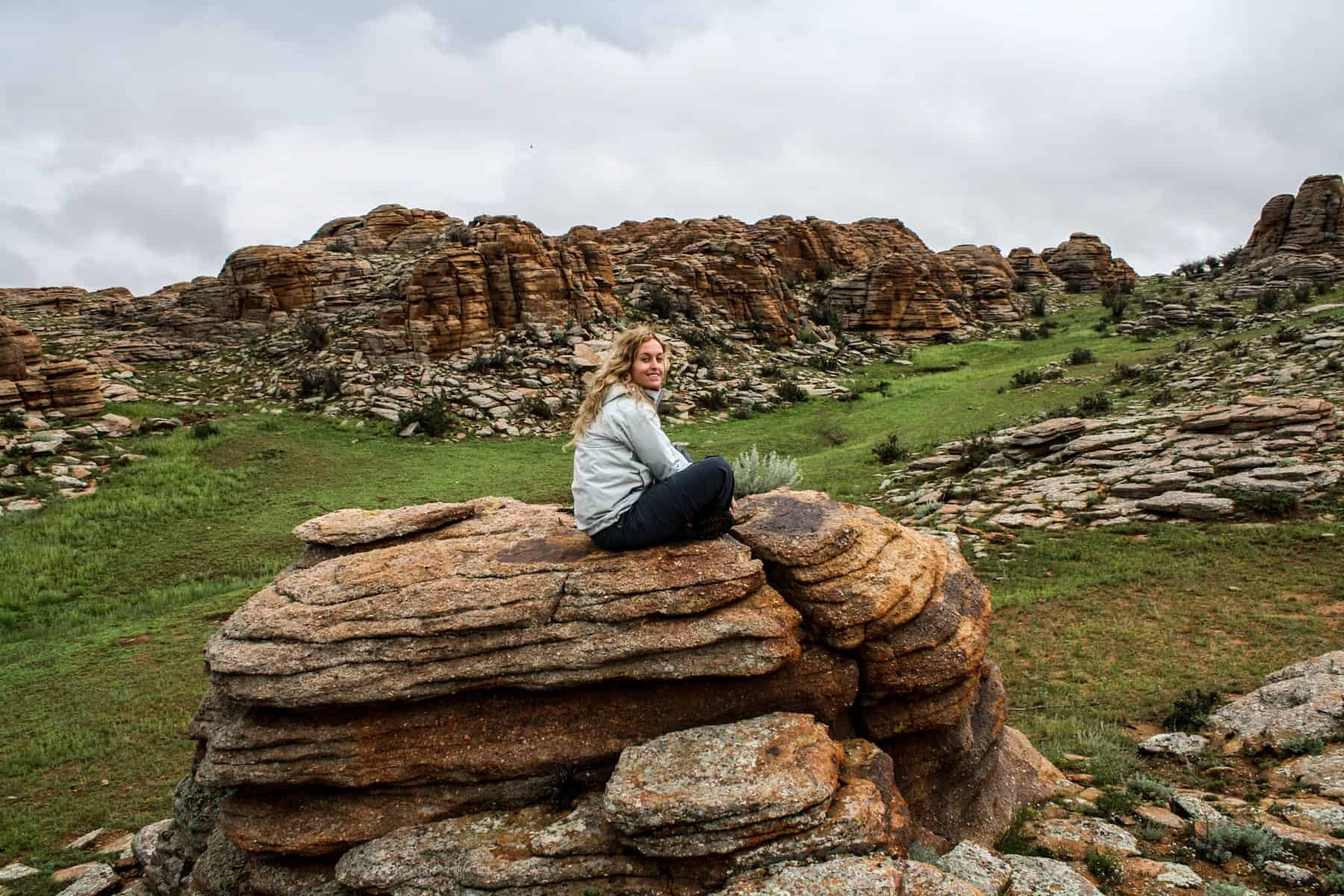
A hike to Baga Gazryn Chuluu as part of a Mongolia travel itinerary
On the way, we got to experience the famous Nadaam Festival when we passed through the local town of Mandal Govi . It was full of wrestling, horse racing, archery and fairground style fun. Nadaam means ‘games’, and the buzz was all around us as the only Westerners there. It was great to be a part of a traditional Mongolian community celebration, even if the afternoon was marred by a bogging, which resulted in the truck not being released from the soft mud until midnight.
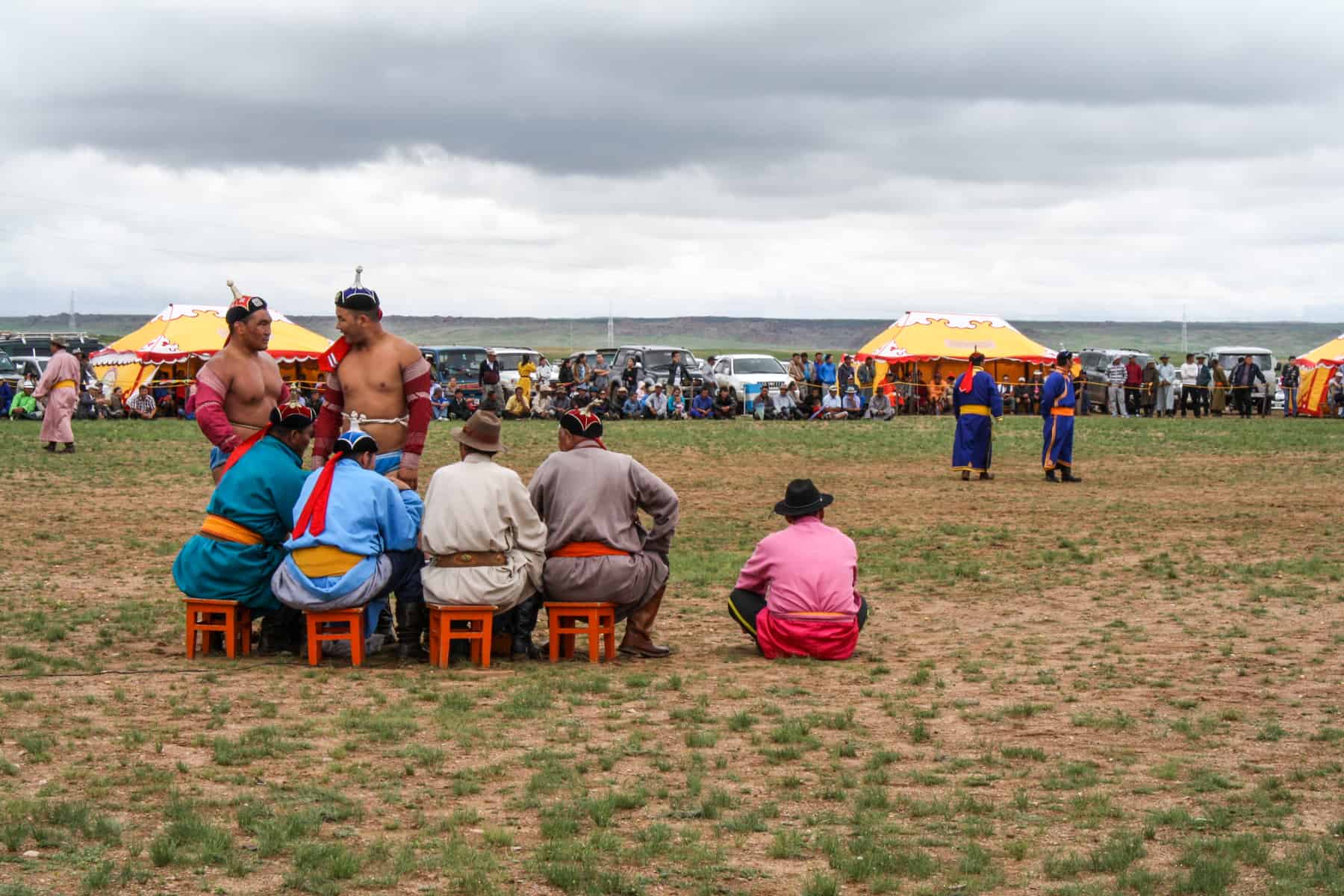
Watching the wrestling at the Nadaam Festival in Mongolia
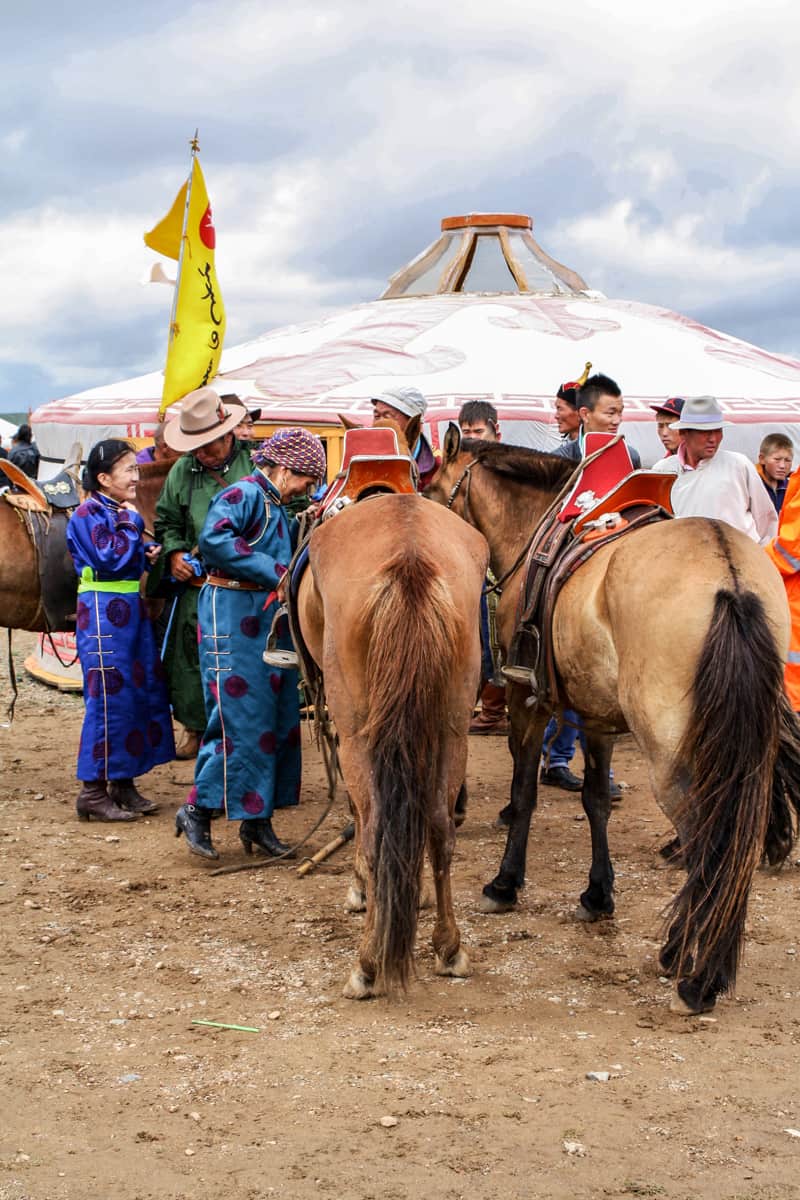
Mongolian locals enjoy the Nadaam Festival.
The plan was to get to our first ger camp, but after approximately 30 kilometres, we encountered a large ditch of water on the road. It resulted in us having to drain the water by hand and build a road and a dam for most of the afternoon to help us get across. Although this sounds horrendous, it created a great sense of camaraderie and, ultimately, an immense sense of achievement. We got to camp on a high point of the Gobi Desert instead near the town of Tsogoovi .
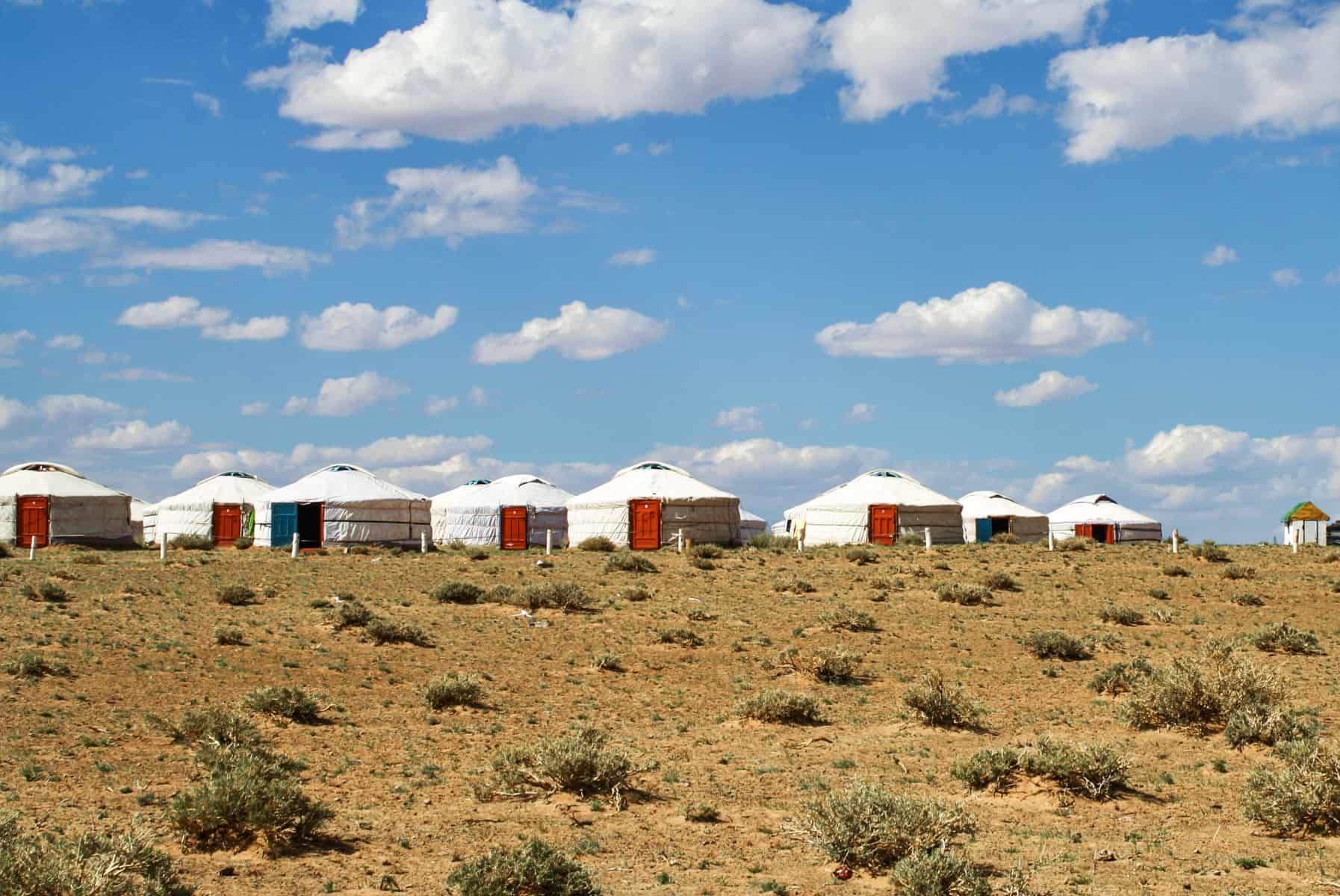
A Ger Camp on a hilltop in the Gobi Desert, Mongolia
We began our journey without a hitch to the ger Camp called Gobi Discovery, stopping at the town of Dalanzagad on the way. Mongolian towns are typically tiny and compact settlements that are reasonably large but without the ruin of a city like Ulaanbaatar.
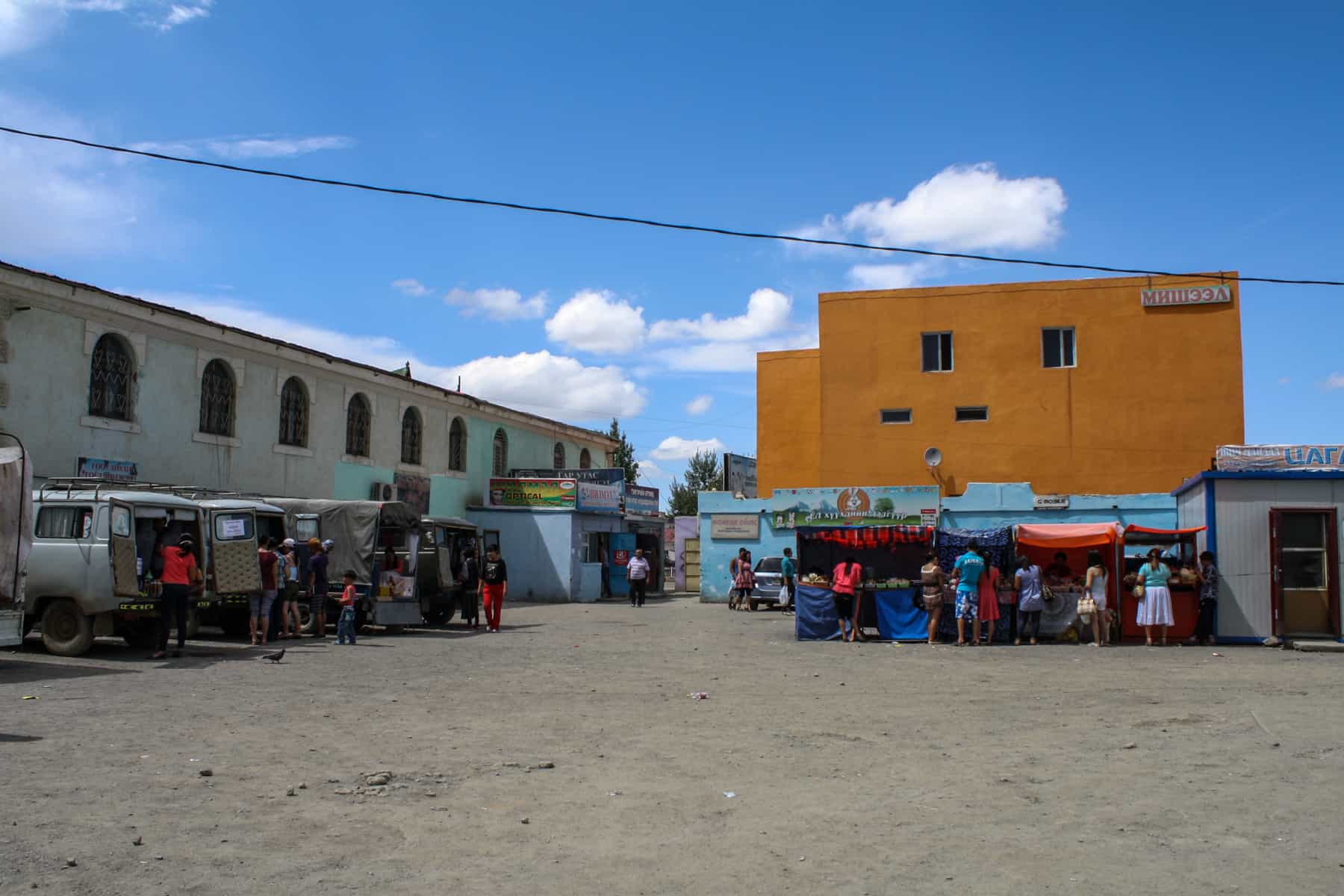
Market time in the town of Dalanzagad, Mongolia
We hiked in Yolin Am , a beautiful canyon in the Gobi, an ice valley, which hosts a colossal glacier all year round. The hike was spectacular, but, unfortunately for us, little of the iceberg remained, although we had lots of fun playing with what little ice there was regardless.
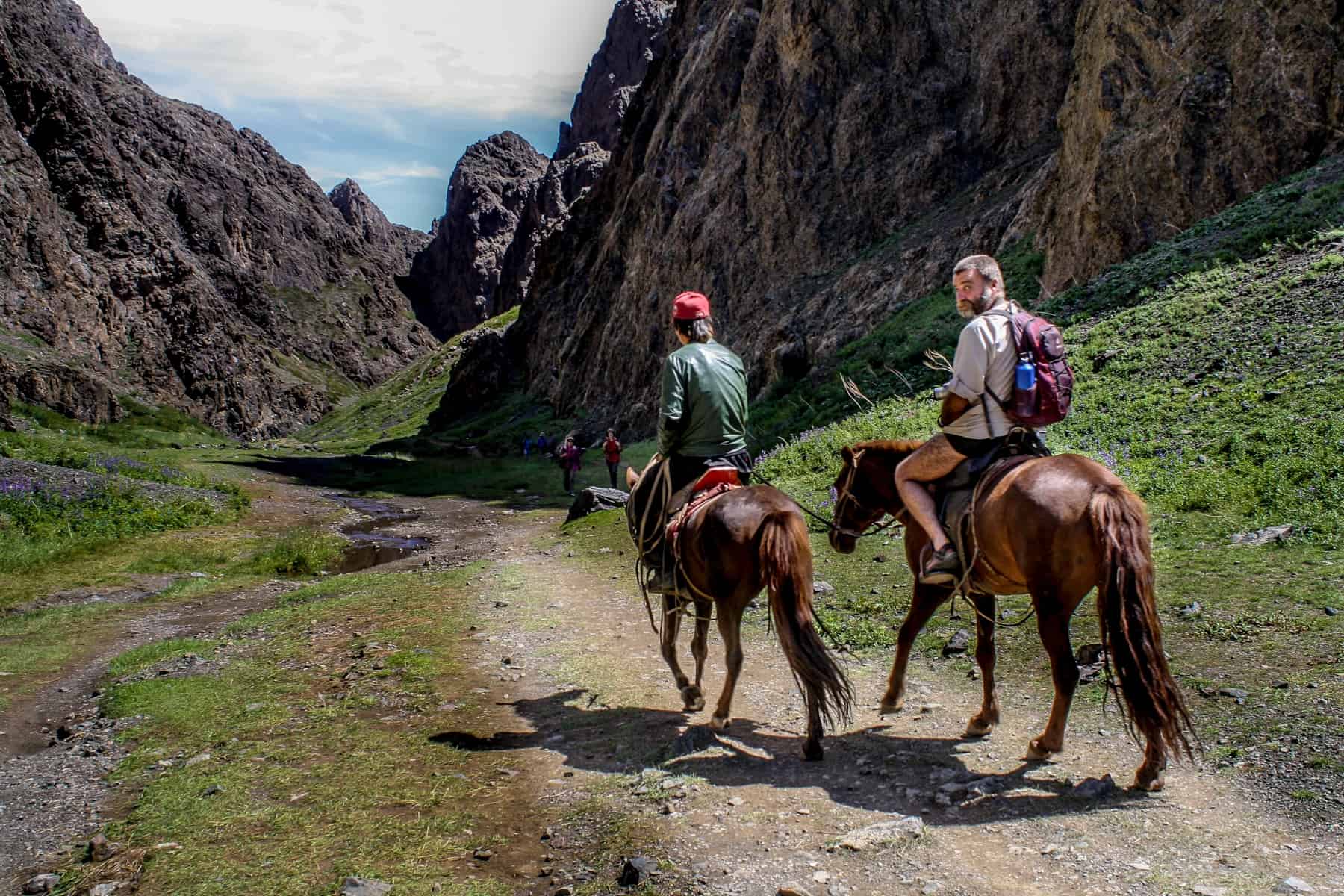
Hike or horseback in the Yolin Am Valley in Mongolia
Many sandy riverbed crossings eventually led us to our second Ger camp, Khongoryn Els Ger Camp. Here, you only have to open your ger door to be greeted with a breathtaking view of the Gobi and the Khongoryn Els Sand Dunes , which I later climbed, drank beer on and ran down. That was after a camel ride, of course.
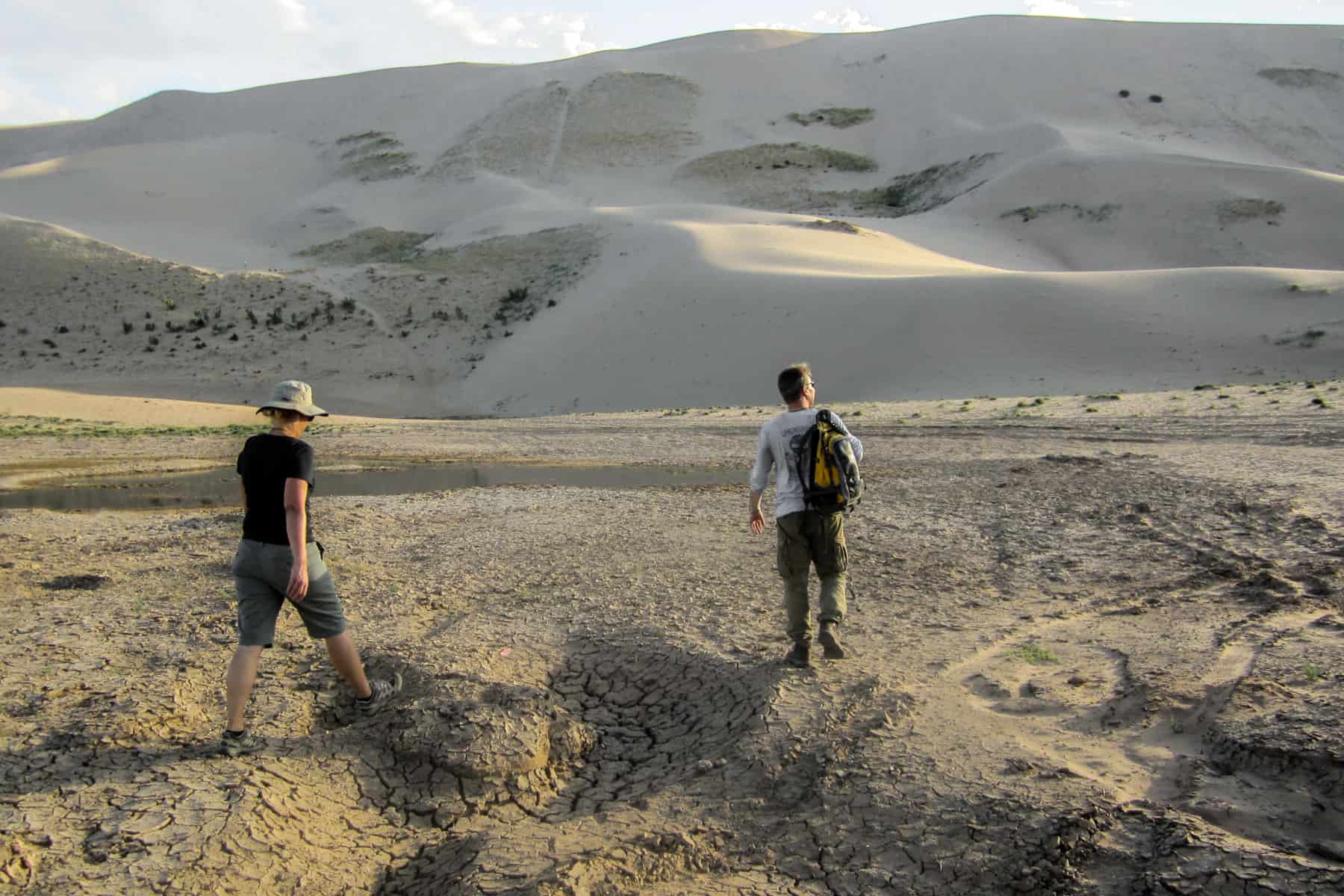
The glorious Gobi Desert Khongoryn Els Sand Dunes
Bumpy mountain roads took us to the spectacular Bayanzag Flaming Cliffs , which are a Mongolian version of the Grand Canyon, but smaller. It’s a significant site that unearthed many dinosaur fossils and eggs, and it is also a stunning backdrop for bush camping.
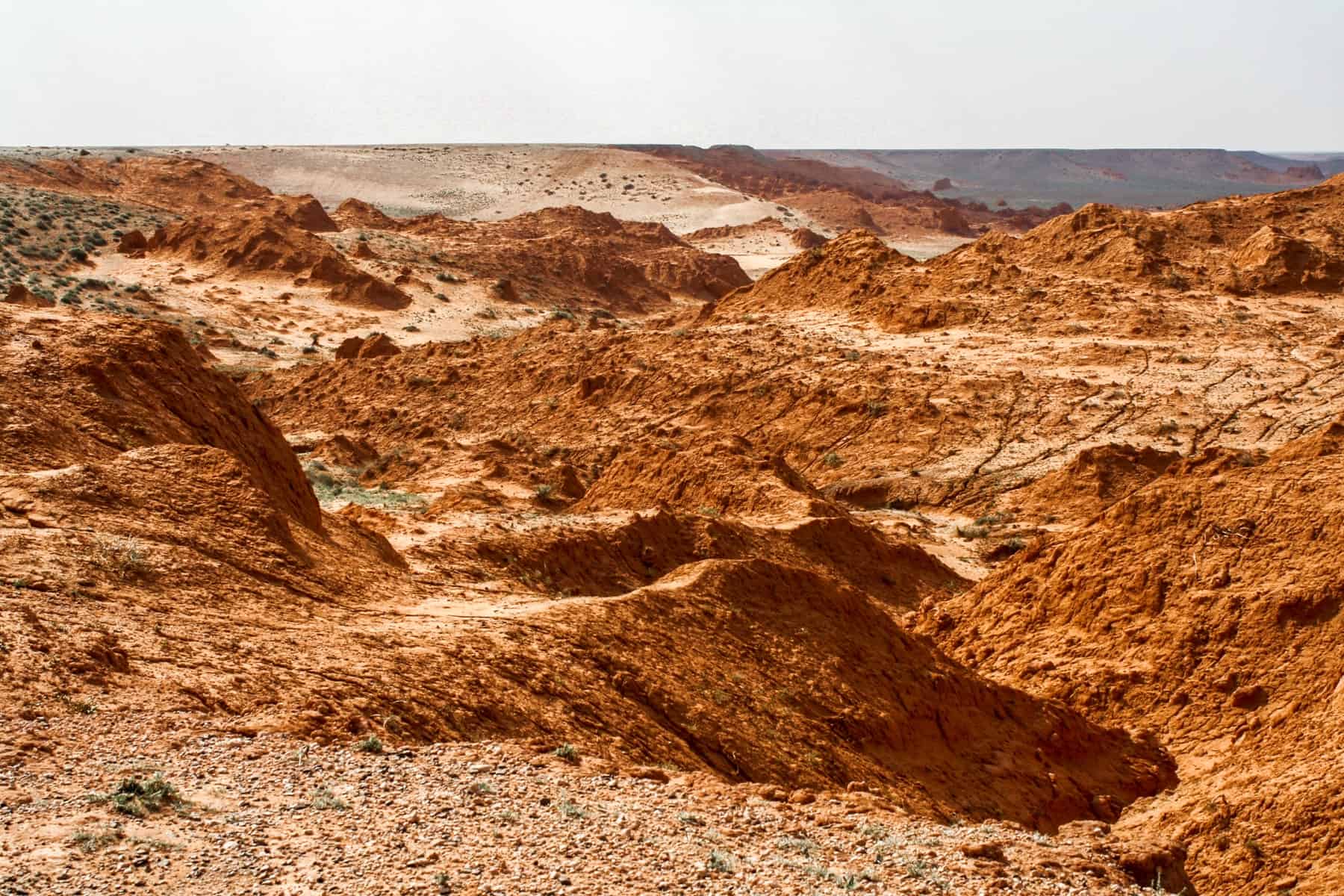
The blazing ochre colours of Mongolia’s Bayanzag Flaming Cliffs
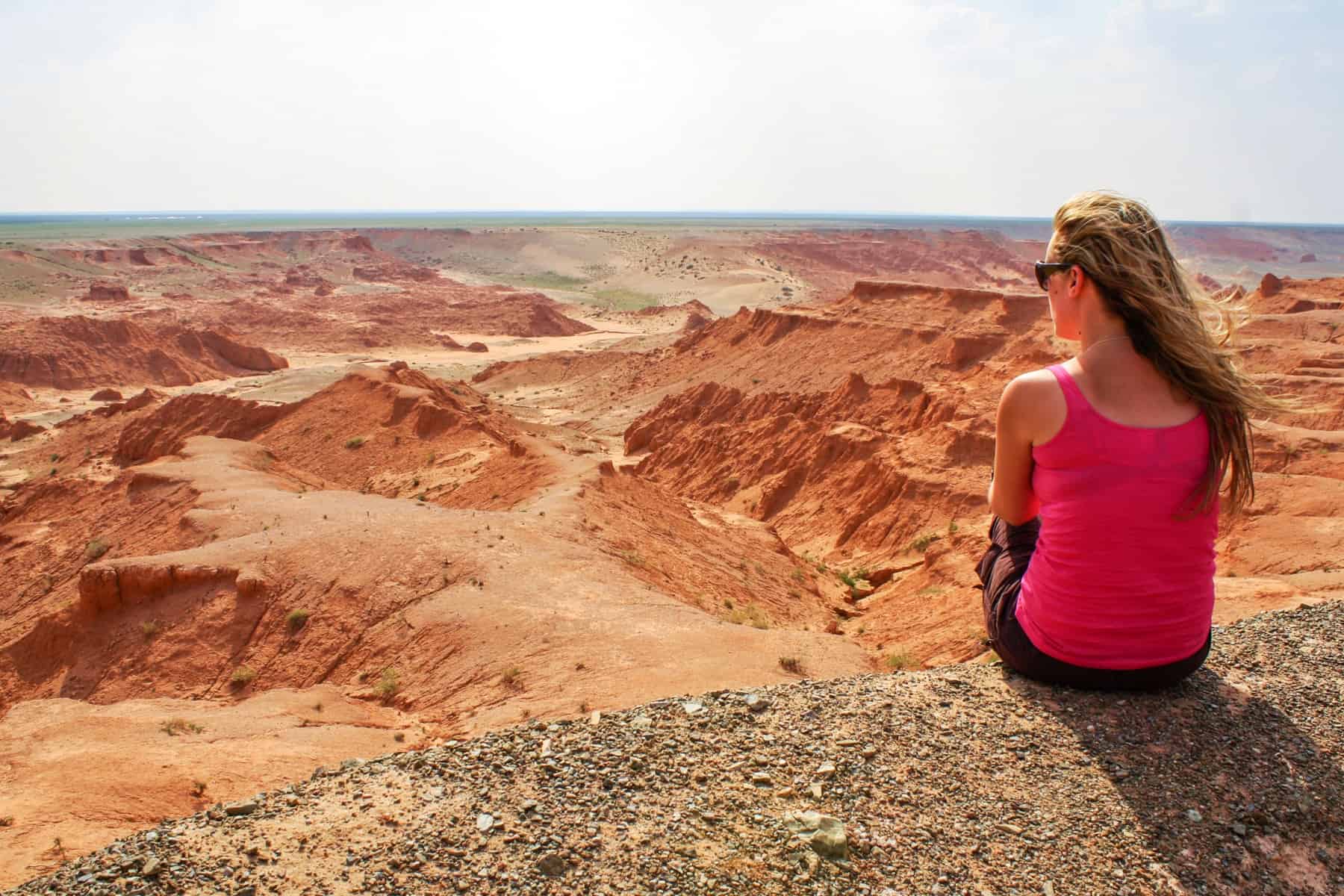
Marvel the mars-like landscape of Bayanzag Flaming Cliffs when you travel to Mongolia
When the communists invaded Mongolia in the 1930s (known as the Purges), nearly all Monasteries were destroyed. Ongii Monastery was one of them, and we visited the ruins here before driving to Arvaikheer, where heavy rain forced us into a hotel for the night. At times, random bad weather makes bush camping in Mongolia impossible, so it is essential to prepare for a budget recount at any given time.
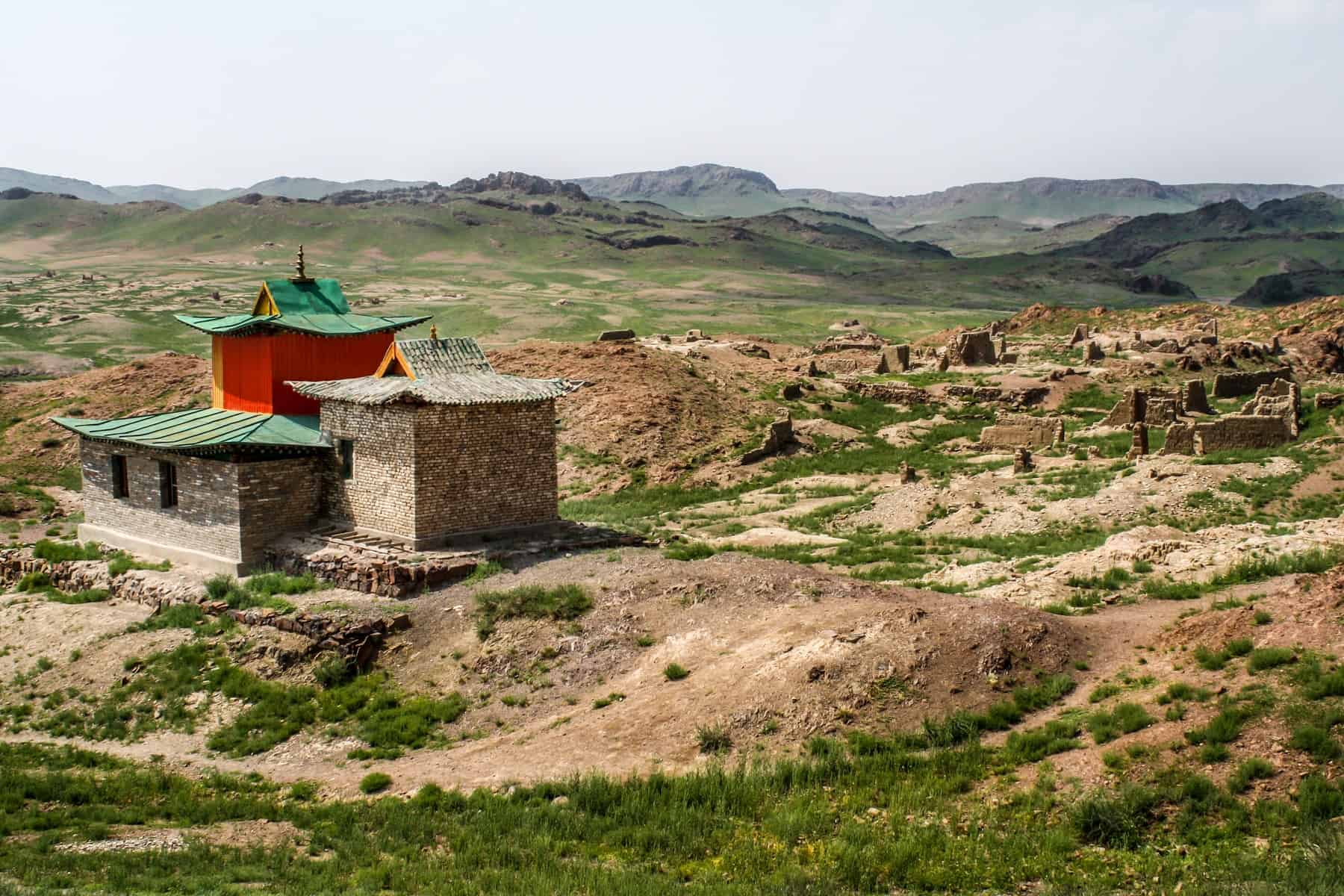
The site of the Ongii Monastery in Mongolia
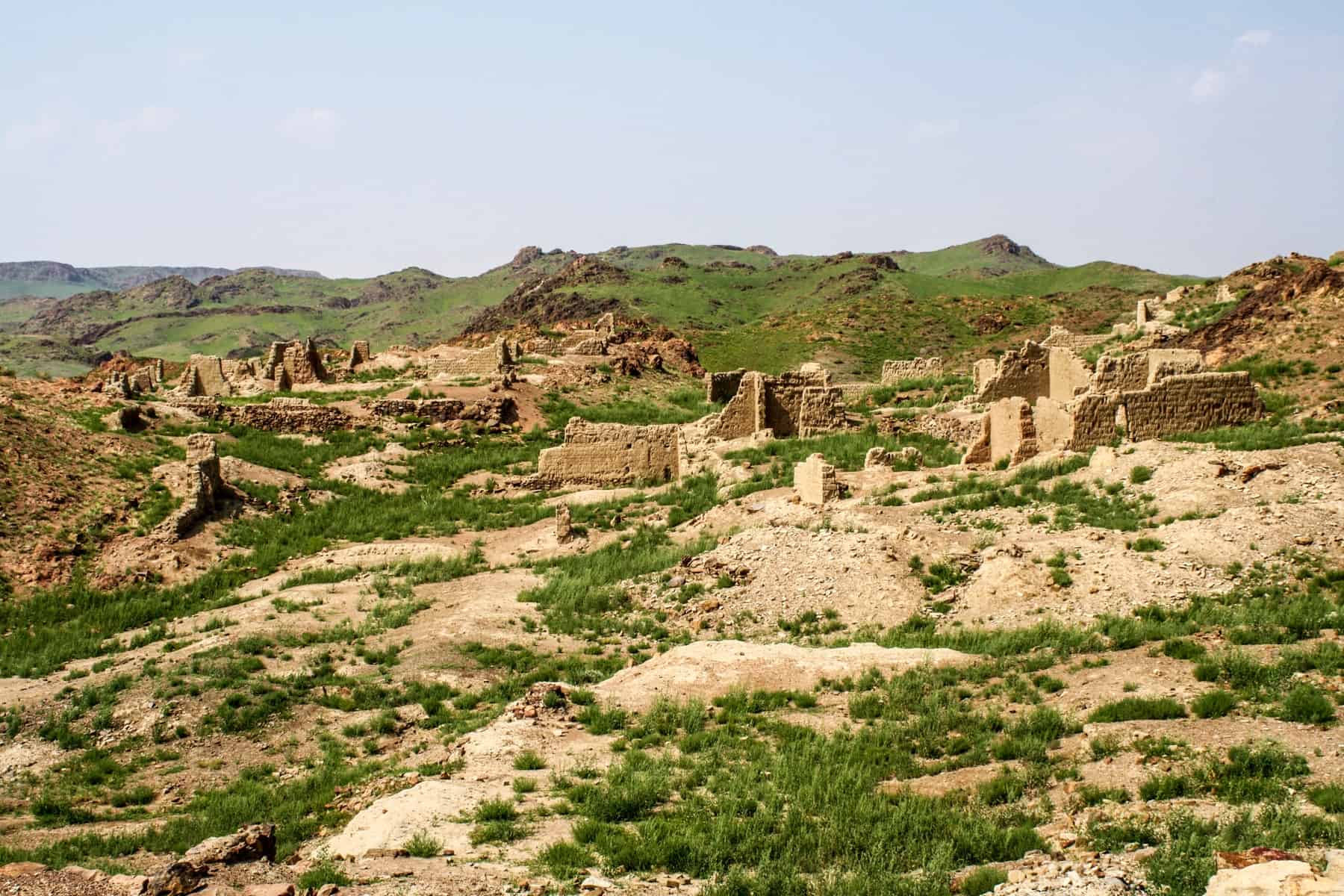
The scattered stone ruins of Ongii Monastery in Mongolia
We began our journey to the third ger camp but got badly bogged around midday after the truck had to swerve slightly, of course, to miss a drunk driver who came in our path (sadly, a lot of people drink and drive here). It took over five hours to get out, with the help of a small local tractor, and during that time, a few of us who remained to help with the truck (local jeeps rescued a few) lost our minds. It was a hilarious few hours that would have made an excellent documentary, probably how a Lord of the Flies scenario starts.
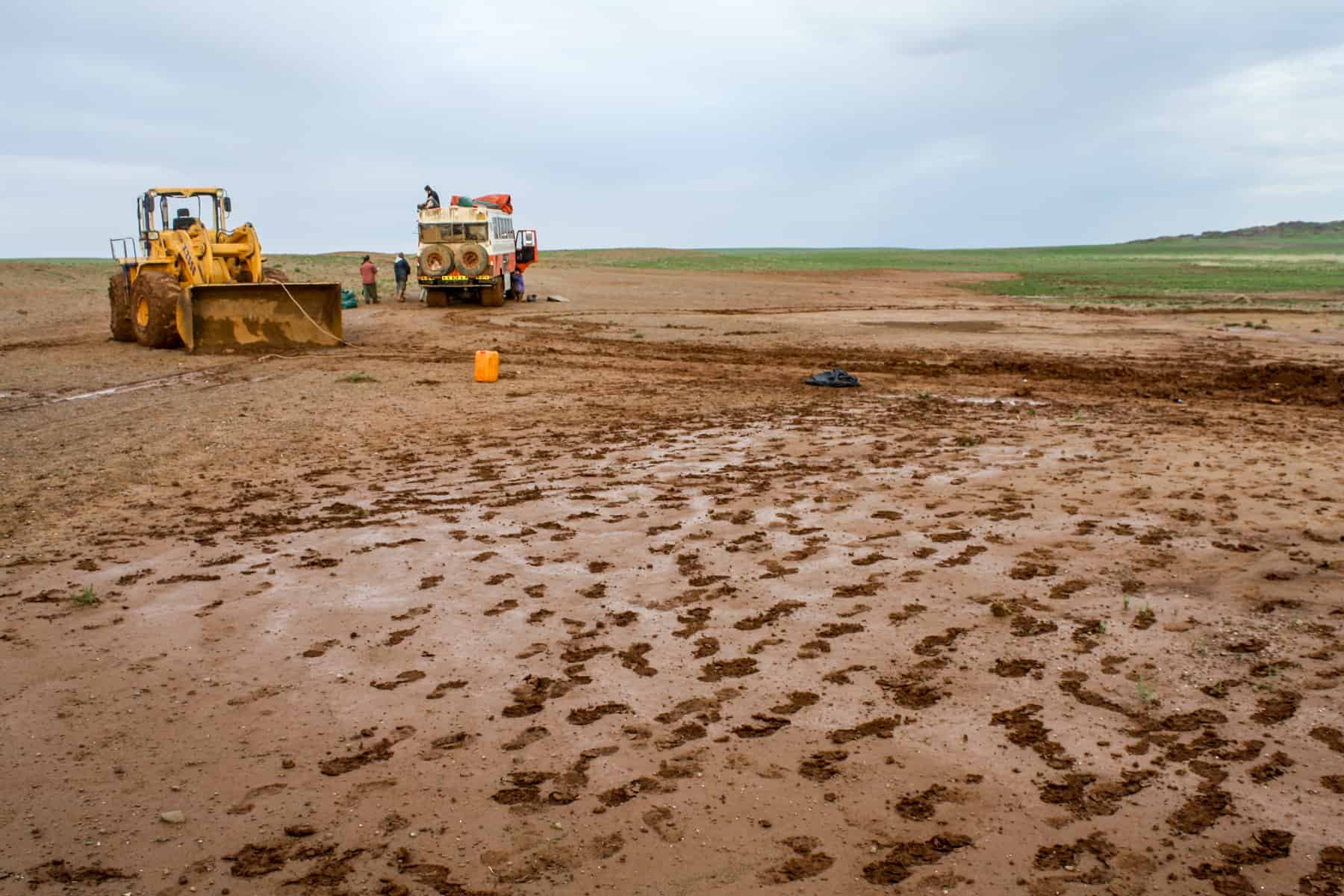
Tractors help pull the Overlanding truck out of the sticky mud in Mongolia’s rural landscape.
The roads were not rigid and stable enough for the truck to continue, especially with all the hills. After setting up tents and cooking dinner, two small vans came to the rescue to take us on our two-hour journey to the Ger Camp. It was a scary ride in the dark, where we stopped at the driver’s backyard and where a small boy jumped into the hold of the van for the rest of the journey.
I highly recommend staying in a ger camp in the beautiful Orkhon Valley . There’s nothing like a pleasant hike through the beautiful forest to reach the Tuvkhon Monastery and see the surrounding area. Pure bliss.
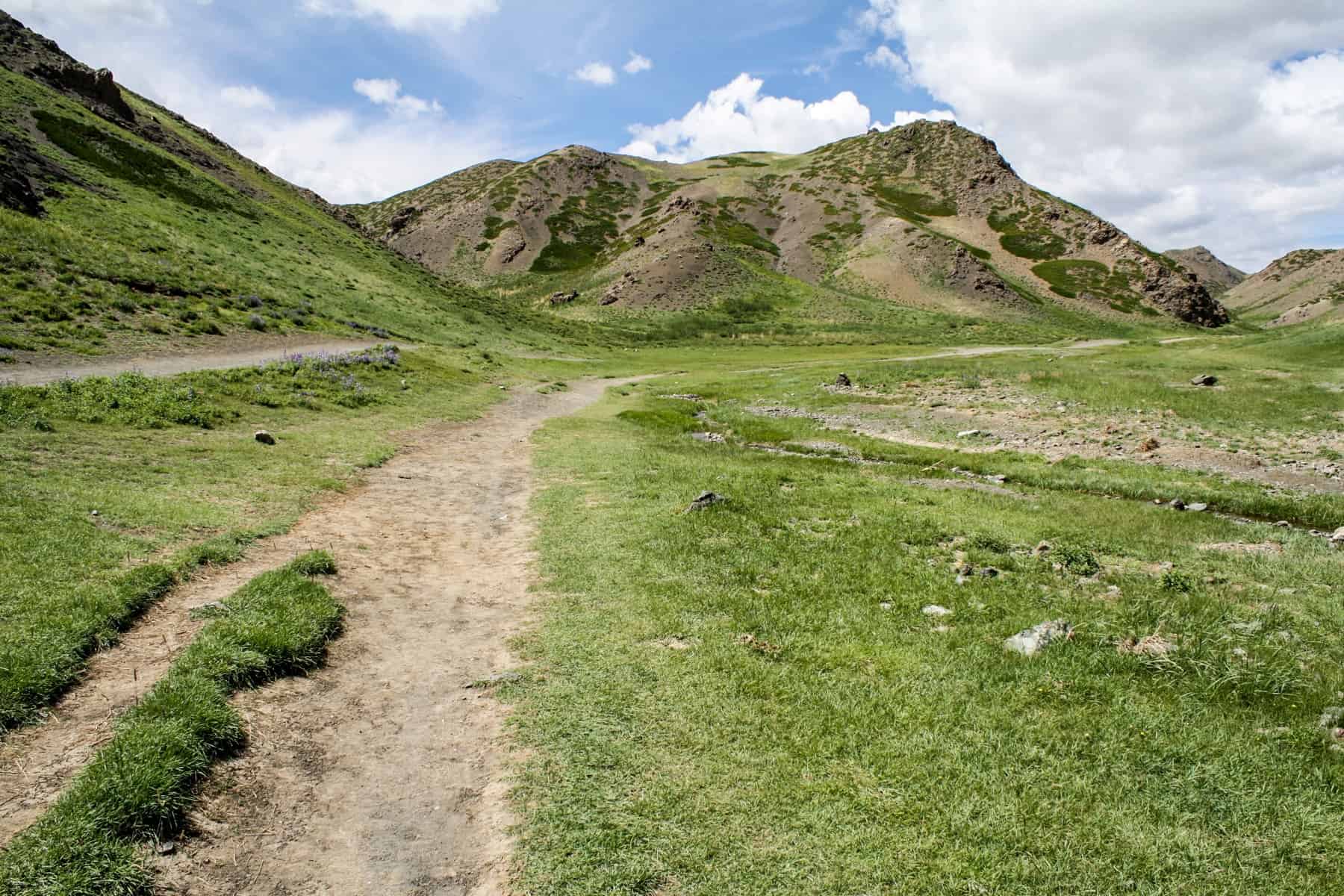
The lush green leading to the soft peaks in the Orkhon Valley Mongolia
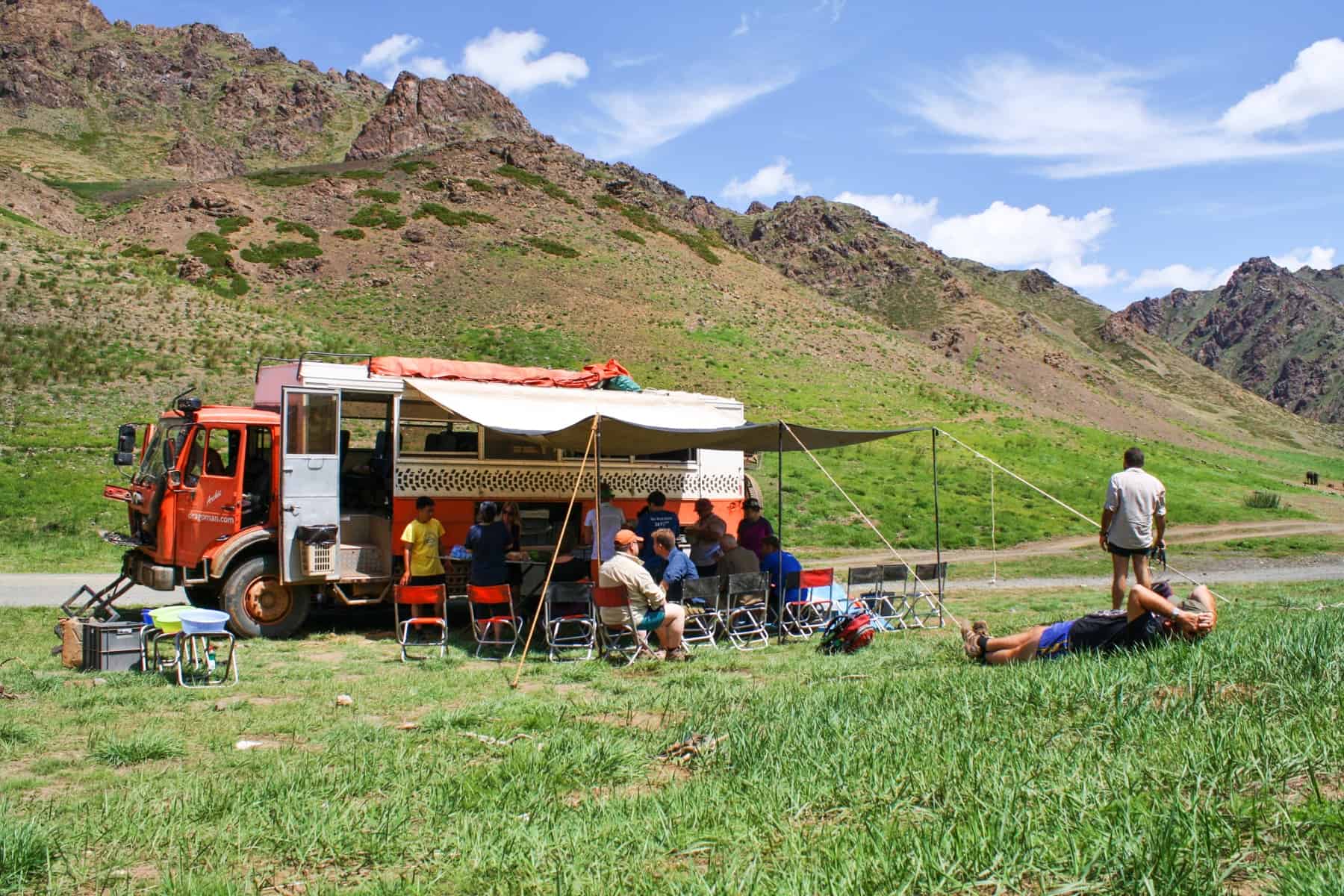
A rest stop in the scenic Orkhon Valley landscape
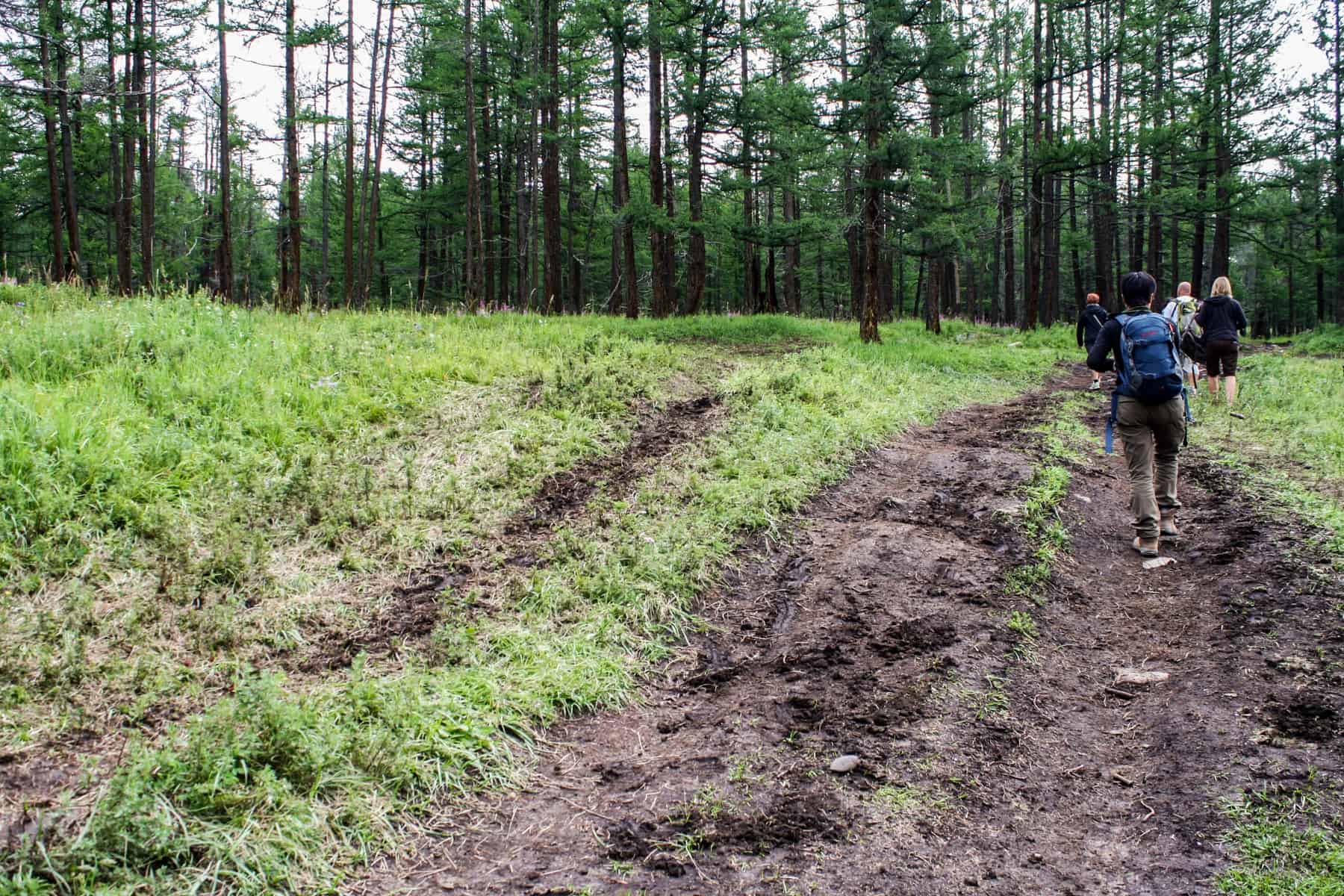
Hiking the forest trails of Mongolia’s Orkhon Valley

The rocky plateau that surrounds the Tövkhön Monastery in Mongolia

The colourful entrance to the Tövkhön Monastery
The Orkhon Valley waterfall was the next stop on our five-hour drive to the next ger camp. This camp plays host to the famous hot springs in the region, where we went skinny dipping and enjoyed a few refreshing beers.
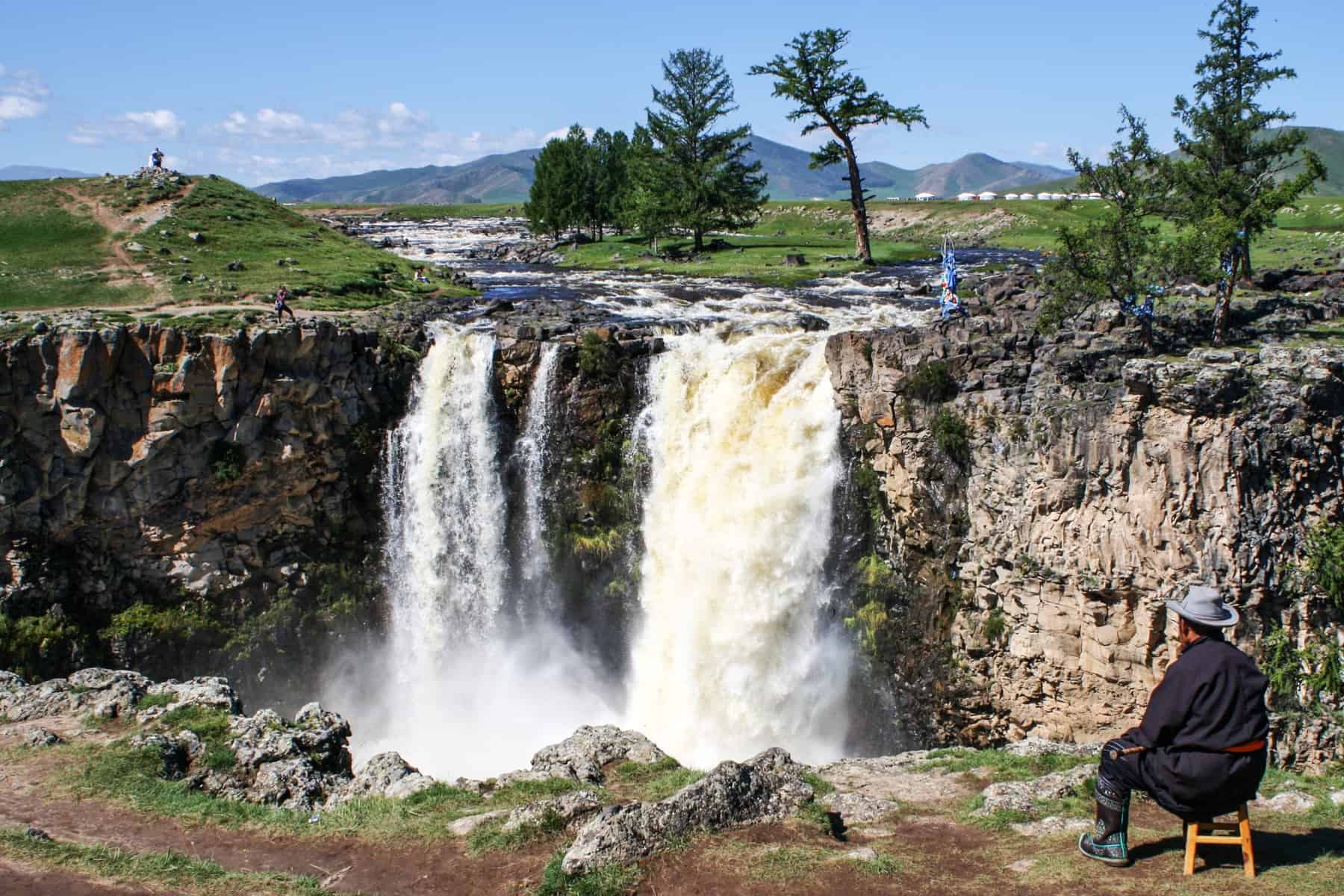
A Mongolian man sits in a chair peacefully enjoying the backdrop of the Orkhon Valley Waterfalls in Mongolia.
Fully clothed, of course, we took a short hike through the lush green forest to visit the source of the hot springs. When you come across your first sighting of trees after two weeks of barren land, you begin to appreciate such incredible surroundings.
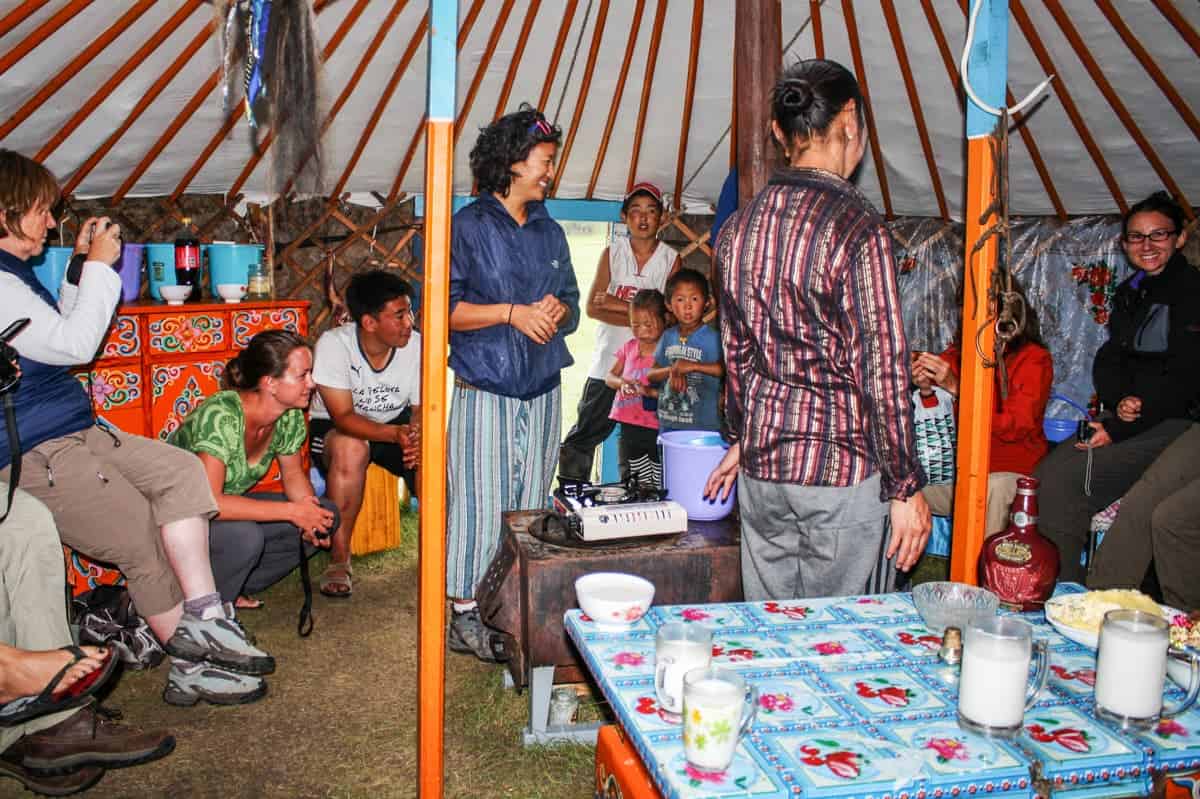
Visiting a local nomadic family in their ger in Mongolia
As we had two Mongolian guides with us (invaluable support in a country where very little or no English is spoken or understood), we could visit a Mongolian ger and a local family to learn about nomadic life.
It wasn’t a tourist set up, but a traditional, local family who lived on an isolated patch of land in the valley. We tried their dairy products (their source of income), including fermented mare’s milk, curd and butter, before learning about ger rules and traditions and asking each other many questions!
READ MORE: Visiting a Mongolian Ger – Understanding the Nomadic Culture of Mongolia
We needed a quick stop in the nearby town of Tsetserleg to stock up on food supplies. It was a market day with an electric atmosphere. I get a high from moments when you don’t know where you are and what to do, and where you have to work hard to communicate and negotiate.
We later visited the most important Monastery in the country, Erdene Zuu Monastery in Kharkhorin – the first Buddhist monastery in Mongolia that had up to 100 temples and 1,000 monks before the purges in 1937. Only three temples remained, alongside several statues and other items.
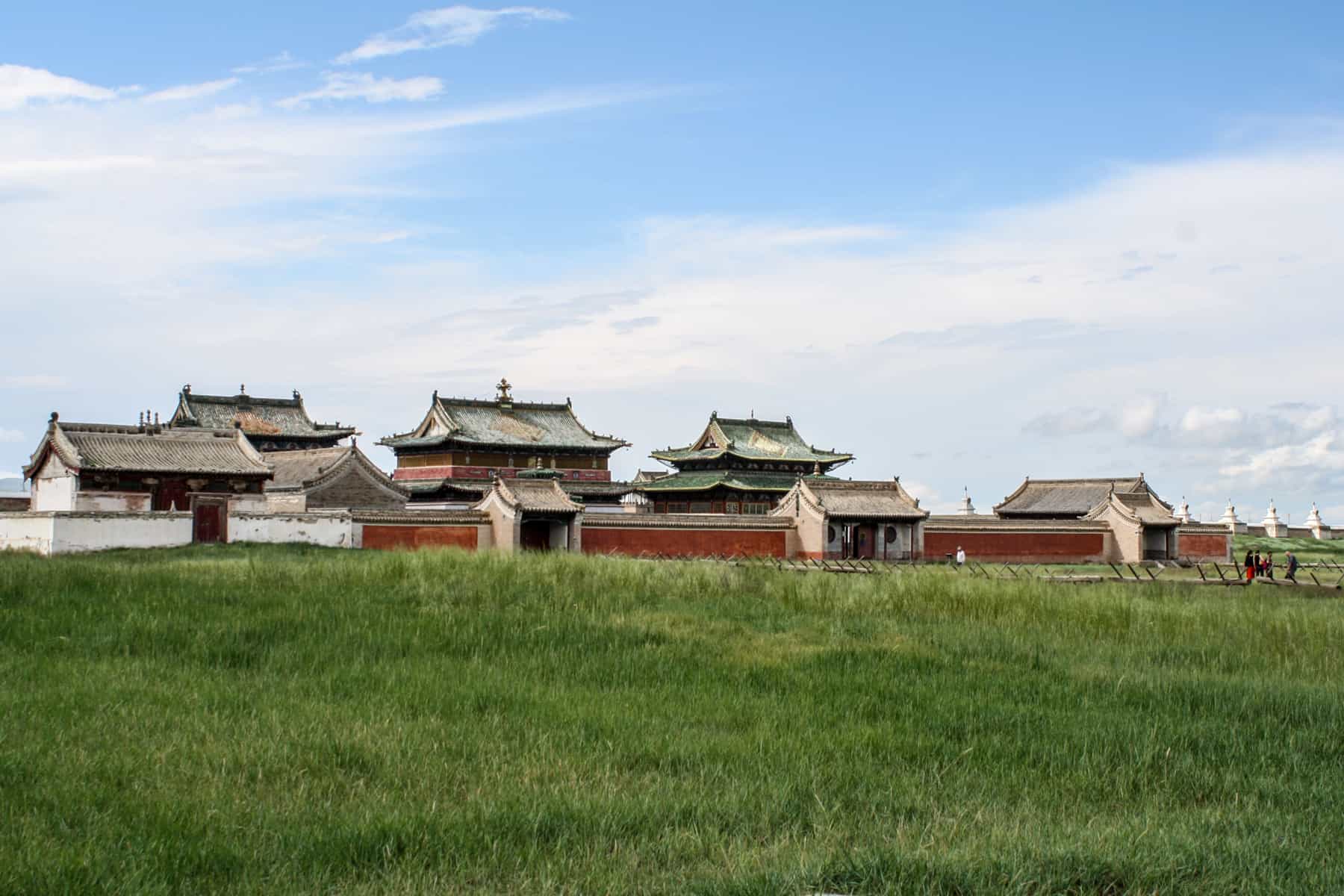
The exterior walls of the Erdene Zuu Monastery, Mongolia
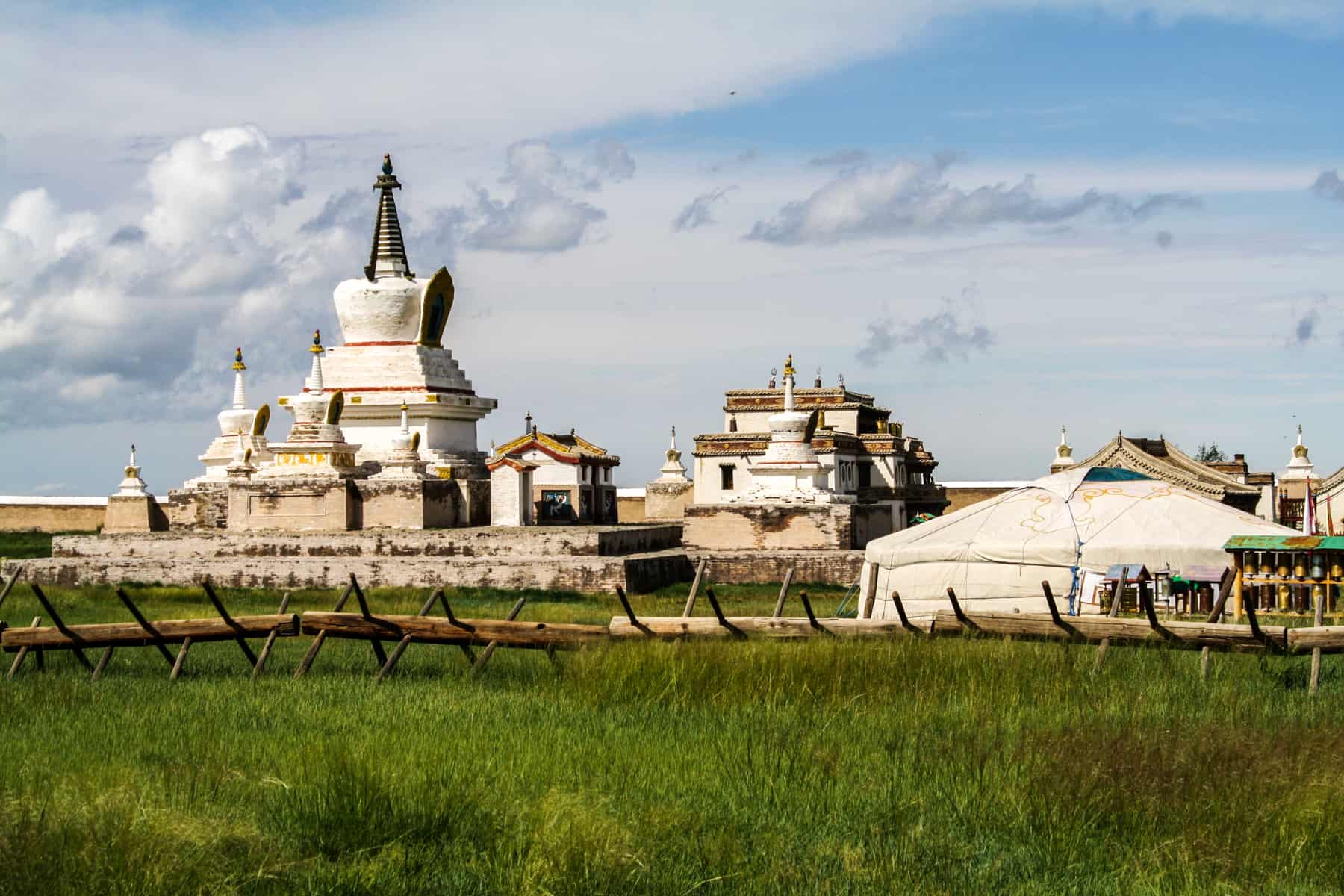
Part of the temple complex inside Mongolia’s Erdene Zuu Monastery
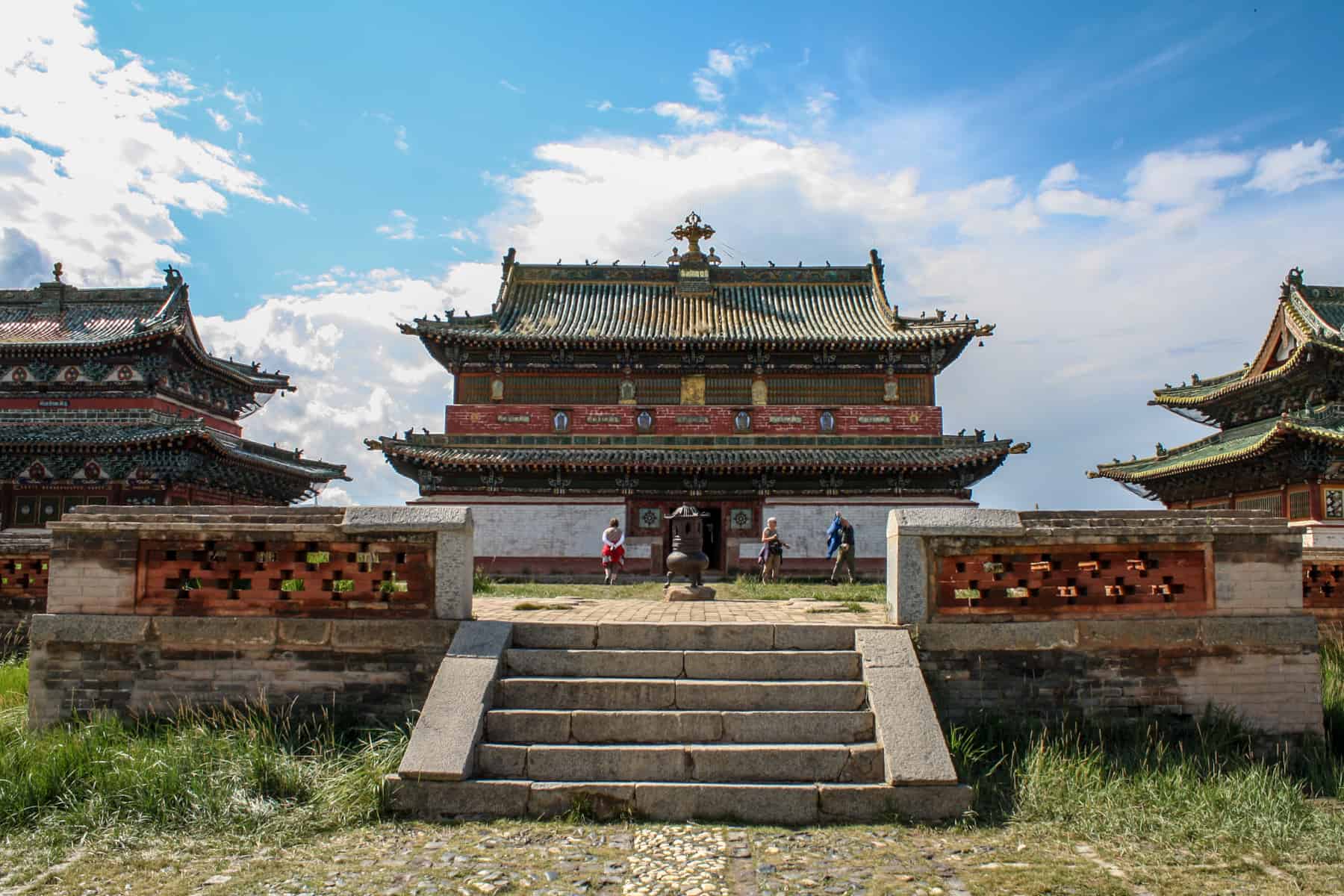
The red, gold and green temple structures at Erdene Zuu Monastery
A visit to the museum we camped next to – the Kultigen Monument, housing artefacts from the Turkish empire – set us on the way to the nearby Ugii Lake, where we would relax all day and camp for one night.
Ugii lake emits a calming atmosphere and invites you to traverse it slowly. While it would take almost a day to walk around, it’s a great place to unwind and reflect. I count this as one of my most favourite spots in all of Mongolia.
Our camping set-up beside Ugii Lake in Mongolia
We arrived at Hustain National Park in the afternoon to settle into a ger camp. This National Park is known for the rare Przewalski’s horse, unique to Mongolia. When you finally track down a small group, it’s still hard to see their beauty up close as you can’t get that close to them.
Still, we got to meet the ‘Best Mongolian Folk Band in Mongolia’ called Domog in the evening after a fantastic show where they performed rock-style tunes via the famed throat singing. I guess it is the equivalent of meeting Westlife in Ireland. Seriously.
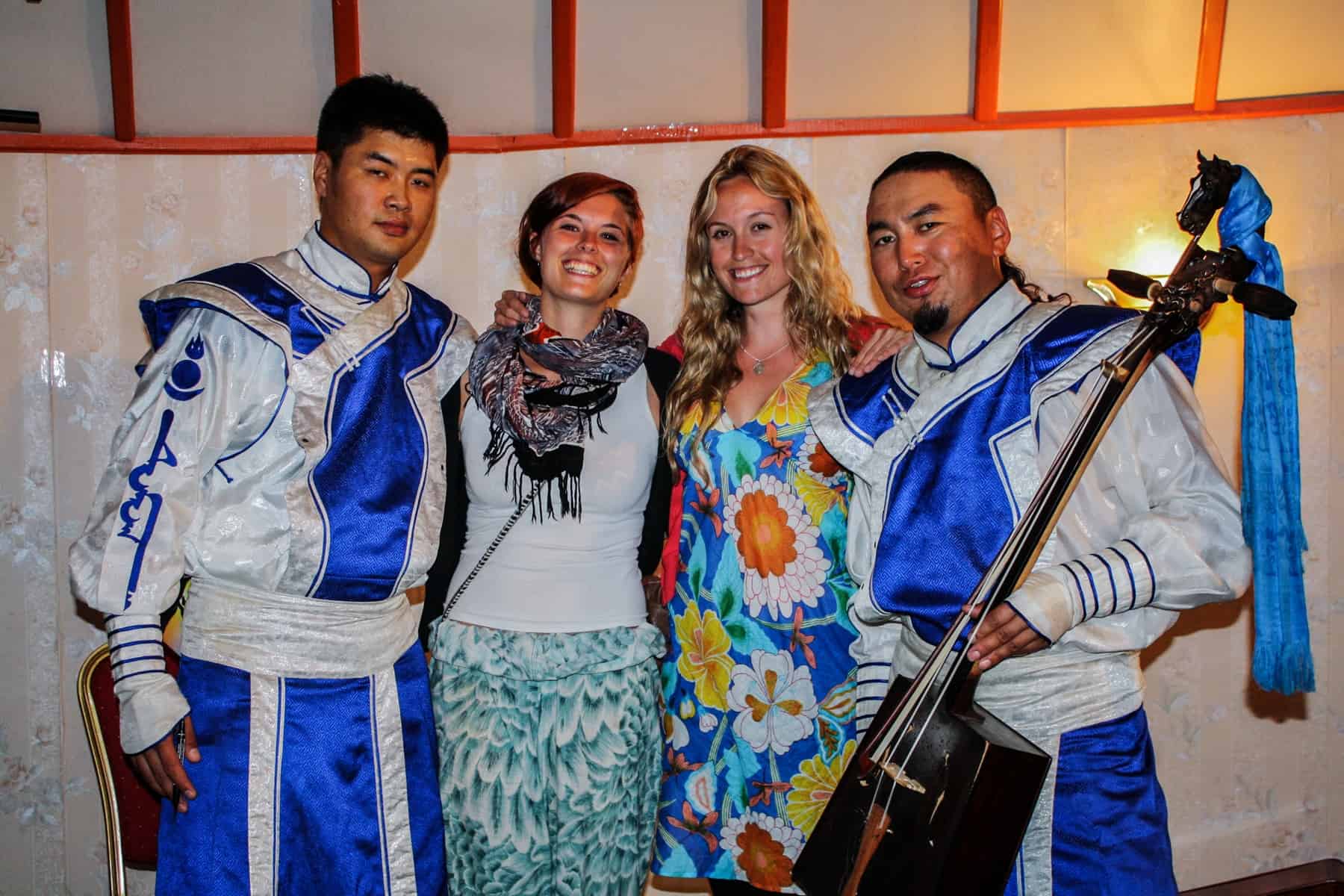
Meeting Damog, the Best Mongolian Folk Band in Mongolia
We had to journey back through the crazy, construction-overloaded, traffic-ridden Ulaanbaatar to get to Terelj National Park and the last ger camp of the trip (we were due to bush camp the weather put a stop to that).
It’s incredible how a few hours down the road from the capital brings you to some of the country’s most spectacular landscapes.
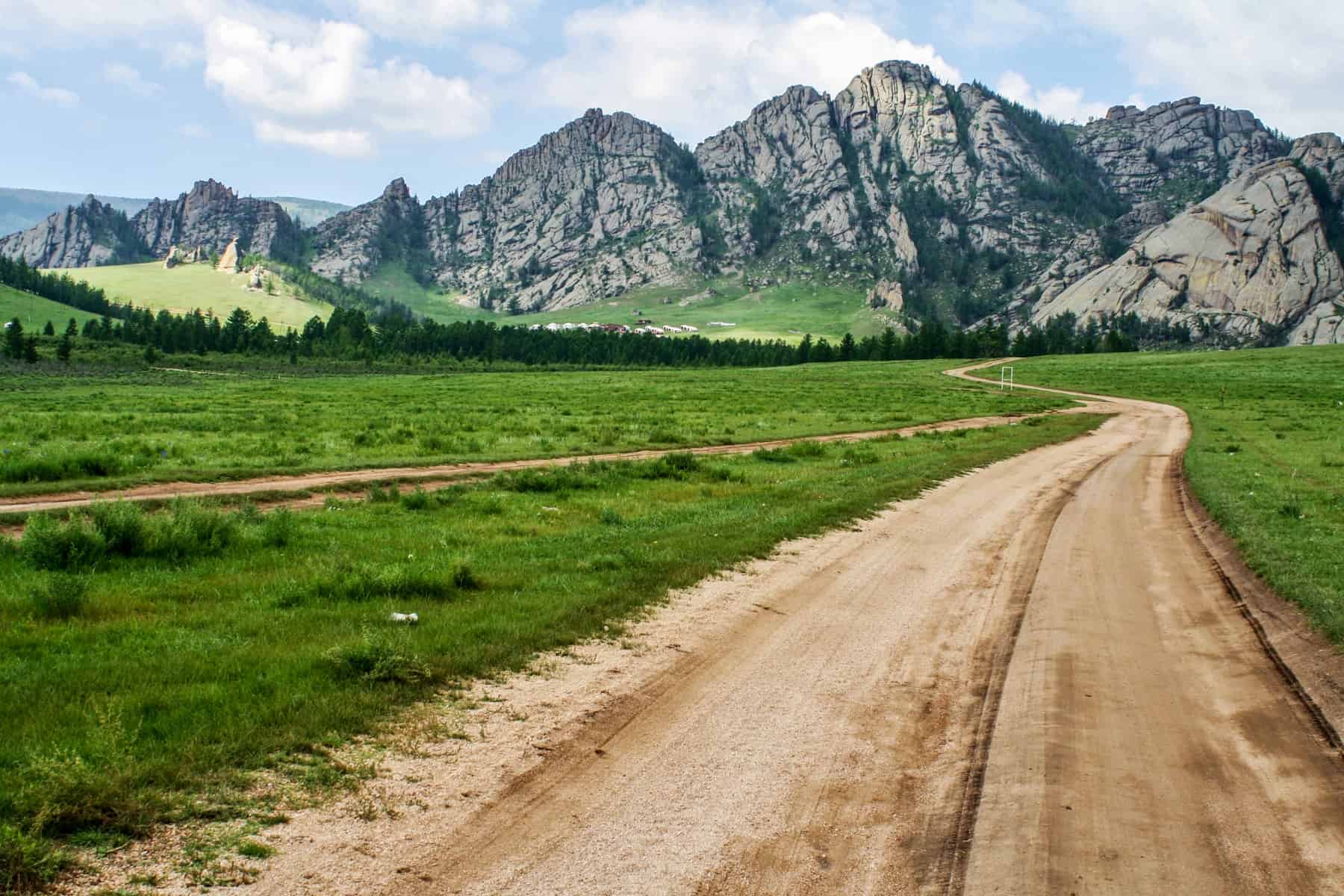
The road that leads to the heart of Terelj National Park, Mongolia
If you love walking and hiking, you will love Terelj National Park. Here you can wander for hours, hike to a Monastery and horse ride through the forests and rocky hilltops. Make sure you check out ‘Turtle Rock’ too. You may think it looks like something else from a certain angle!
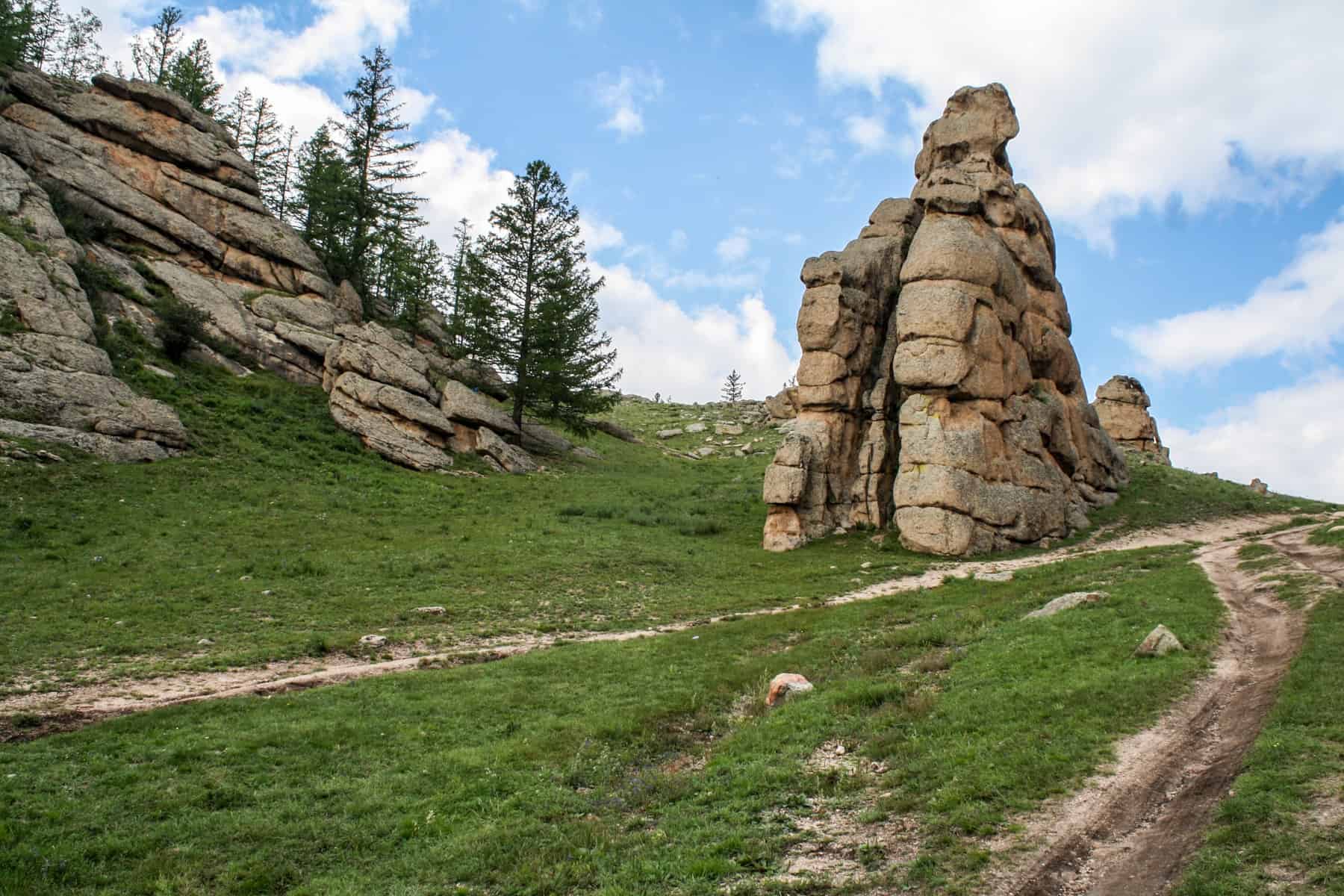
One of the layered rock formations in Terelj National Park in Mongolia
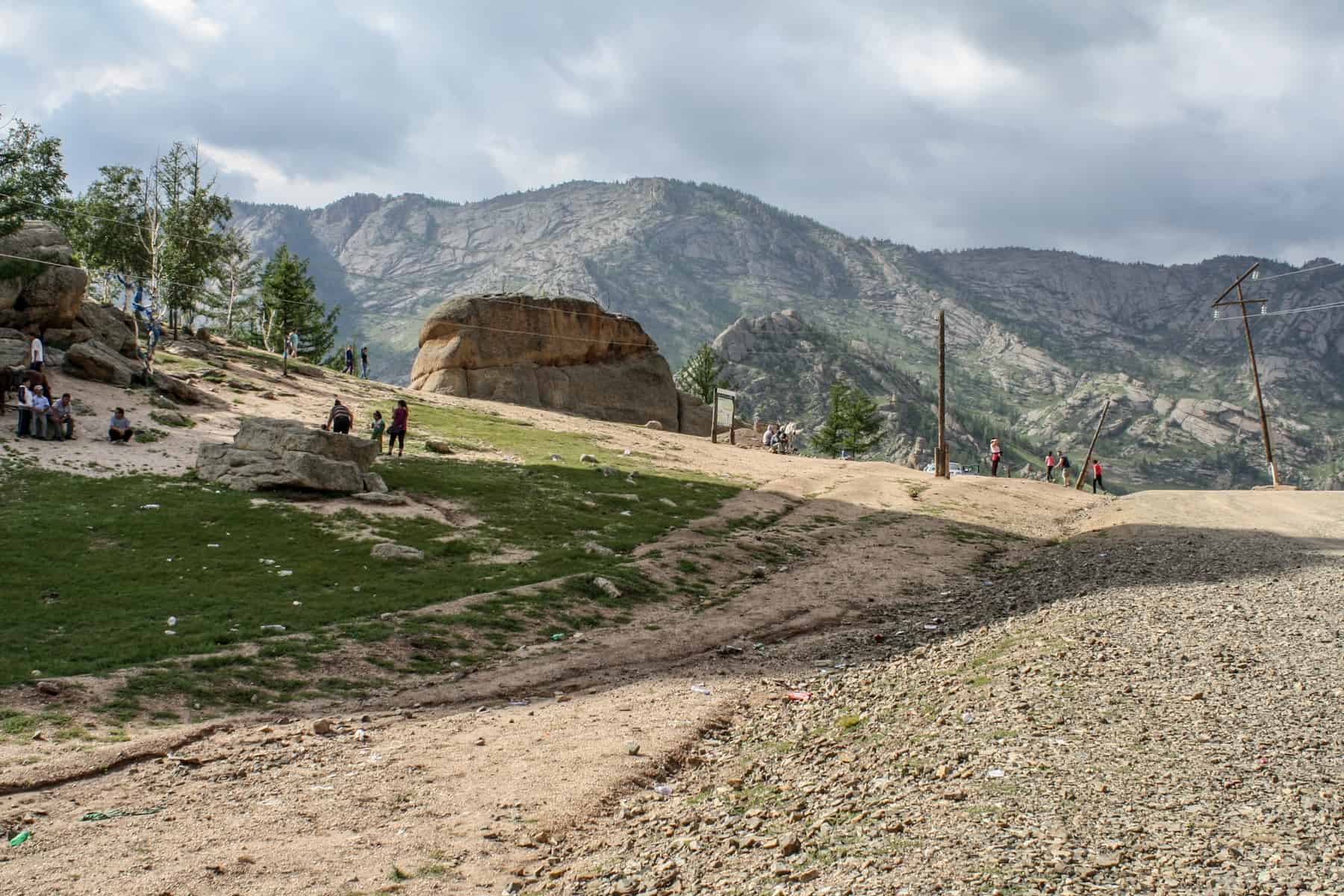
Visiting Turtle Rock in Terelj National Park Mongolia, named for its shape similar to the animal
Nothing beats the end of the wilderness journey than a visit to the giant 40-metre tall silver Ghengis Khan statue just outside of Ulaanbaatar on the banks of the Tuul River. Legend has it that it was at this spot that Ghengis Khan found his golden whip. Anyhow, a bit of a pilgrimage spot for locals, it was fascinating (if not a bit odd and imposing in the same way a colossal silver statue of Hitler in Germany would probably evoke the same feeling).
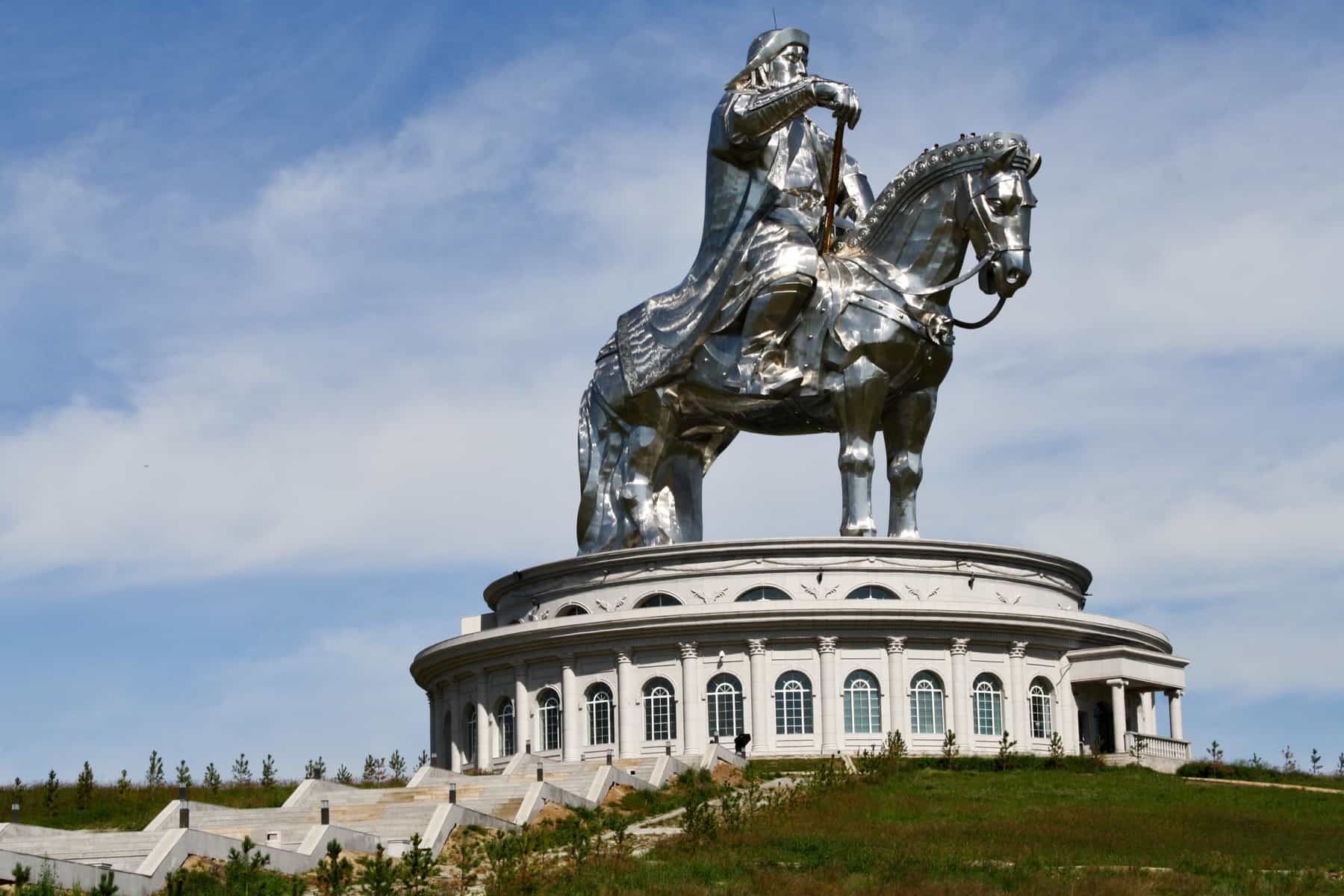
40-metre tall silver Ghengis Khan statue just outside of Ulaanbaatar, Mongolia
Back in Ulaanbaatar, I turned my hostel room into an office and distracted myself with a pizza slice, cake and coffee at Wendy’s Bakery – worth a visit alongside the State Department Store, which is right next to the hostel area. It’s an excellent chance to rest up after adventure through the vast landscapes of Mongolia.
The Dragoman overland truck is what we called home, except we didn’t sleep on it overnight. Instead, we went wild camping and every night, checking into a hotel once when the rains were too much to settle a tent comfortably.
The Outside
The truck’s exterior has lots of compartments – storage for luggage and tents and a clean water supply, mealtime equipment and food supplies. It’s a travelling transformer, and everyone has to lend a hand setting up and packing down for breakfast, lunch and dinner.
If you have no sense of camaraderie or hate getting dirty, then this isn’t the kind of adventure trip for you. I embraced it and loved every minute of ‘roughing it’.
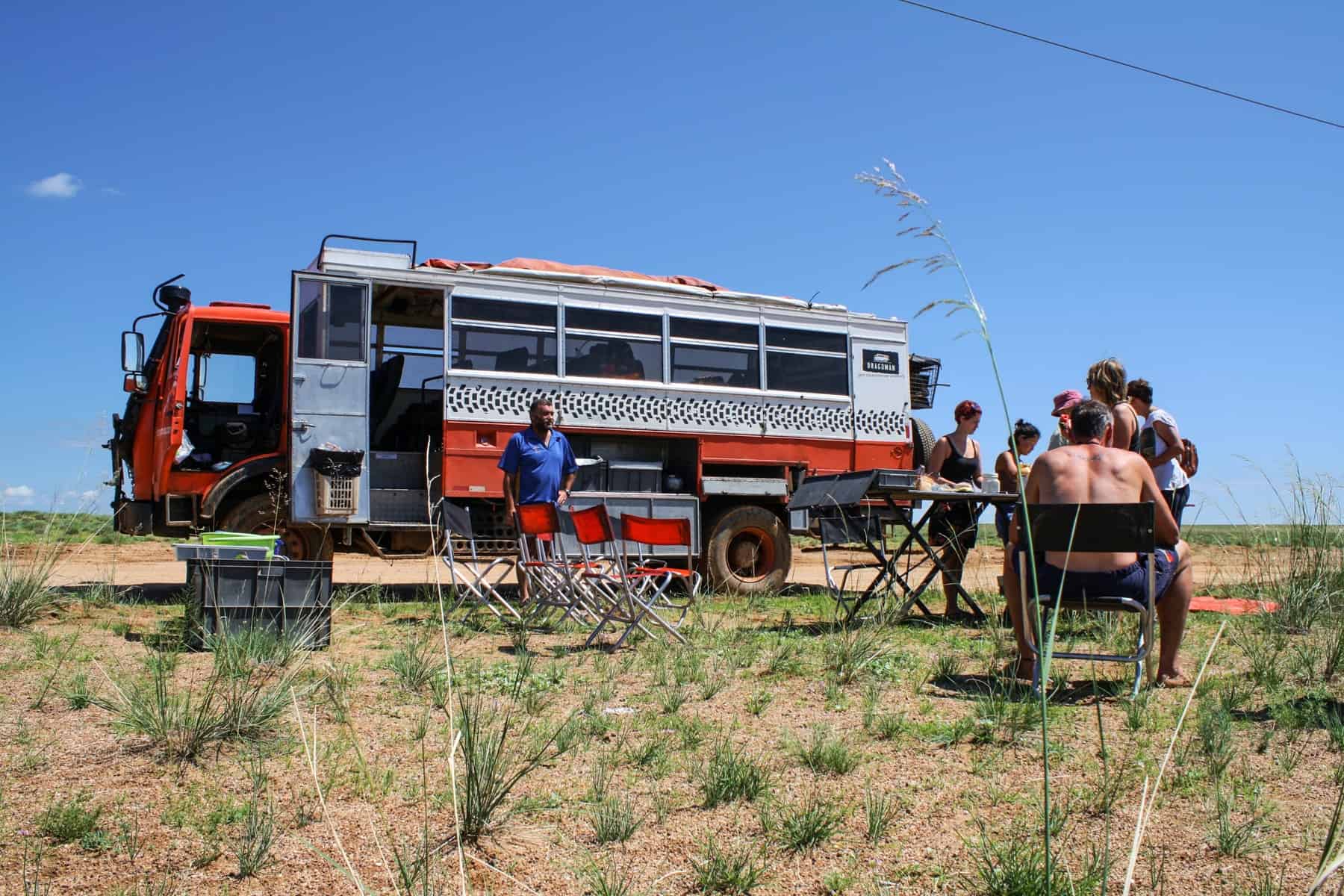
Travel in Mongolia was mostly about camping.
Twenty-three seats, a fridge, a safe, a bookshelf, prominent speakers and a place to recharge equipment, this is where we spend hours at a time, or what could end up being an entire day, traversing the landscape. We filled it with our belongings like a messy bedroom and made it cosy.
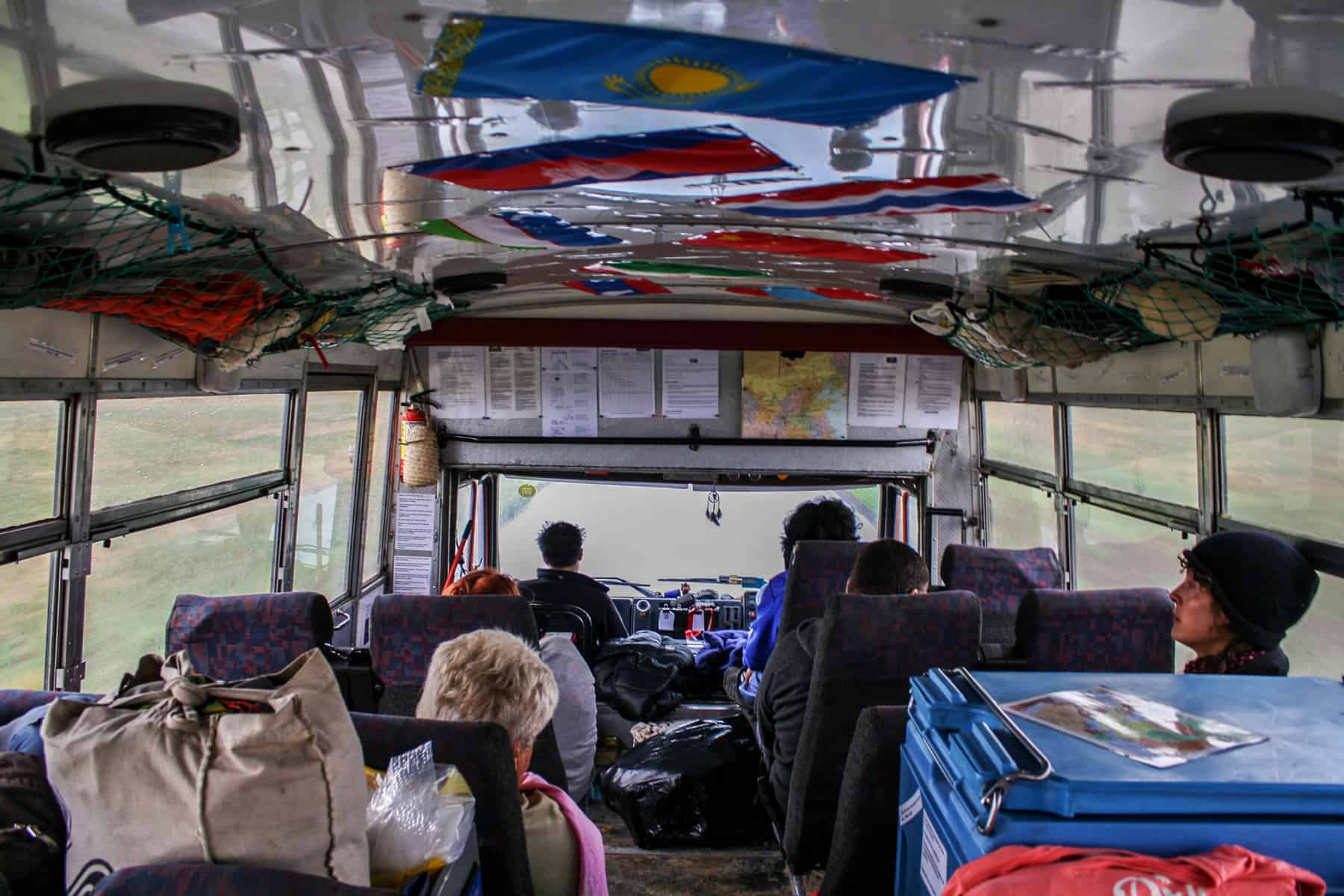
Inside the Overlanding truck on the journey travelling Mongolia
Along the Way
The two drivers are the mechanics, the navigators and the troubleshooters. Everything about the truck, from where it goes and how it gets there, hangs on their decision making, alongside our Mongolian guide who knew the land better than anyone else and could speak the language when we needed to call upon locals for help.
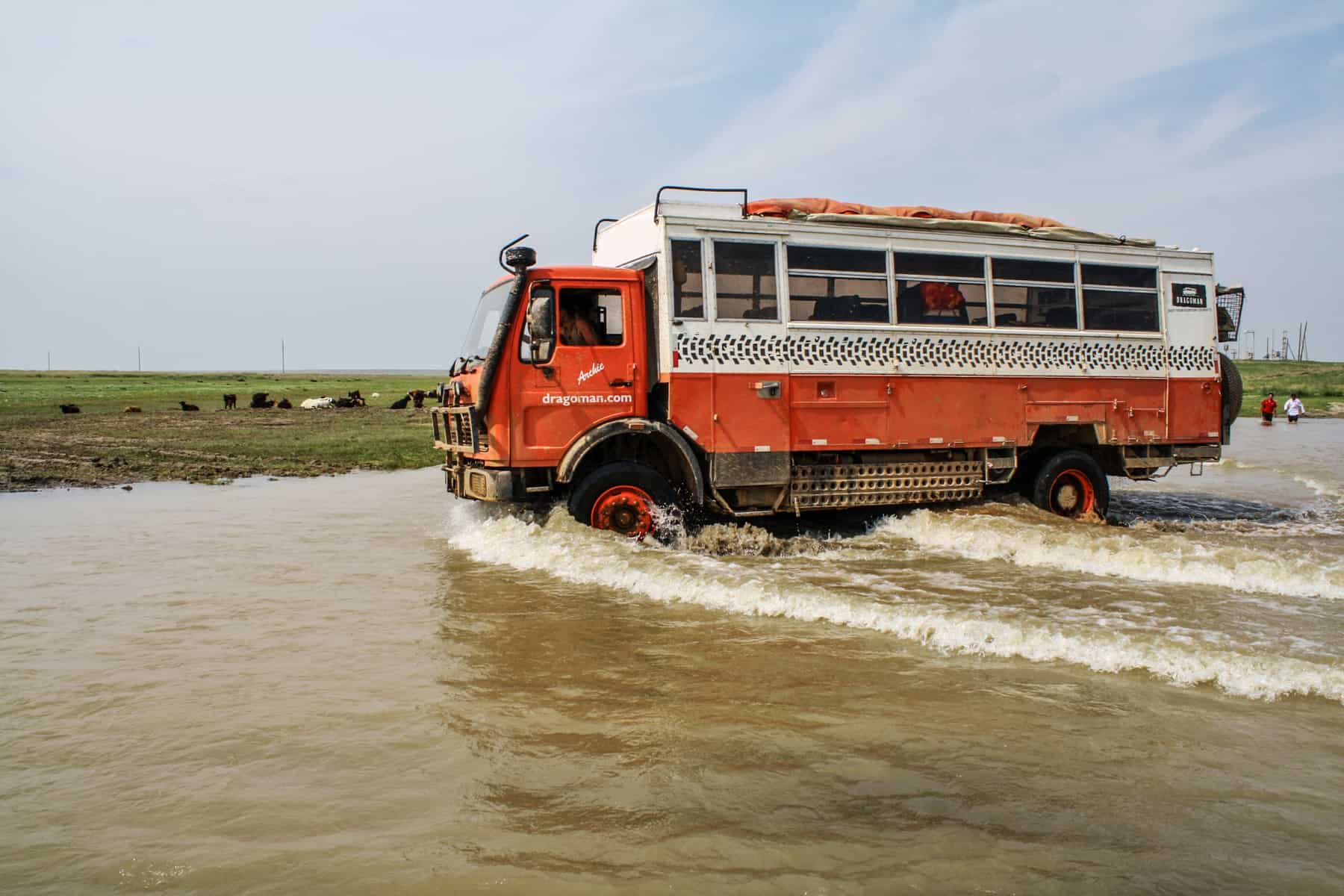
Overlanding in Mongolia was a real adventure.
Although the drivers would jump out to check the road, walking far ahead to determine the best track to take or check waterlogged areas (often by getting in the water) to limit the truck’s chances of getting bogged. We often stopped to help locals whose cars were stuck, knowing that karma would need to be returned one day.
The Realities of Rural Travel in Mongolia
“Ok, guys, you have to get off. It’s not looking good.” This phrase, accompanied by the engine’s low hum and strain as it finally gave up, became a regular occurrence during the three weeks I spent in Mongolia. Getting dirty in Mongolia is a given, but I never thought on my travels that I would push a truck out of thick, stodgy mud, build a road complete with a dam or wade knee-deep through a river to get to the other side.
In Mongolia, aside from the small handful of roads available, you will take the path less travelled, one that hasn’t been used for days or worn in by other vehicles for an easy pass. You could call it bad luck, or you could call it a reality, but travel comes with its challenges and getting stuck in Mongolia is by far the most common. While I wasn’t expecting substantial bogging incidents on this trip, I began to embrace them when they did happen. After all, the locals have to face these situations regularly. It became a part of what Mongolia is and what it means to cross her lands.
The drivers of the truck were responsible for assessing each situation when it arose. They were the first to get dirty, walk through the water and determine the outcome. At times it put you on edge, wondering how long you would be stuck somewhere with no one passing by for hours. At other times it merely meant us having to walk a short distance to lighten the truck.
Either way, the result was a massive whoop and roar for our truck, Archie, when he made it through. It felt good, and we then knew the next stage of the journey could begin. These are the times I’ll always remember.
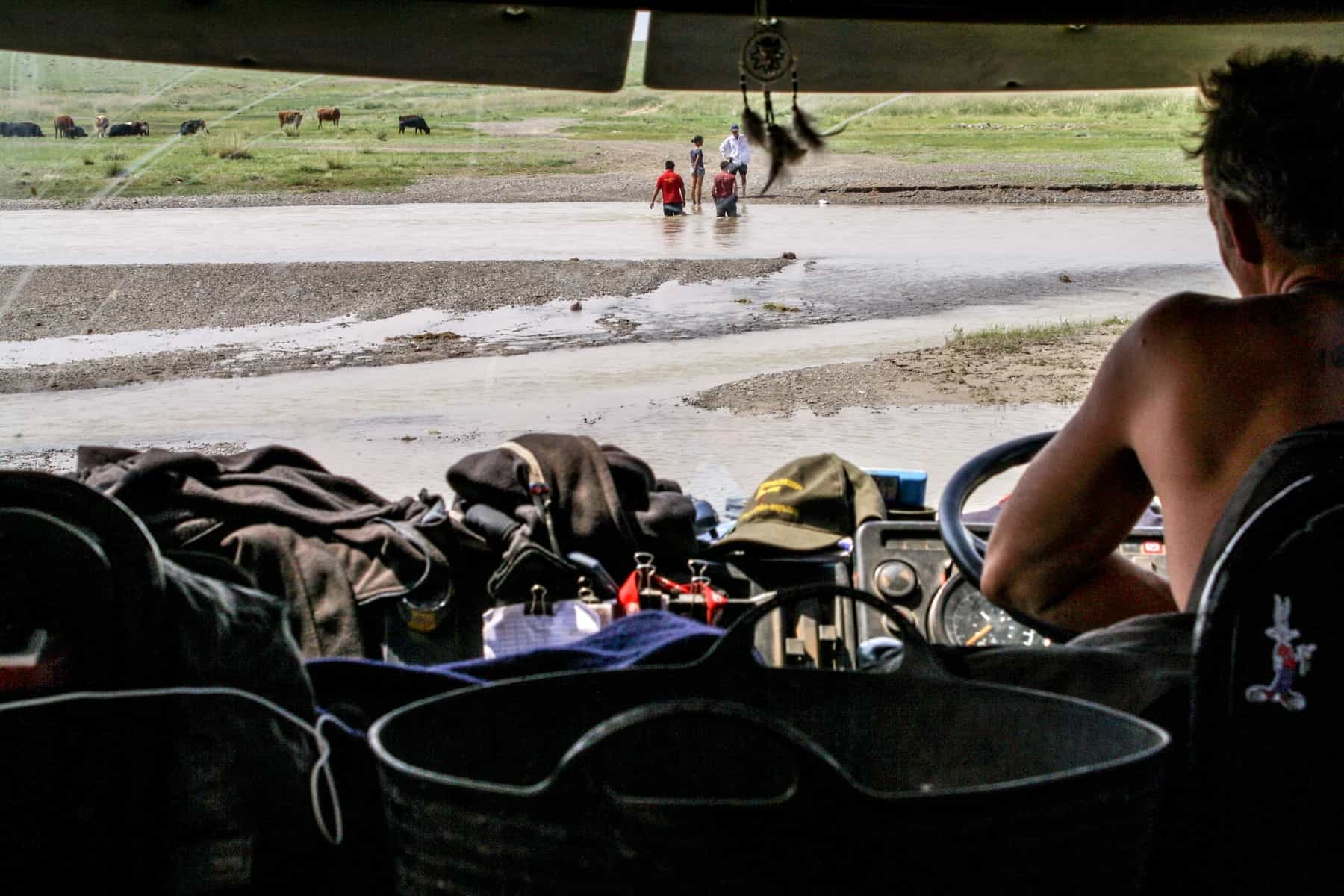
Our group helps find a track in the water for the truck to pass in Mongolia.
It had been raining on and off for a few days, mainly in short spurts in the evenings, and we were bumping along the wet dirt tracks just fine. When the truck stopped, and we saw that two pools of water had filled two road tracks, we knew a bogging incident was imminent. The drivers walked, pondered and walked through the water. Could we drive through it without getting stuck?
The usual scenario rested on two possibilities – drive through it or find hard enough ground around it. Except that this time it was different. We were told: “We need to empty this road of water and then let the ground dry out so we can cross over it.”
Cue the mad dash to empty our camping gear to find our plastic washing-up bowls and any other form of a plastic container to begin the removal process. The ladies rolled up their shorts to get right in there and scoop out the water as the men started digging to create a road. Everyone built a dam by hand on each side of the tyre track grooves so that the emptied water wouldn’t flow back in.
It was hard work, but we became a team, a great team. The sun was shining that day which meant we only had to wait a couple of hours while the heat dried out our creation. We ate, we played, we sang, and we marvelled at what resourceful people we were. It was a scary moment when Archie made his move to cross our road (our beautifully crafted highway that could be crushed in seconds and need rebuilding), but he made it in one unbeaten run, and our handmade route was left to the land and in nature’s control.
Happening upon grassy, muddy areas is sporadic. You can never tell exactly how hard the ground is beneath it. After bouts of rain, the ground softens, and even though there were times when the truck had to work a little harder, it made it through.
We had just had a fantastic afternoon checking out a local Nadaam festival and were in high spirits, which we needed knowing that we would be driving for the rest of the day. Except we didn’t – we were soon stuck in thick, sticky mud, and no amount of pushing and revving was going to change it.
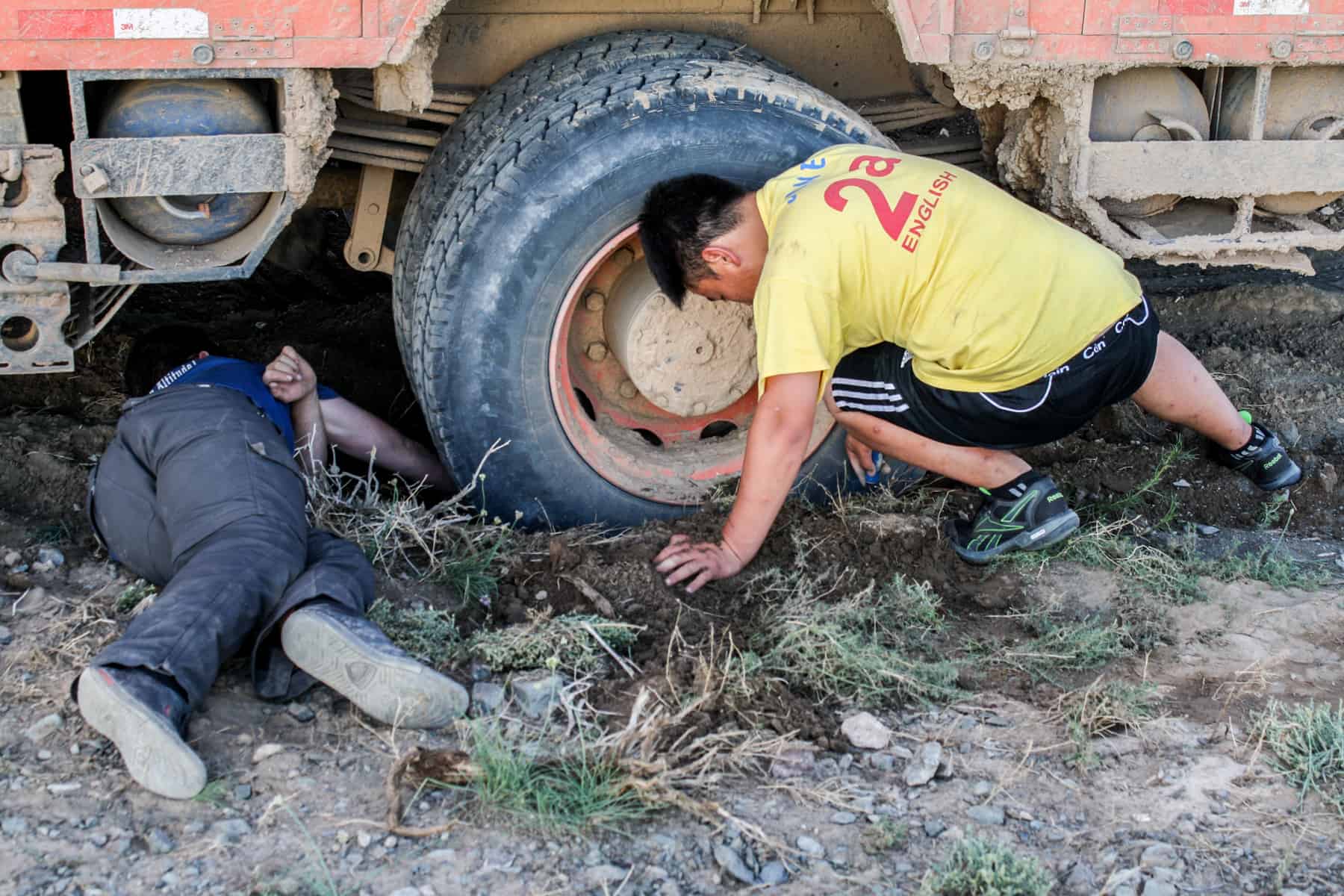
Digging out the truck wheels from the deep, wet mud in Mongolia
Our Mongolian guide walked to the nearest ger to get help, and the locals later returned on a motorbike to check out the situation. The whole family came out – we regularly became a source of fascination or amusement en route through the country. However, they kindly decided to use their big, industrial tractor to help pull the truck out of the mud – that too got stuck.
With two vehicles out of action and night starting to fall, we decided to set up camp on a drier patch of land nearby, and the drivers worked relentlessly with the locals throughout the evening. We got bogged at 5 pm, and it took until midnight for the truck to be pulled from sludge. It was a day wasted, but another example of how unpredictable travelling here can be.
When the truck stops dead at a deep area of water, you know the situation isn’t going to be resolved quickly. Can a truck this size pass through a river without sinking or getting stuck? Although we enjoyed paddling in the freshwater, we didn’t know whether we could have to completely re-route to get around it and lose more time.
The conclusion was that there was a distinct lack of knowledge about alternative roads around the river, and somehow we would have to find a way to get through it. With a small truck already stuck right in the middle, it was a scary prospect.
The drivers identified the most shallow and hard ground area in the water to pass, although we couldn’t be on the truck, unfortunately. You can imagine the chaos – a group of locals trying to rescue their vehicle and 20 non-locals trying to navigate through the water, knee-deep and screeching, scared of falling in.
My heart skipped a beat watching our truck splash through the water and wondering whether it would stop dead in its tracks and slowly swim in a sea of mud, taking all our belongings with it. But Archie made it, and this time, he got the biggest cheer. And a giant sigh of relief.
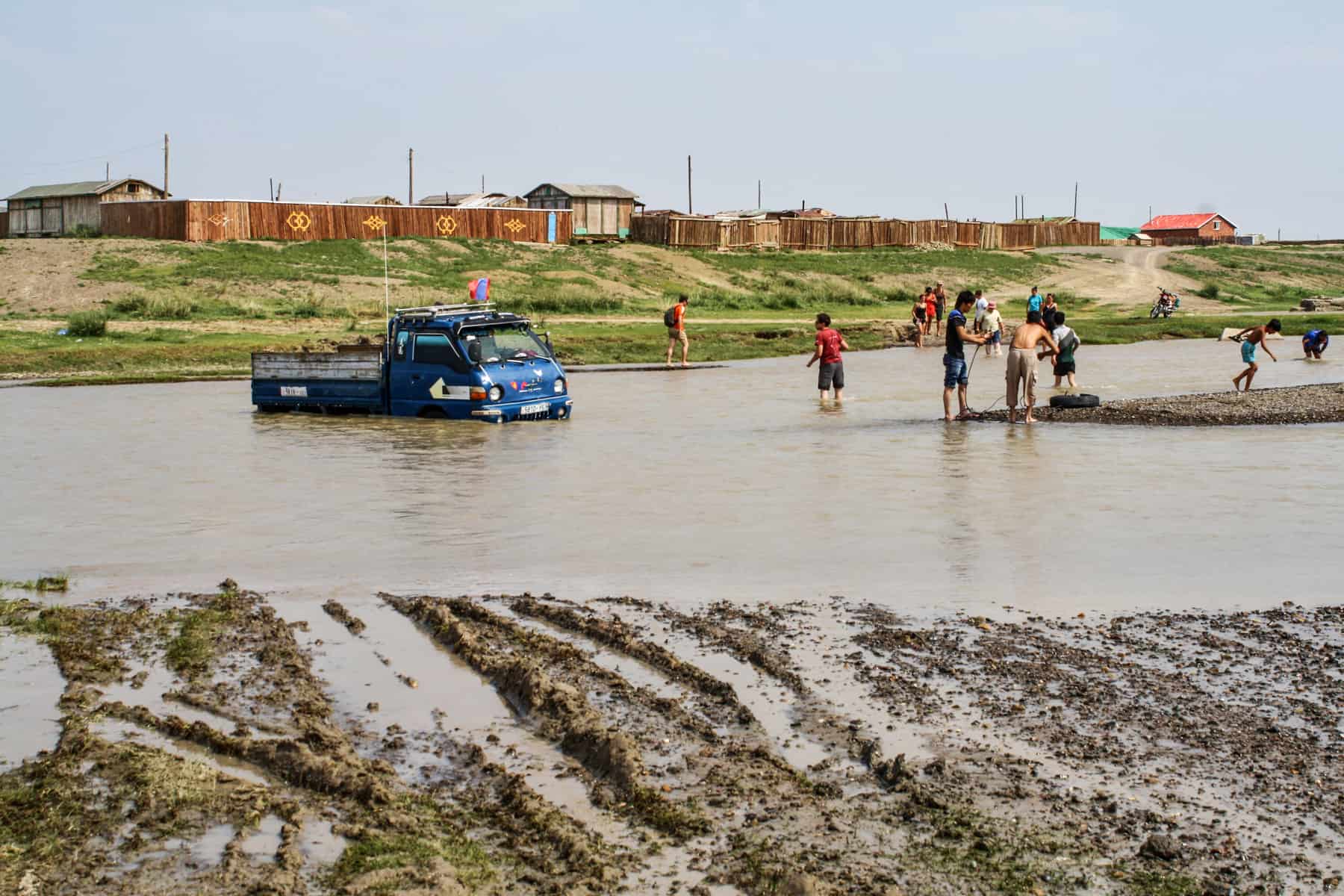
Typical river crossings in Mongolia and helping out locals who were also stuck
With unpredictable weather conditions, a challenging landscape to navigate and a trip mostly comprised of wild camping, packing for Mongolia requires some planning. In short, you need to factor in the following:
- Items of clothing that you don’t mind getting dirty and wholly ruined.
- Clothing layers for the constant switch of hot and cold climates – thermals to moisture-wicking and waterproof items.
- Sun protection and bug spray for mosquitos and sandflies.
- All medications you need as you’ll often be far from any significant stores or aid.
- Snacks from home as the food variation can get very repetitive.
For a more extensive overview, read my full Mongolia Packing List .
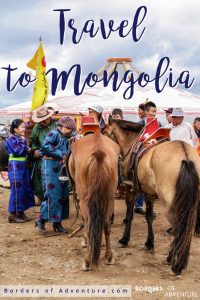
About Becki
Becki Enright is a British Travel Press Award-winning writer whose work focuses on changing perceptions about misunderstood aspects of destinations. Her writing combines storytelling with insight into the social, historical, political and economic factors that shape the country or place in relation to tourism. Becki has appeared live on Sky News and CNN and has contributed to high profile media including National Geographic, Time.com, Guardian online, New York Times, Grazia and Buzzfeed.
- Article Archives
- Work with me
- Privacy Policy

UN Tourism | Bringing the world closer
- Asia and the Pacific
Nomadic Culture and Tourism in Mongolia: Revitalization of Community through Sustainable Tourism
Share this content.
- Share this article on facebook
- Share this article on twitter
- Share this article on linkedin

The UNWTO Regional Support Office for Asia and the Pacific (RSOAP) is hosting the seminar, Nomadic Culture and Tourism in Mongolia: Revitalization of Community through Sustainable Tourism on December 16, 2014 in Nara, Japan.
In response to Mongolia’s increased focus on tourism, diverse stakeholders gather together to discuss the challenges, benefits, and strategies of developing and promoting sustainable tourism in Mongolia. The seminar will further existing efforts and explore new international partnership opportunities.
Time: Seminar Session: 10:00 – 12:00 Networking Session: 12:00 – 13:00
Location: Nara Prefecture New Public Hall, 101 Kasugano-cho, Nara, Japan 630-8212
Languages: English, Mongolian, Japanese (simultaneous interpretation)
To register please visit: http://www.unwto-ap.org/english/cgi/news/index.cgi?no=54
The seminar is co-organized by: University of Shiga Prefecture Nara Women's University Shizuoka University
Under the auspices of: Mongolia Ministry of Culture, Sport, and Tourism (MCST) Japan Tourism Agency (JTA) Japan Association of Travel Agents (JATA) Nara City
SEMINAR PROGRAM (Subject to minor changes)
10:00 Official Opening
Tadaaki Asanuma, Chief of UNWTO Regional Support Office for Asia and the Pacific; President of Asia-Pacific Tourism Exchange Center (APTEC)
Masako Okano, Director of International Tourism Division, Japan Tourism Agency (JTA)
Presenters:
10:10 Mongolian Heritage Crusade: Perspectives from Mongolia and China Uradyn E. Bulag, Reader in Social Anthropology at University of Cambridge
10:35 The Future Opportunities of Cultural Heritage as a Tourism Resource in Mongolia Sampildondov Chuluun, Director at Mongolian Academy of Sciences Institute of History
11:00 Current Situation and the Future of Mongolia Tourism Banzragch Margad, Head of Department, Mongolia Ministry of Culture, Sport, and Tourism
11:15 Winter Tourism in Mongolia Lundaa Davaajargal, Counsellor of Commercial and Economic, Embassy of Mongolia in Japan
11:30 Panel Discussion Moderator: Akira Ohno, Professor in Social Society, Department of Sociology at Shizuoka University
12:00 - 13:00 Networking Session
Category tags
Related content.

2nd UN Tourism Regional Conference on the Empowerment o...

UNWTO Asia-Pacific Workshop on Measuring the Sustainabi...

2021 Global Golden Tourism Forum

UNWTO Regional Conference on the Empowerment of Women i...

Mongolia’s Tourism: Navigate Wonders With Sustainability
Mongolia, with its vast steppes, rugged mountains, and nomadic traditions, has long been a hidden gem for travelers seeking authentic experiences. However, the increasing global awareness of environmental conservation has prompted a shift in Mongolia’s tourism landscape. The nation is transitioning from conventional tourism to a more sustainable approach, emphasizing ecotourism. This change not only preserves Mongolia’s pristine landscapes but also fosters economic development in harmony with nature.
Changing Tides in Mongolia’s Tourism:
Traditionally, Mongolia’s tourism has witnessed a surge, attracting adventurers with its unique blend of nomadic culture and untouched wilderness. However, the downside has been the environmental impact of mass tourism. In recent years, there has been a paradigm shift in the Mongolian tourism sector. The government, recognizing the importance of sustainable practices, has implemented stringent regulations and initiated projects to mitigate the ecological footprint of tourism.
Sustainable Initiatives During Your Mongolia Trip:

One of the key pillars supporting Mongolia’s tourism toward sustainability is the implementation of governmental regulations through the GSTC Framework of Sustainable Tourism Development , a global initiative that has developed criteria and standards for sustainable tourism. These regulations focus on responsible tourism practices, limiting the number of visitors to ecologically sensitive areas and promoting eco-friendly accommodations. Private companies in Mongolia have also joined the movement. Recognizing the potential long-term benefits of ecotourism, many companies are voluntarily incorporating sustainable practices into their operations. From waste reduction to community engagement, these initiatives contribute to the overall goal of preserving Mongolia’s natural beauty.
Mongolia Travel: Examples of Ecotours You Can Choose
For travelers seeking immersive and sustainable experiences, Mongolia offers a plethora of ecotours. One such example is the Three Camel Lodge in the Gobi Desert. This eco-friendly lodge is a pioneer in responsible tourism, promoting conservation and community engagement. Visitors to the Gobi can experience the unique biodiversity of the region while staying in traditional gers (yurts) and participating in various eco-friendly activities.
The Altai Tavan Bogd National Park provides additional fascinating ecotourism opportunities through companies such as Altai Nomads Travel . This initiative focuses on preserving the delicate ecosystems of the Altai Mountains, offering tours that emphasize minimal environmental impact and a deep appreciation for Mongolia’s biodiversity.
Nomadic homestays are gaining popularity through “Ger to Ger,” a community-based tourism initiative . Travelers can experience authentic Mongolian culture by staying with nomadic families, fostering cultural exchange, and directly contributing to the well-being of local communities.
These real-life examples showcase Mongolia’s commitment to sustainable tourism, providing travelers with meaningful and eco-friendly experiences while preserving the country’s natural and cultural heritage.

As Mongolia tourism embraces sustainability, the shift towards ecotourism becomes evident. The combination of governmental regulations, private initiatives, and a growing consciousness among travelers is steering the nation towards a more environmentally friendly and economically viable tourism model. Exploring Mongolia’s untamed beauty through ecotourism not only offers a unique Mongolia travel experience but also contributes to the conservation of this pristine land. So, pack your bags and embark on a Mongolia Trip that goes beyond the ordinary – experience the charm of Mongolia, where nature and culture coexist harmoniously. Curious to explore another Asian country? Why not Laos? Check out out A Guide to Your Laid-Back, Nature-Filled Laos Vacation article.
Would you like to receive more inspiration directly to your email inbox? Please click here to register for Ecotourism World newsletter!

You May Also Like

Creating a Balance: Possible Carbon Offset Programs Based in Japan

An Eco Friendly Trip to China

Exploring the Ancient Terraced Rice Paddies of Asia

©GML/Getty Images

Check out this year's Best in Travel winners
Rugged Mongolia is an adventure destination where travelers can experience vast, untouched landscapes and learn about nomadic culture.
Best Time to Visit
Best places to visit, leave the planning to a local expert.
Experience the real Mongolia. Let a local expert handle the planning for you.
Attractions
Must-see attractions.
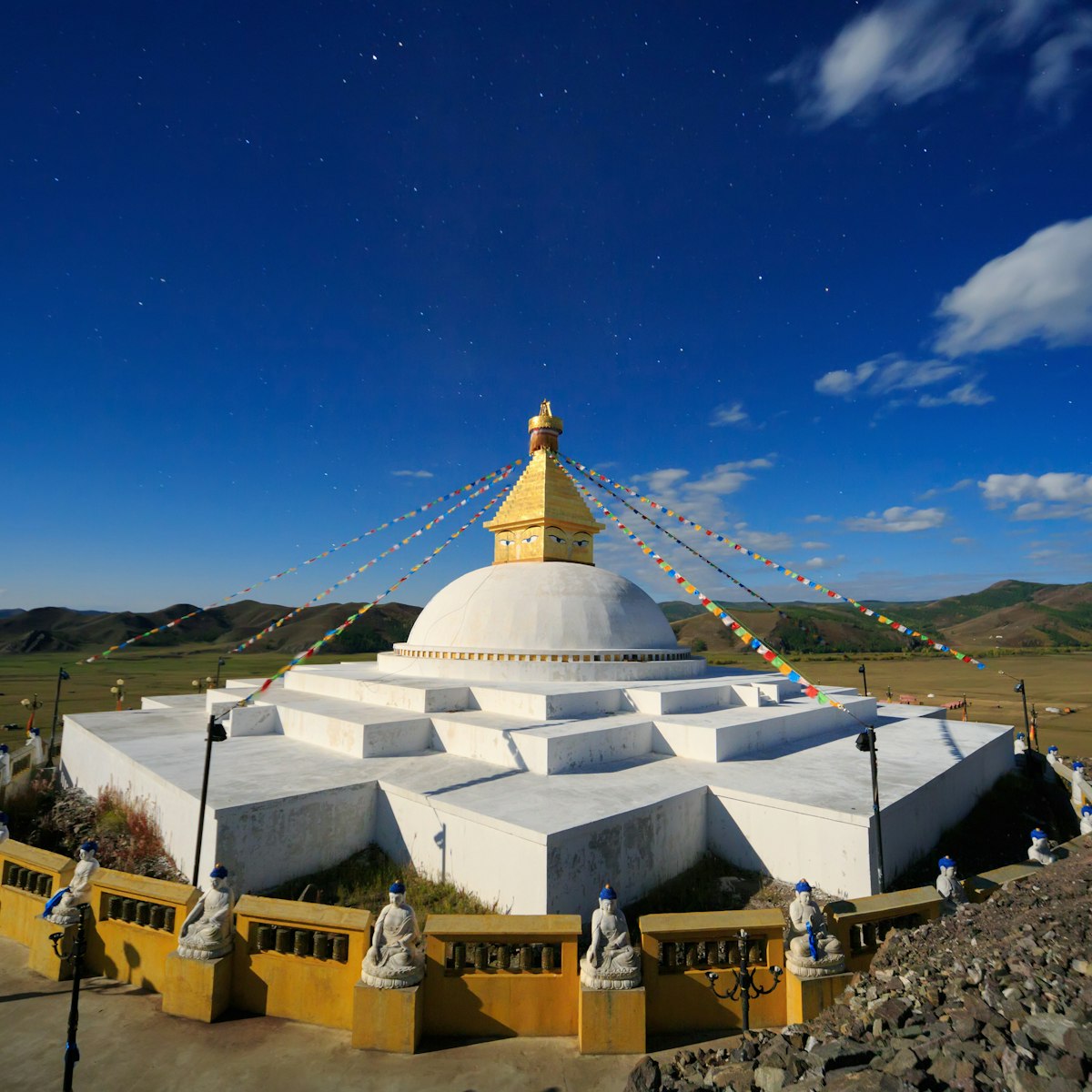
Amarbayasgalant Khiid
Amarbayasgalant Khiid was built between 1727 and 1737 by the Manchu emperor Yongzheng, and dedicated to the great Mongolian Buddhist and sculptor…
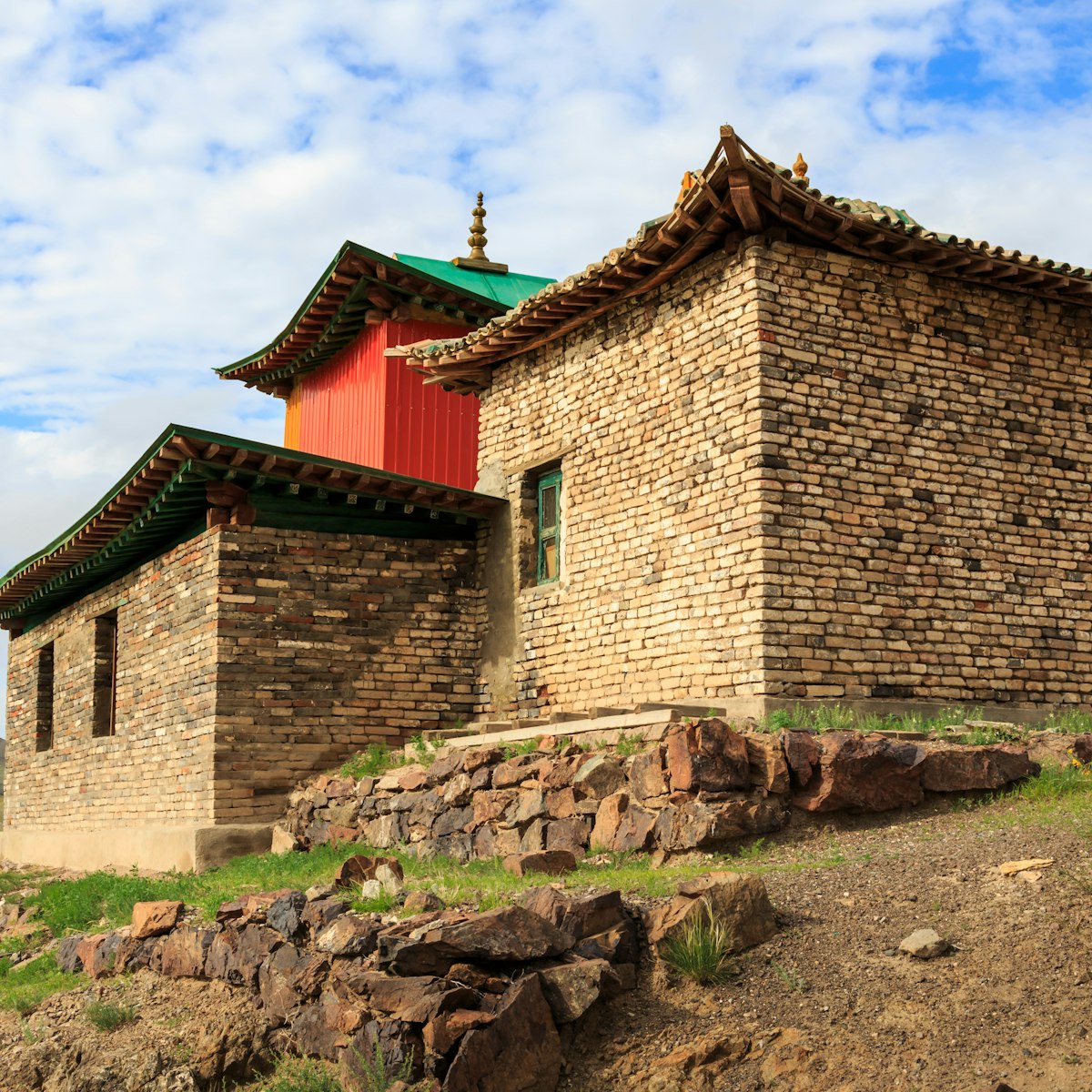
Ongiin Khiid
The bend in the river here marks the remains of two ruined monasteries which are today considered one vast complex known as Ongiin Khiid. Bari Lam Khiid…

Ikh Nartiin Chuluu Nature Reserve
This 670-sq-km nature reserve, only a four-hour drive from Ulaanbaatar, at an elevation of 2200m, is home to hundreds of ibexes (mountain goats), argali …
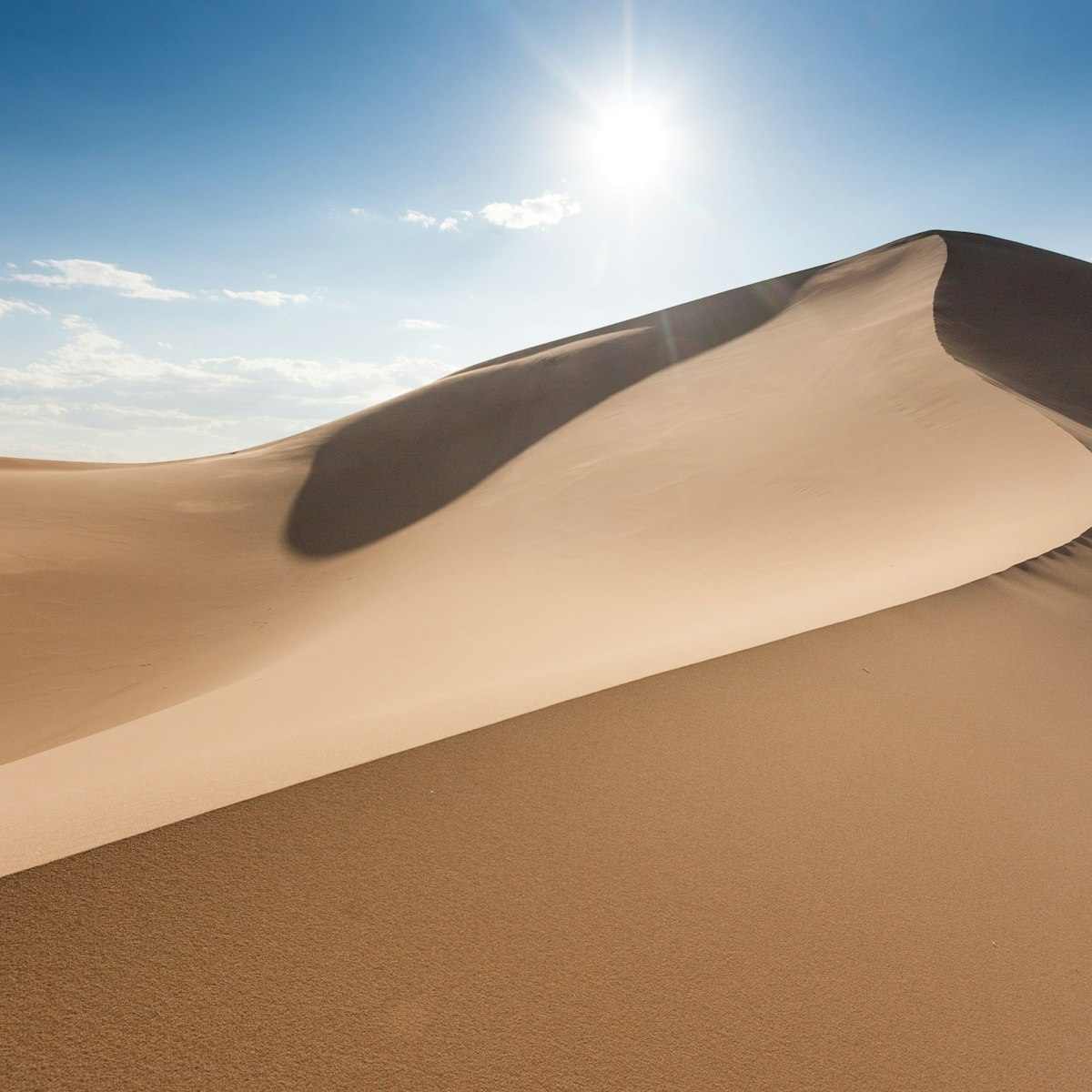
Khongoryn Els
Khongoryn Els are some of the largest and most spectacular sand dunes in Mongolia. Also known as the Duut Mankhan (Singing Dunes – from the sound they…
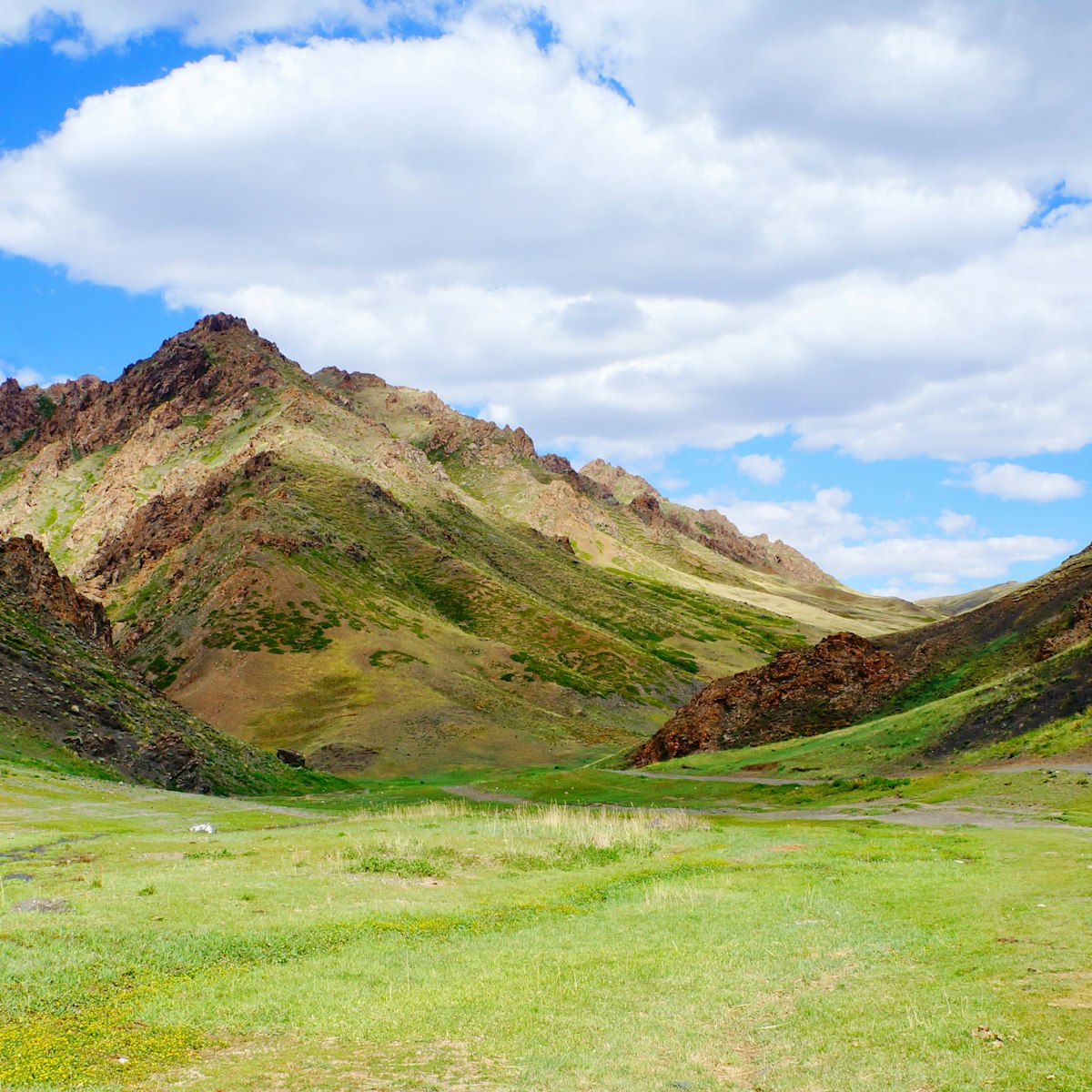
Yolyn Am Gorge
A pleasant 2km path leads from the parking area to this gorge filled with blue ice, one of the park's can't-miss sights. You can hike, bike or hire a…
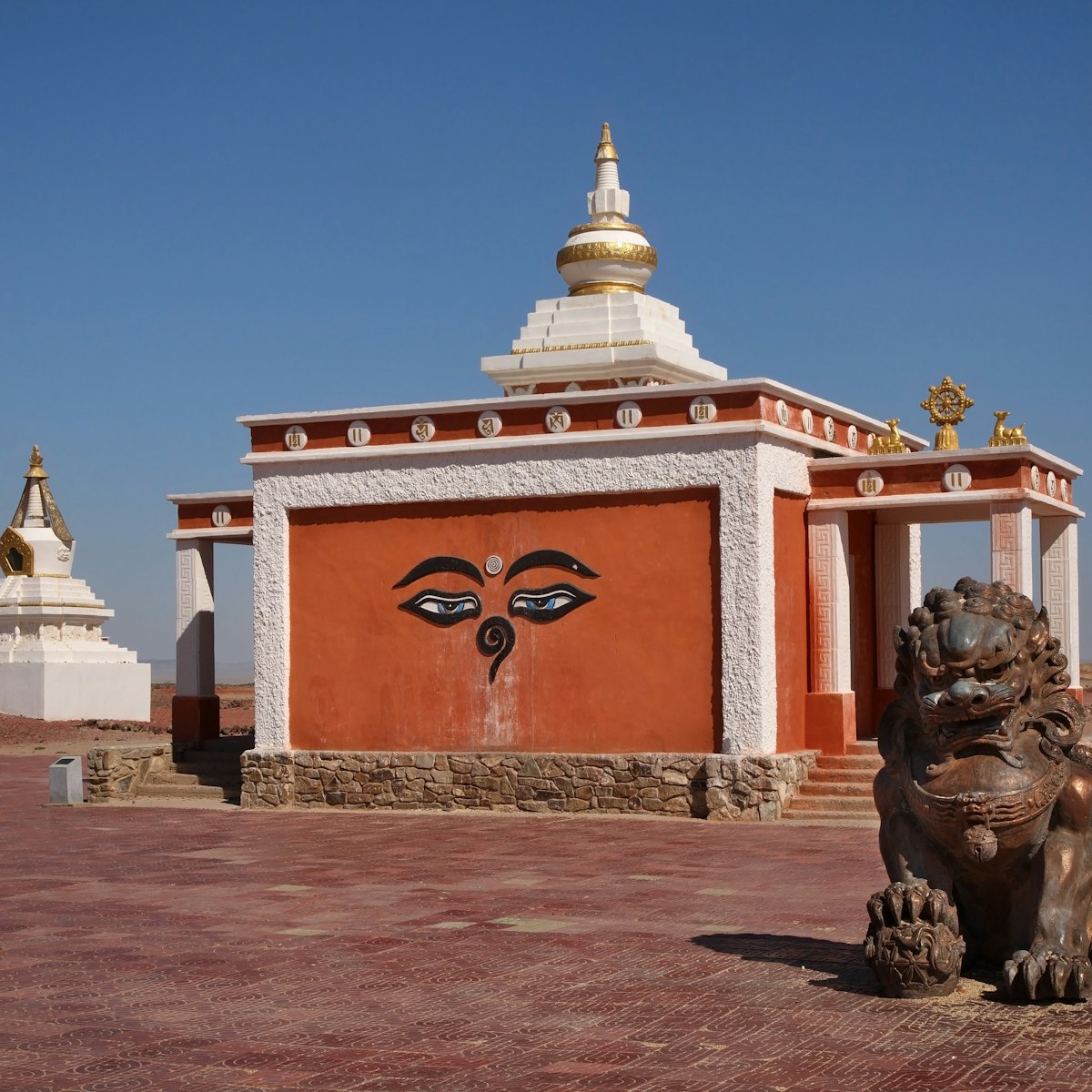
In 1853 Danzan Ravjaa told the local people that he would die in three years but that they could forever come to this place and speak to his spirit…
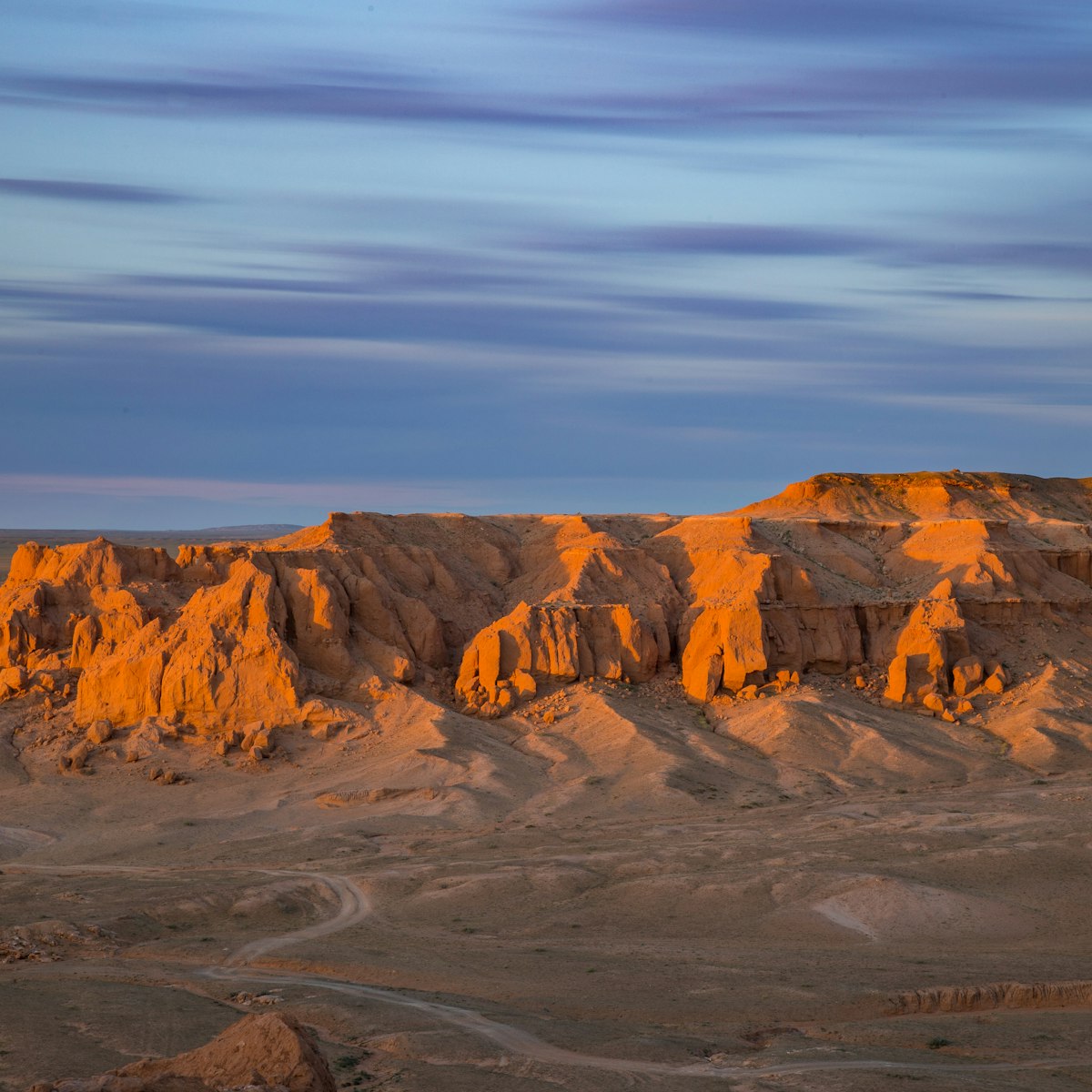
The so-called Flaming Cliffs are a Gobi highlight and an important palaeontology site first excavated by Roy Chapman Andrews in 1922. Even if you are not…

Yolyn Am was originally established to conserve the region's bird life, but it’s now more famous for its dramatic rocky cliffs and narrow, heavily shaded…
Top picks from our travel experts
6 of the best things to do in mongolia.
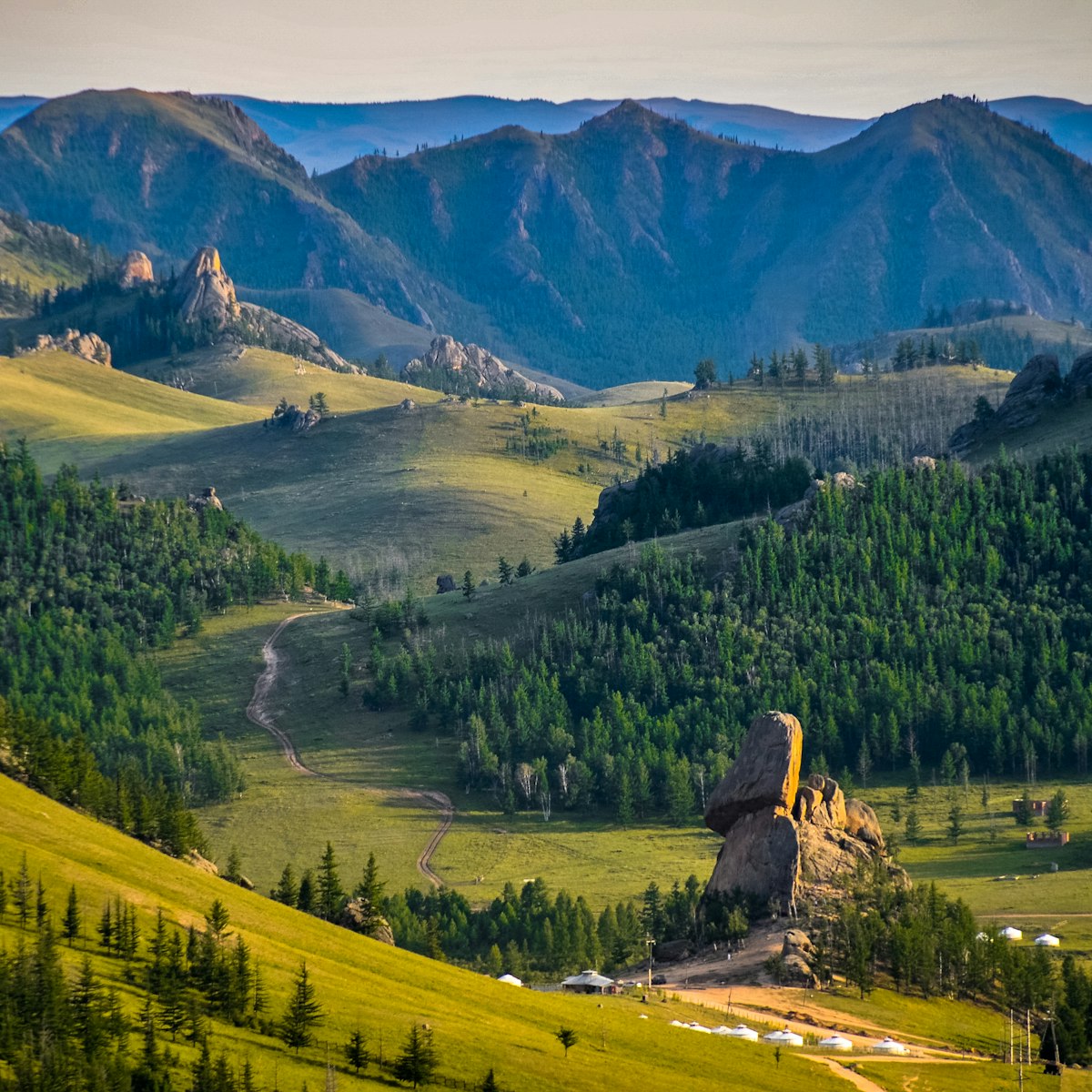
Gorkhi-Terelj National Park
Located 55km northeast of Ulaanbaatar, this popular national park is characterised by picturesque alpine scenery. It offers great opportunities for hiking…

Khermen Tsav
Way off the beaten track; you are likely to have this complex of canyons all to yourself. Some say they are even more spectacular than Bayanzag. Be sure…
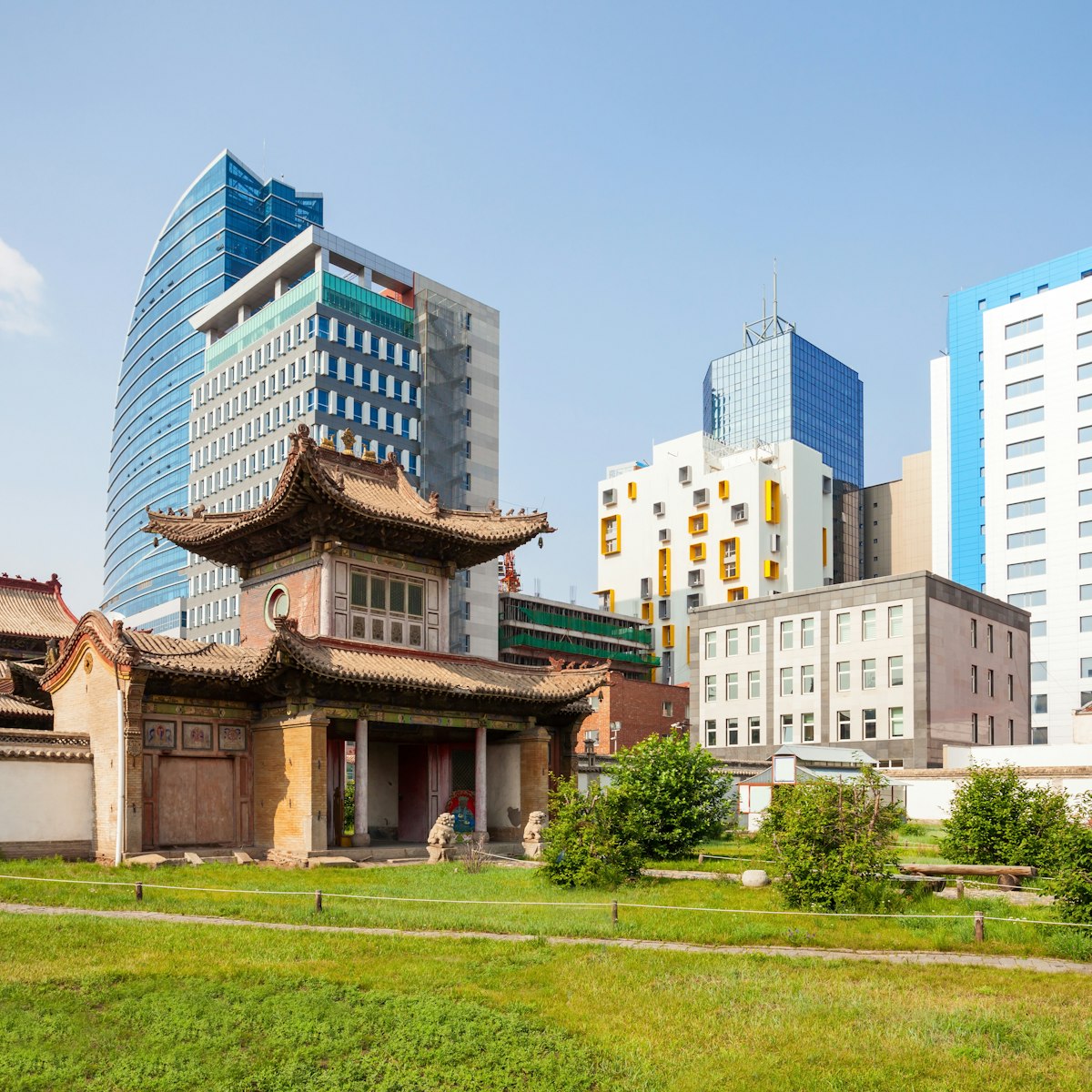
Choijin Lama Temple Museum
Ulaanbaatar
This temple museum smack in the middle of downtown Ulaanbaatar was the home of Luvsan Haidav Choijin Lama (‘Choijin’ is an honorary title given to some…

Khuisiin Naiman Nuur Nature Reserve
The area of Naiman Nuur, which was created by volcanic eruptions centuries ago, is now part of the 115-sq-km Khuisiin Naiman Nuur Nature Reserve. Despite…

Khavtsgait Petroglyphs
If you take the main route from Dalanzadgad to Khongoryn Els, keeping the mountains to your left as you go, you can stop and hunt the hills for this…

Mongolian National Modern Art Gallery
Sometimes called the Fine Art Gallery, this place contains a large and impressive display of modern and uniquely Mongolian paintings and sculptures, with…

Zanabazar Museum of Fine Arts
This fine-arts museum has a superb collection of paintings, carvings and sculptures, including many by the revered sculptor and artist Zanabazar. It also…

Central Museum of Mongolian Dinosaurs
Dinosaurs of all shapes, sizes and appetites once roamed the Gobi Desert. Their fossilised bones and eggs were first uncovered by American explorer Roy…

Sükhbaatar Square
In July 1921 in the centre of Ulaanbaatar, Damdin Sükhbaatar (the ‘hero of the revolution’) declared Mongolia’s final independence from China. A square…
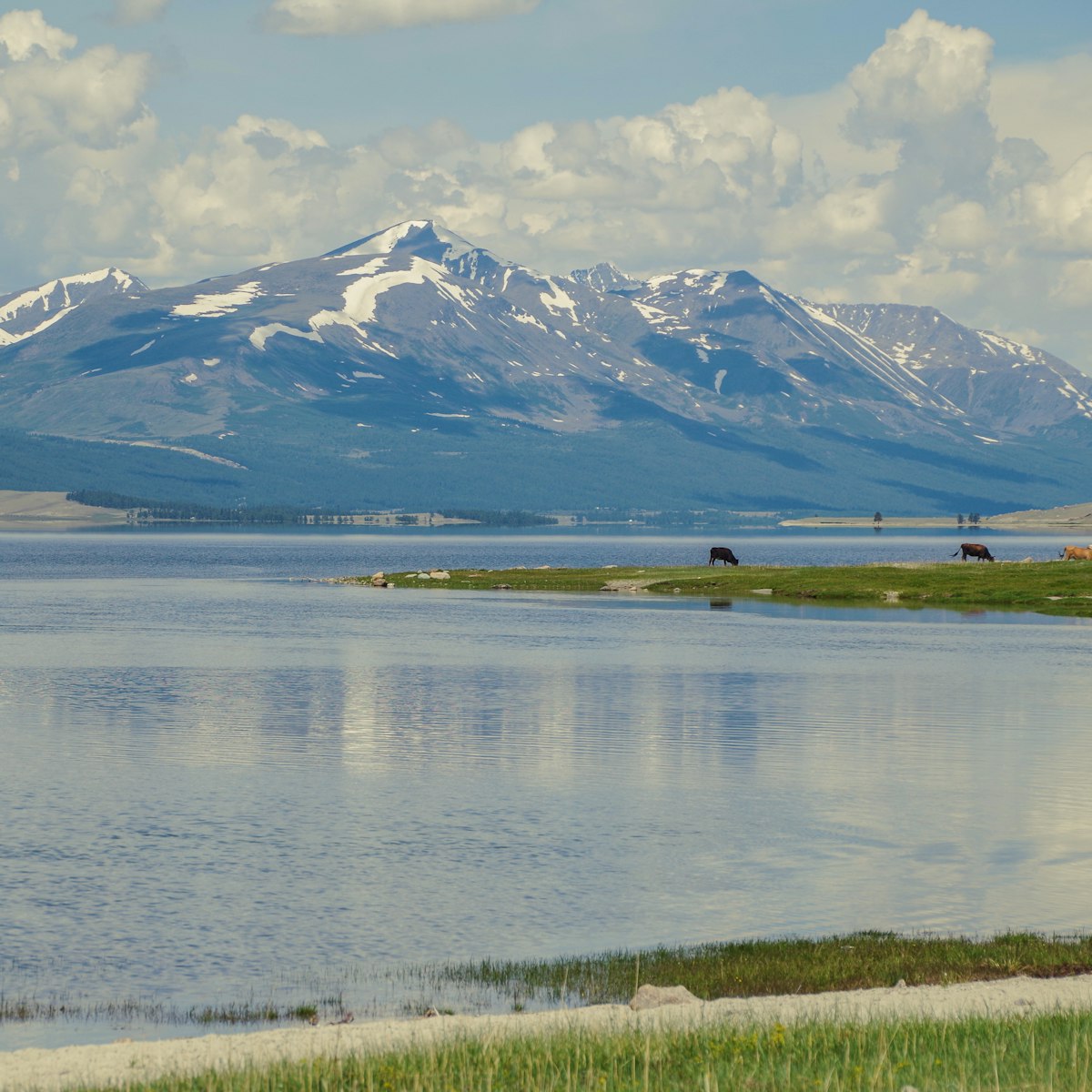
Altai Tavan Bogd National Park
Western Mongolia
Covering 6362 sq km, Altai Tavan Bogd National Park takes in the Tavan Bogd massif – which includes Khuiten Uul (4374m), Mongolia's highest mountain…
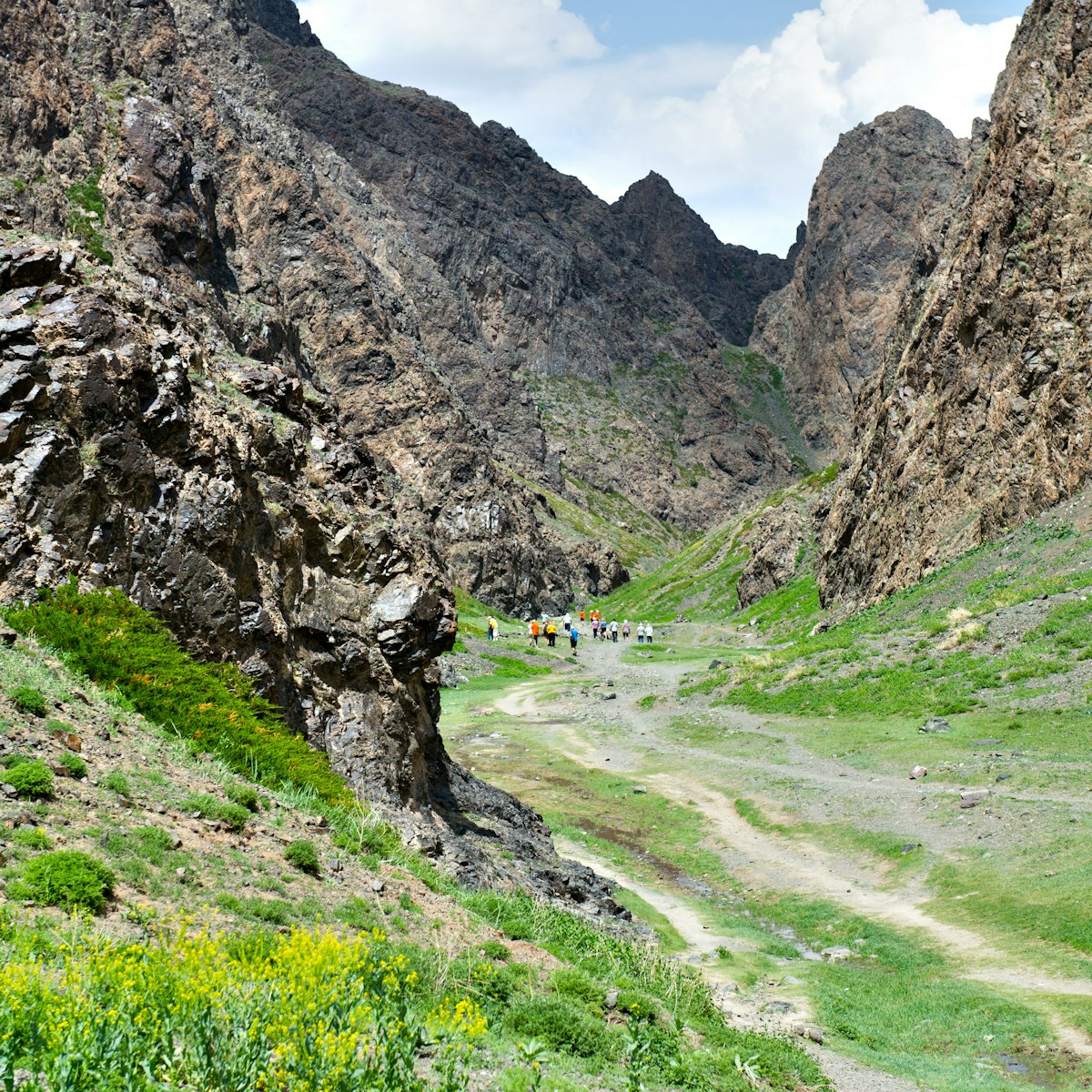
Gurvan Saikhan National Park
Gurvan Saikhan National Park (20,000 sq km) offers a wealth of sand dunes, canyons, dinosaur fossils and mountainous terrain. Desert wildlife includes…

Gandan Khiid
Around the start of the 19th century more than 100 süm (temples) and khiid (monasteries) served a population of about 50,000 in Urga (the former name of…

Ancient Karakorum
Stretching out for about 1km east of town is the site of ancient Karakorum. The foundations of Karakorum’s buildings are all underground and little has…

Bogdkhan Uul Strictly Protected Area
The Bogdkhan Uul is said to be the world’s oldest nature reserve. Established in 1778, the park was guarded by 2000 club-wielding lamas. Animal poachers…
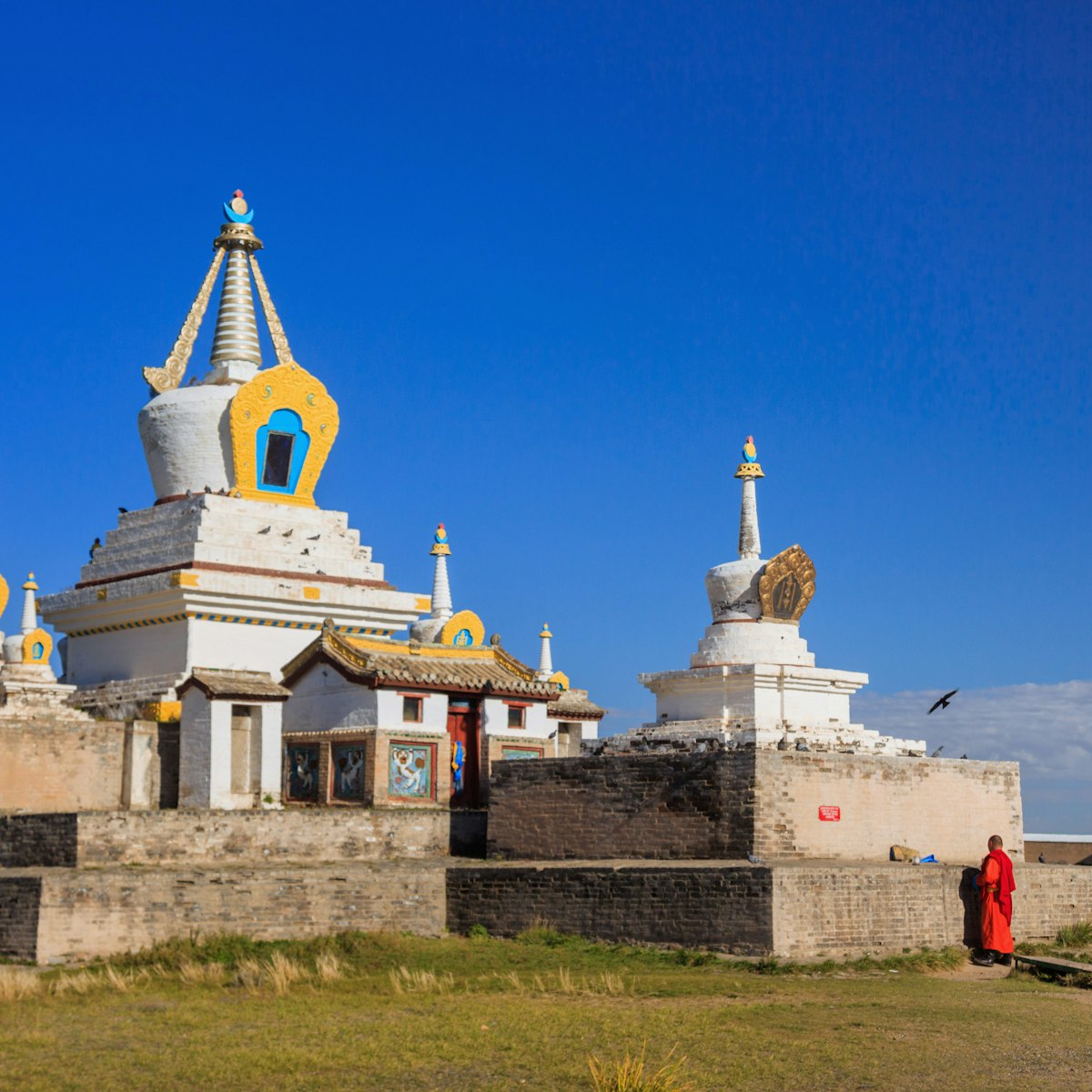
Erdene Zuu Khiid
Founded in 1586 by Altai Khaan, Erdene Zuu (Hundred Treasures) was the first Buddhist monastery in Mongolia. The monastery went through periods of neglect…
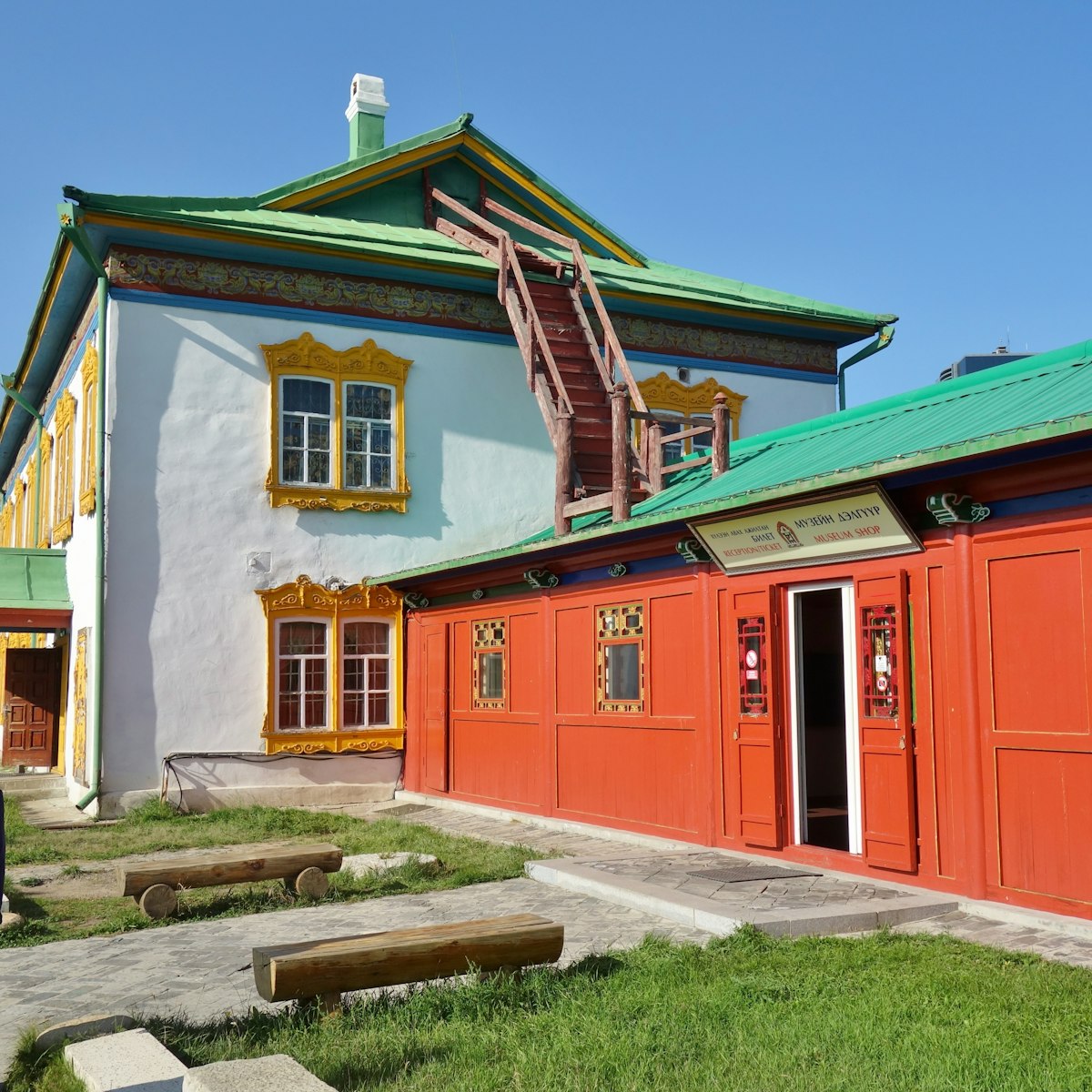
Winter Palace of the Bogd Khan
Built between 1893 and 1903, this palace is where Mongolia’s eighth Living Buddha, and last king, Jebtzun Damba Hutagt VIII (often called the Bogd Khan),…
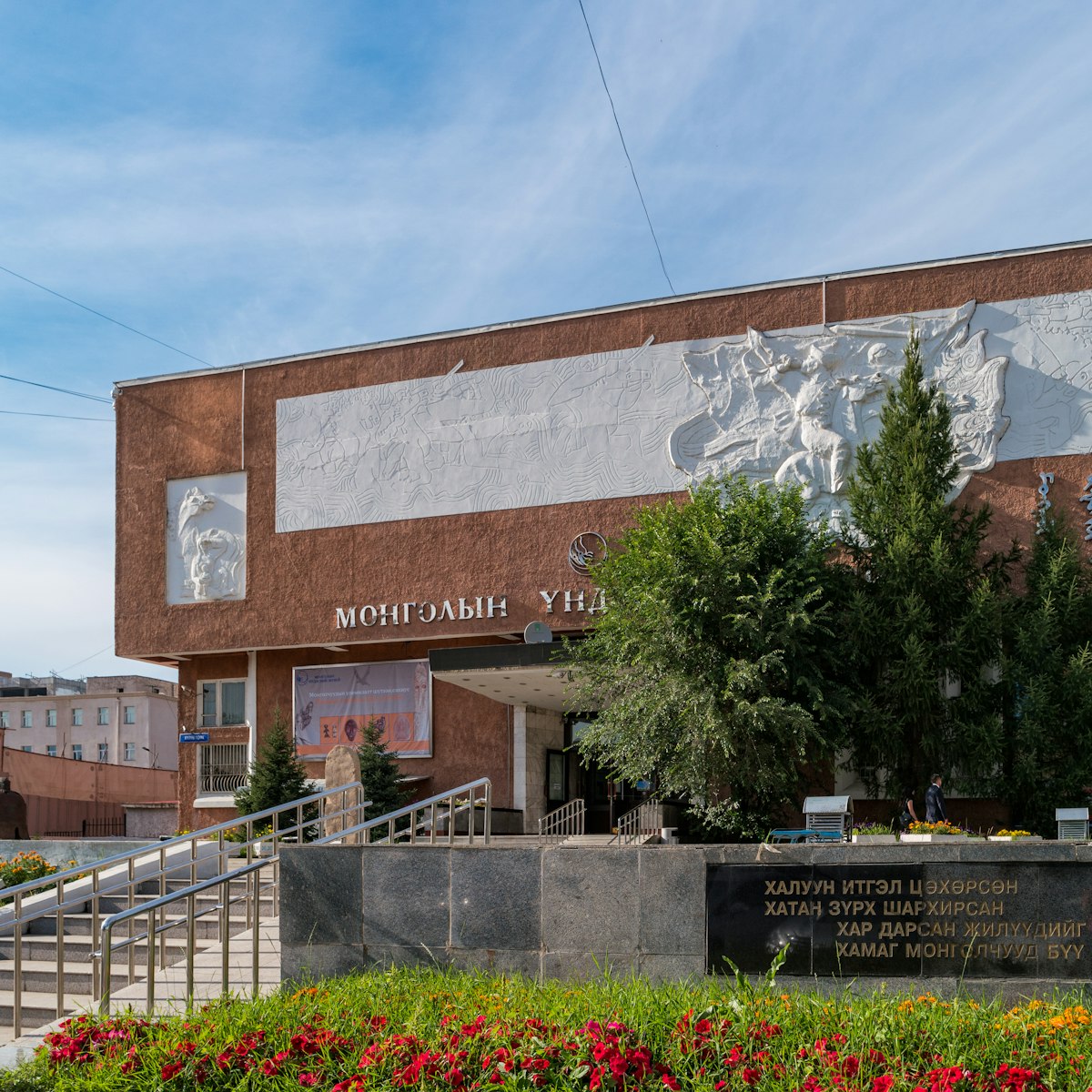
National Museum of Mongolia
Mongolia’s wonderful National Museum sweeps visitors from the Neolithic era right to the present day. It’s UB's only genuine blockbuster sight, offering…
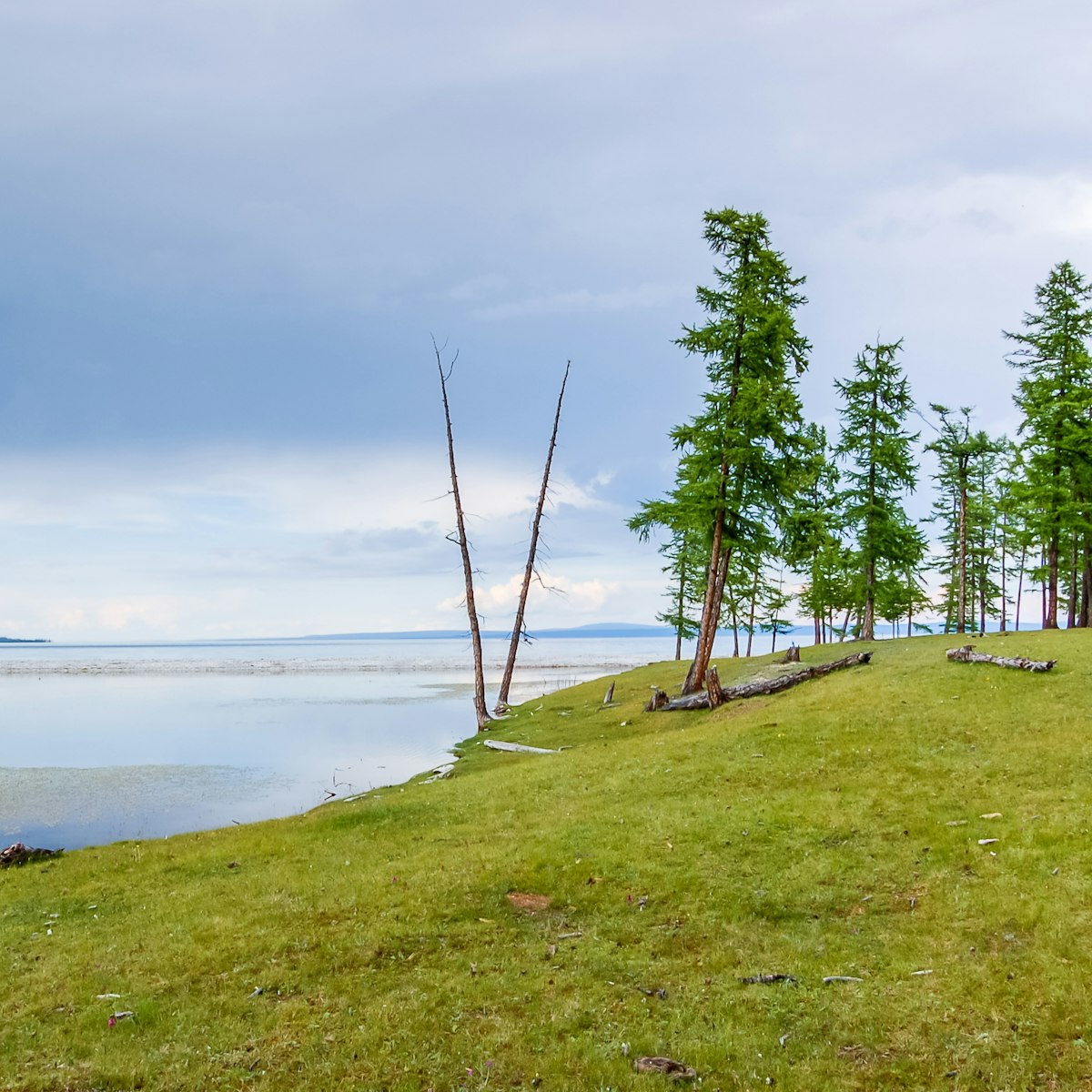
Khövsgöl Nuur National Park
Cupped in the snowcapped fist of the Sayan and Khoridol Saridag mountains, this national park is anchored by the shimmering blue sweep of the ice-cold,…
Planning Tools
Expert guidance to help you plan your trip.
Best Things to Do
Mongolia is an adventure like no other. Experience the very best of the country with these top activities.
Things to Know
With planning and booking tips along with info on health, safety and etiquette, here's what first-time visitors should know before traveling to Mongolia.
Transportation
Getting around in Mongolia is a proper adventure. Here’s how to go about it.
Visa Requirements
Been dreaming of Mongolia's vast unspoiled landscapes? We've got good news – getting a visa is now even easier. Here's everything you need to know.
Money and Costs
Some things are expensive in Mongolia, but there are still ways to experience this fascinating country on a budget. Here’s how.
Best Road Trips
Imagine bouncing over rolling grasslands in a 4WD, with nothing but rolling green steppe extending in every direction. This is road-tripping, Mongolian style!
Traveling with Kids
Mongolia is a very special place for a family adventure. Explore nomadic lifestyles, see pristine nature, and create unforgettable memories.
Plan with a local
Experience the real Mongolia
Let a local expert craft your dream trip.

Latest stories from Mongolia
Filter by interest:
- All Interests
- Adventure Travel
- Art & Culture
- Beaches, Coasts & Islands
- Food & Drink
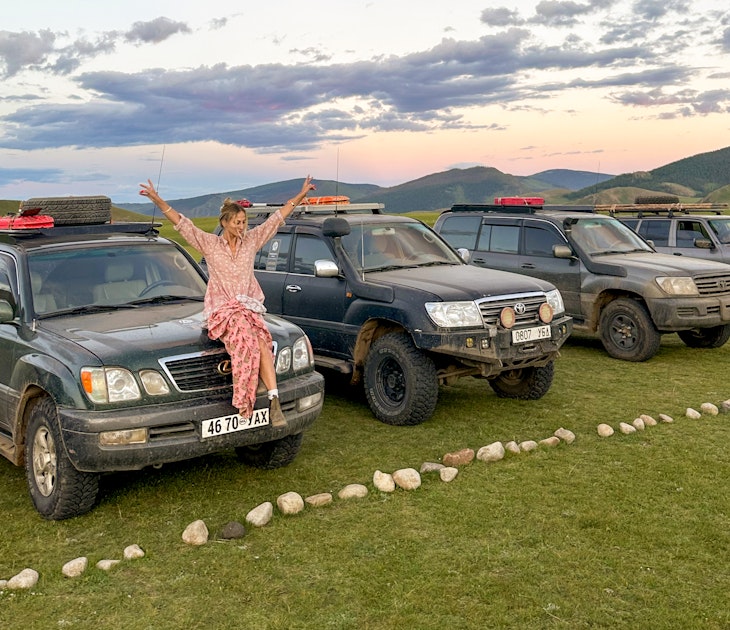
Best in Travel
Oct 30, 2023 • 3 min read
Mongolia has so much to offer travelers looking for wide open spaces, adventure and culture. Here's what it is like to travel there.

Sep 30, 2023 • 6 min read

Sep 28, 2023 • 4 min read
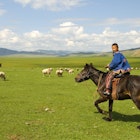
Sep 22, 2023 • 10 min read

Aug 30, 2023 • 9 min read
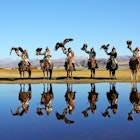
Aug 27, 2023 • 5 min read
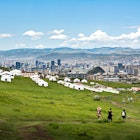
Aug 25, 2023 • 7 min read
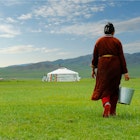
Aug 24, 2023 • 9 min read
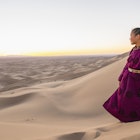
Aug 20, 2023 • 7 min read
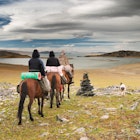
Aug 12, 2023 • 6 min read
in partnership with getyourguide
Book popular activities in Mongolia
Purchase our award-winning guidebooks.
Get to the heart of Mongolia with one of our in-depth, award-winning guidebooks, covering maps, itineraries, and expert guidance.
Mongolia and beyond
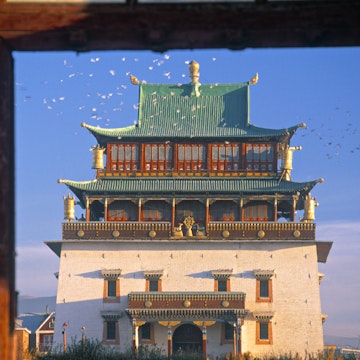
- Share full article

Why Are So Many Millennials Going to Mongolia?
In an era of Instagram tourism, some young people are searching for less curated travel experiences. So they’re flocking to the open spaces of this East Asian nation.
A view from the paved road winding west out of Ulaanbaatar, the capital of Mongolia, into the steppe. Credit... Lauren Jackson/The New York Times
Supported by

Photographs and Text by Lauren Jackson
Lauren Jackson drove for 45 hours across Mongolia, meeting fellow millennials along the way.
- Sept. 13, 2023
It was near midnight, in a storm, on a dirt road in the middle of Mongolia. Still, the river seemed manageable.
My cousin Cole Paullin and I were searching for a place to camp, and I was exhausted from a long day of fording streams in our rented four-by-four truck.
“Seems fine,” I said. “Go for it.”
Cole accelerated and the front tires plunged off an unseen embankment, slamming onto the rocks below. We were perched at a precarious angle, and the front half of the truck was submerged. Water intruded through a crack in the door, lapping onto my feet. I imagined our rental deposit draining downstream.
Drawn by the noise, two young men came over from a nearby tent camp. One waded toward the car into the waist-deep water with a message typed on Google Translate: “This is dangerous.” I was too embarrassed to be scared.
I lent him my rain jacket as he made some calls. Thankfully, there was cellular service. Within an hour, a man with a truck and a tow strap arrived. We reversed at full speed while he accelerated, extricating us from the river.
“That was Disneyland, dude,” said Cole, 27, channeling the slang of his native Los Angeles. “What a ride.”
Cole and I live on different continents — he’s in Philadelphia and I’m in London — but once a year, we convene somewhere new for an outdoors trip. This year, we decided to take a weeklong drive across Mongolia.
Over the past decade, millennials like me — those born between roughly 1981 and 1996 — have been seeking out remote places like Mongolia, while other tourists crowd Santorini, the Eiffel Tower and the Colosseum. It may be a reaction to a world that’s increasingly condensed into our phones, where the same few destinations pop up again and again on Instagram grids and travel blogs. What we have gained in accessibility, we have lost in serendipity.

The Mongolian government has been trying to capitalize on this desire for less curated travel. It has invested in a digital marketing campaign targeting people ages 23 to 40. It has also invited social media influencers to come to Mongolia and post videos of the country’s verdant valleys, Caribbean-blue lakes and orange sand dunes. According to a 2019 survey cited by Mongolia’s tourism ministry, 49 percent of visitors to the country were under 40.
Tour operators are catering to this growing interest, helping young people see the Golden Eagle Festival, an annual gathering of nomadic hunters — male and female — and their eagles; join the Mongol Rally , a driving odyssey across Europe and Asia; or ride in the Mongol Derby , a roughly 600-mile horse race.
“The world is getting smaller, and everyone’s looking for the new frontier,” said Sangjay Choegyal, a 36-year-old living in Bali who has visited Mongolia eight times. “The next place is Mongolia.”

A magnet for adventure seekers
When Cole and I arrived in Ulaanbaatar, the capital, in late July, the line for foreign arrivals crowded the new immigration hall at the airport.
Olivia Hankel, a 25-year-old woman from Oregon, had come to train for the Mongol Derby. Willie Freimuth, a 28-year-old paleontology student from North Carolina, had returned for a second year to study fossils. And Mr. Choegyal had flown in with friends for a road trip to the Orkhon Valley , a lush expanse of central Mongolia.
“When you talk about a trip to Mongolia, it always fills up pretty quick,” Mr. Choegyal said.
Last year, Mongolia had nearly 250,000 visitors, more than six times as many as the year before, when the country was emerging from pandemic isolation. The majority of those visitors were from nearby countries, including Russia, South Korea and Kazakhstan. But the number of visitors from Europe and the United States rose more than 500 percent between 2021 and 2022.
“I think you can have a much more interesting, transformative and engaging experience in a Mongolian outhouse than you can at the Taj Mahal,” said Tom Morgan, the founder of the Adventurists , a company that hosts extreme trips in the country. And, he advised, “It’s better not to plan.”
A tent with four tires
Cole and I hadn’t planned much. We arrived with only our backpacks and a rental car booking from Sixt — one we weren’t sure was real. Sixt’s Mongolian offices operate by bank transfer, and before we arrived, we had sent more than $2,000 to their account. I worried it could be a scam.
We were relieved when we arrived at Sixt and found it had our booking. Then we got the bad news: A previous group had wrecked the S.U.V. we had requested. A 3,000-mile trip on the country’s many dirt tracks had destroyed the bottom of the car. The agent offered us a Russian-made UAZ pickup truck equipped with a rooftop tent. It didn’t have a stereo and the air-conditioning was a faint stream of hot air, but it was sturdy.
We were lucky to get it. Sixt was almost fully booked — as were other providers in the city.
“We sold out three times this season. So we added more dates,” Max Muench, 31, a co-founder of the travel company Follow the Tracks , said. His company, which started running tours last year, helps clients book cars and gives them tablets loaded with maps they can use to navigate while offline. “Especially now after Covid, people want to feel a sense of freedom again,” he said. “And they’re looking for it in the vast emptiness of Mongolia.”
Nomads guided by Google Maps
We soon discovered what that emptiness looked like.
Roughly half of the country’s more than 3.2 million people live in the overcrowded capital, a tangle of roads and new high-rises fraying in every direction. But around a quarter of Mongolia remains nomadic, living on the edgeless steppe in gers, round tents made of wood, tarp, and animal skins or fabric. They move with their herds as many as four times a year.
As we drove out of the city, guided by Google Maps, the sky stretched so wide the horizon seemed to curve. A herd of horses gnawed at the grass, swishing their tails at flies. We were seeking out the herd’s distant relatives as we aimed the truck toward Hustai National Park , a refuge for what the Smithsonian calls the last truly wild horses left in the world.
After nearly an hour on a dirt road, we pulled up to a small, dusty entrance gate. I asked the national park manager, Batzaya Batchuluun, if visitors ever had a hard time finding the place. “Most people come with a guide. But young people like you are starting to show up on their own,” he said. “They have phones. They get here eventually.”
Mongolia is surprisingly connected. Despite the long stretches between villages, we got cellular internet service on much of our drive (using a Mongolian SIM card). One day as I was watching camels in the desert, I was even able to do something absurd: Try my luck with Ticketmaster for Taylor Swift’s Eras Tour tickets. (Like so many others, I was disappointed.)
The Mongolian government has been working to expand online access to citizens and tourists. An estimated 84 percent of the country has access to the internet, and gers often have solar panels, keeping each family’s cellphones charged. The government has also been working to pave the roads from Ulaanbaatar to popular destinations.
All that development has allowed young travelers to roam the country more freely, bringing a different kind of nomad to the steppe. The day after our visit to the wild horses, as we explored Genghis Khan’s ancient capital, Karakorum , we met a group of European women, friends from college on a two-week road trip. They, too, chose to eschew a guide and navigate with their phones.
“We didn’t want a trip where everything is organized for you,” Maria Galí Reniu, a 31-year-old from Spain, said. Hanna Winkler, a 30-year-old from Austria, chimed in: “On our own, we can just pull off anywhere we decide is a nice camp spot.”
A horse race and a hailstorm
Cole and I also pulled off where we liked. At night, we camped under the Milky Way, arching bright above our rooftop tent. During the day, we made lunch in golden canola fields or next to winding rivers. In Elsen Tasarkhai, a long stretch of sand known as the mini-Gobi Desert, we rode two-humped Bactrian camels.
Halfway through our trip, I persuaded Cole to detour to Tsenkher hot springs, a popular destination for Mongolians. Nearly an hour down a dirt road, we came across a crowd of children, bobbing on horses. Drawing closer, we saw they had numbers pinned to their shirts.
One girl and 41 boys, ages 8 and up, gathered for a race. The families used their cars and motorcycles to herd the horses to the starting line. Parents smiled and motioned for us to follow as they lined up their cars next to the horses. When the horses took off, we did too, speeding across the grass alongside the racers at nearly 50 miles per hour.
Just as the first horse crossed the finish line, it began to hail. What would have been a celebration turned into an exodus. Some of the riders crossed the finish line and then headed straight into the hills, braving pellets of ice.
As we drove on toward the hot springs, torrential rain overpowered the windshield wipers, and we began to slide. We passed Priuses, a favorite car in Mongolia, mired on the roadsides. Each time we forded a swollen river, the water rose closer to the cab, until we got stuck and it finally leaked in.
The storm had also flooded the hot springs. As we shivered in a tepid pool, one English-speaking boy commiserated: “Sorry you missed the hot water.”
Along came a spider
After days of slow, off-road driving, we finally arrived at sparkling blue Khuvsgul Lake — our final destination . We wanted to spend the night in a ger, so we called Erdenesukh Tserendash, a 43-year-old horse herder who goes by the nickname Umbaa. His number was on Facebook.
Umbaa, his wife and two sons welcomed us into one of his family’s tents, lit by bulbs hooked to car batteries. For dinner, the family served boiled sheep and horse meat on a communal tray with carrots and potatoes. After dinner, they cracked open the bones and sucked out the marrow, and before bed, we sipped tea with yak milk. As I lay there scrolling, in the light of my phone, I noticed something on my face and swatted. It was a spider the size of a quarter.
The next day, Umbaa took us on a full-day horse ride. We cantered across meadows of wildflowers, saw reindeer and climbed a mountain overlooking the lake, lazing in the sun for lunch, an idyllic finale to our journey.

Back in Ulaanbaatar, the wildflowers seemed far away as I stood with the Sixt agent and worried about the truck. Was there any damage from getting stuck in the river? The truck was so covered in mud and dust, it was hard to tell.
I thought back to the wrecked S.U.V. we were originally supposed to rent and braced myself to lose our deposit, more than $1,400. The agent waved away my fears. Everything was fine, he said. Getting stuck was just standard driving in Mongolia.
His shift was over, so he offered us a ride to the airport. We thought we had plenty of time to make it, but the grinding traffic in Ulaanbaatar almost made us miss our flight. It was one last reminder that in Mongolia, little goes as planned.
Follow New York Times Travel on Instagram and sign up for our weekly Travel Dispatch newsletter to get expert tips on traveling smarter and inspiration for your next vacation. Dreaming up a future getaway or just armchair traveling? Check out our 52 Places to Go in 2023 .
Lauren Jackson is a writer for The Morning newsletter, based in London. More about Lauren Jackson
Open Up Your World
Considering a trip, or just some armchair traveling here are some ideas..
52 Places: Why do we travel? For food, culture, adventure, natural beauty? Our 2024 list has all those elements, and more .
Mumbai: Spend 36 hours in this fast-changing Indian city by exploring ancient caves, catching a concert in a former textile mill and feasting on mangoes.
Kyoto: The Japanese city’s dry gardens offer spots for quiet contemplation in an increasingly overtouristed destination.
Iceland: The country markets itself as a destination to see the northern lights. But they can be elusive, as one writer recently found .
Texas: Canoeing the Rio Grande near Big Bend National Park can be magical. But as the river dries, it’s getting harder to find where a boat will actually float .
Advertisement

- +976 99040894
- [email protected]

Golden Eagle Festival Mongolia 2024 -2025 Locally enjoyed festival

Horse Riding Mongolia – A journey off the beaten track

Horse Archery Mongolia 2024 Tour

Winter Reindeer Herders Mongolia – Dukha Adventure Tour
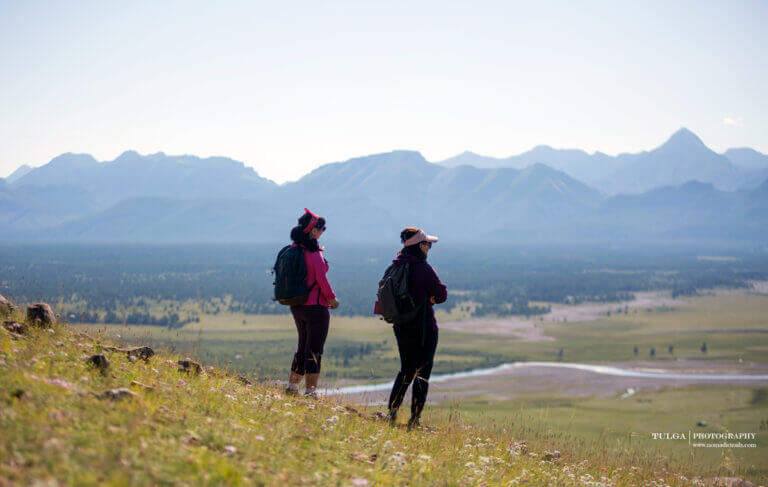
Tailor-Made Tours Mongolia
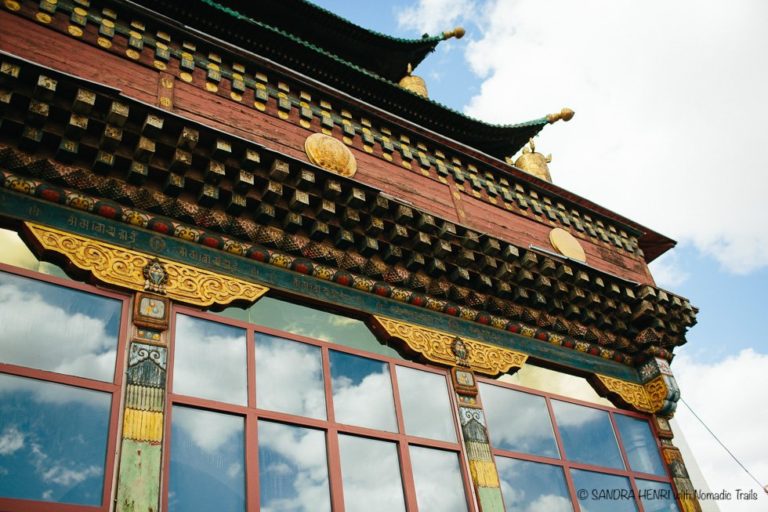
Ulaanbaatar City Tour
- Destinations
- Blogs and Articles
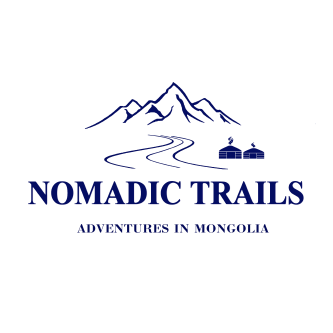
Best Selling Mongolia Tours of 20 years of our operation
Why nomadic trails, authentic experiences.
Our small group, custom and tailor made trips to Mongolia offer you an amazing adventure that ventures beneath the surface of the region.
COMMUNITY SUPPORT
We're a local Mongolian travel agency. We utilize our experience to break down barriers and provide ethical business for people from lesser-known areas with so much to offer.
VETERAN mongolian tour company
We are a well-established Mongolian adventure travel company. Nomadic Trails is successfully operating for more than 17 years as one of the ``A`` licensed best Mongolian tour companies.
FLEXIBLE AND HASSLE-FREE
We specialize in Custom tours. So tell us about your trip requirement. We'll work together to customize your adventure of a lifetime to visit Mongolia.
Middle-man free PRICING
When you book us, you get best possible prices, which is middle-man free. Get the best original Mongolia itinerary with a flexible cancellation policy.
FInd Your tour by region & Destination in Mongolia

Our Testimonials and reviews
- Continue reading...
thanks to Nomadic Trails. Tulga and everyone on his team were so accommodating to any of our requests and even helped us navigate our way through the local market and barter for souvenirs. Truly delicious food as well at every stop. Phenomenal all around. Thank y’all for everything! Unbelievable experience in Mongolia!
Tulga, our tour guide is very knowledgeable and helpful, his driving skills also worth a praise and believe me, on these roads, it is a big advantage for someone like me with a motion sickness. They provided a cook for us, who exceeded all of our expectations. If you want a truly amazing experience just go with them!
and he was able to provide a varied, personal, unique experience. I wanted to create my own personal itinerary and Tulga had the knowledge, contacts, experience and sense of adventure to make that happen. I’ll be returning in 2020 to travel with Nomadic Trails again. Can’t wait!
hopping on our horses to go to the Tsaatan reindeer tribe, then finally staying at one of the best camps in Murun. Everything was so well-organized. Noteworthy is Tulga’s relationship with the tribe, which is an important consideration when we were planning this trip as we want to be as respectful as possible to the tribe for them not to feel uneasy during our stay. Our group was delighted to have raw and authentic Mongolian experience without having to sacrifice comfort – we had delicious food, great accommodation and comfortable transportation all throughout our trip – thanks to the incredible team of Nomadic Trails!
Contact us:
- Call - Whatsapp: +976 99040894
About Nomadic Trails:
- Tour reviews
Popular blogs and articles:

Tour by category
- Adventure Tour Mongolia
- Best Selling Tour Mongolia
- Cultural Tour Mongolia
- Reindeer Festival Tour
- Short Tour Mongolia
- Tailor-Made Tour Mongolia
- Tours for EXPATS in Mongolia
- Winter Tour Mongolia
- Copyright Nomadic Trails Co.,Ltd

- DAILY & SHORT TOURS
- DISCOVERY TOURS
- ACTIVE ADVENTURE TOURS
- COMMUNITY BASED CULTURAL TOURS
- FAMILY FUN TOURS
- SPECIAL INTEREST TOURS
- Western Mongolia
- Northern Mongolia
- Central Mongolia
- Southern Mongolia
- Eastern Mongolia
- Ulaanbaatar surroundings
- 10 Surprising Facts about Modern Mongolians
- 20 Reasons to travel
- Our sustainability plans
- Sustainability policy
- Why choose us
- Testimonials
- Attractions
- Meet Mongolians & Nomadic lifestyle
- Stay at Luxury Camps
- Steppe Eco camp
- Food & Beverage
- Transportation
- Tour Equipment
- Visa Information
- Accommodation
- Online payment
- Tour Schedule
- Terms & Conditions

COMMUNITY BASED TOURS
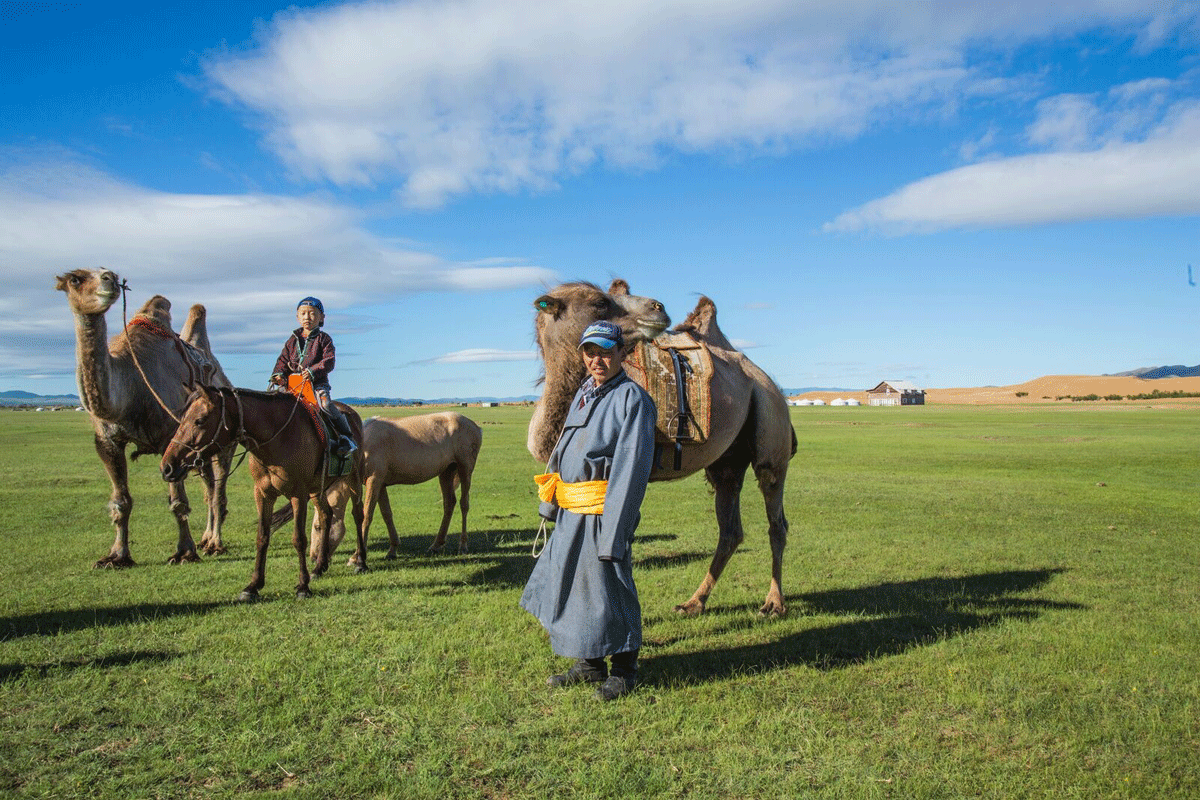
Essence of Mongolia – 7 Days
7 Days 6 Nights Hot spring Cultural Heritage sites – Orkhon valley Kharakhorum – Erdenezuu Monastery Sand dunes of the Mini Gobi Spotting Wildlife – Wild Horse
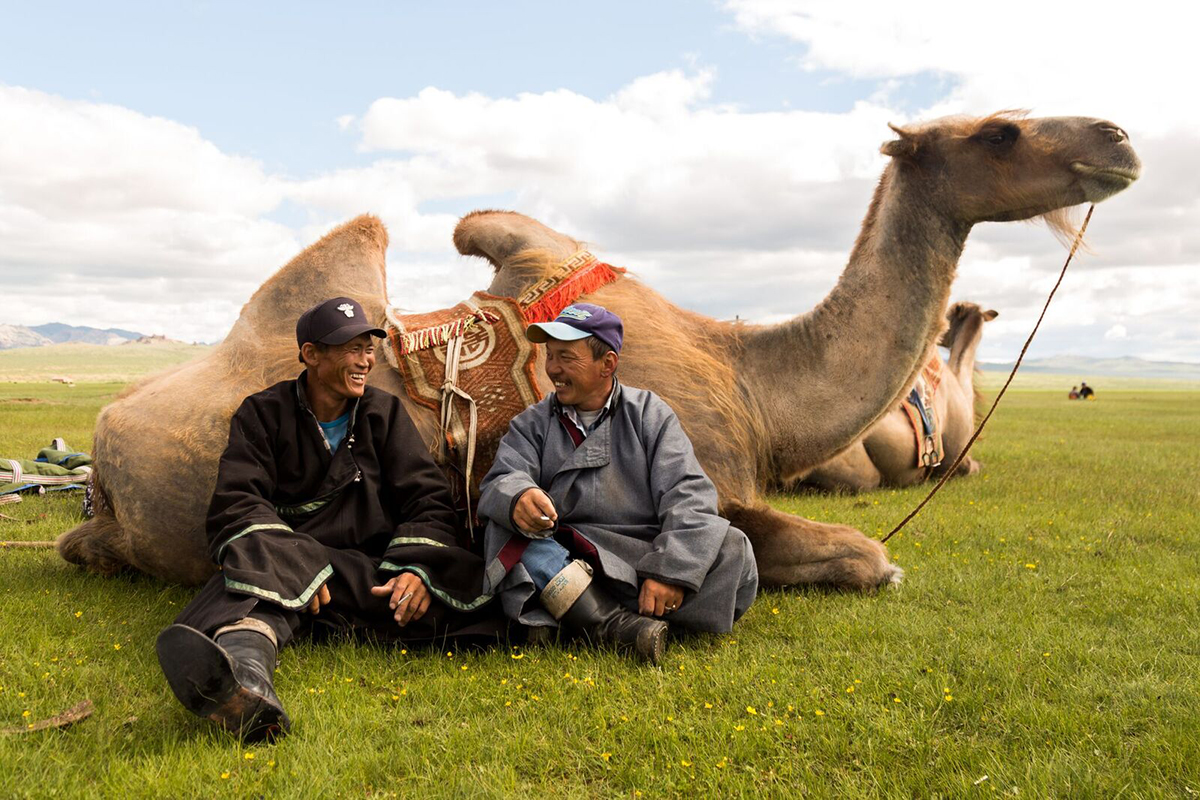
Essence of Mongolia – 3 Days
3 Days 2 Nights Yurt homestay alongside nomads Sand dunes of Mini Gobi Spotting wild horses Trans-Siberian Stopover
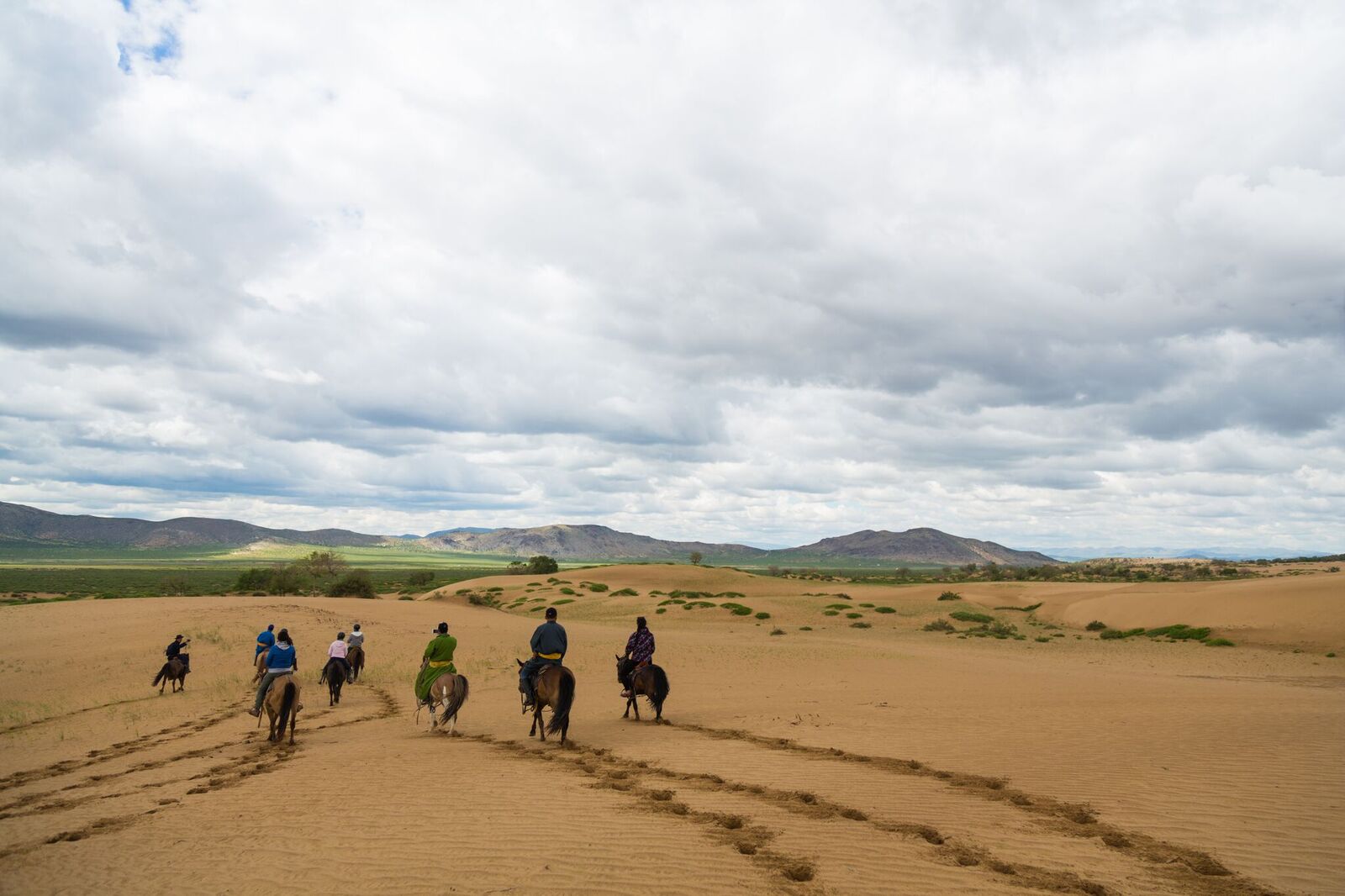
Essence of Mongolia – 5 Days
5 Days 4 Nights Yurt stays alongside nomads Sand dunes of the Mini Gobi Cultural heritage sites & Kharakhorum Trans-Siberian Stopover

Essence of Mongolia – 4 Days
4 Days 3 Nights Yurt stays alongside nomads Sand dunes of the Mini Gobi Spotting wild horses Trans-Siberian Stopover
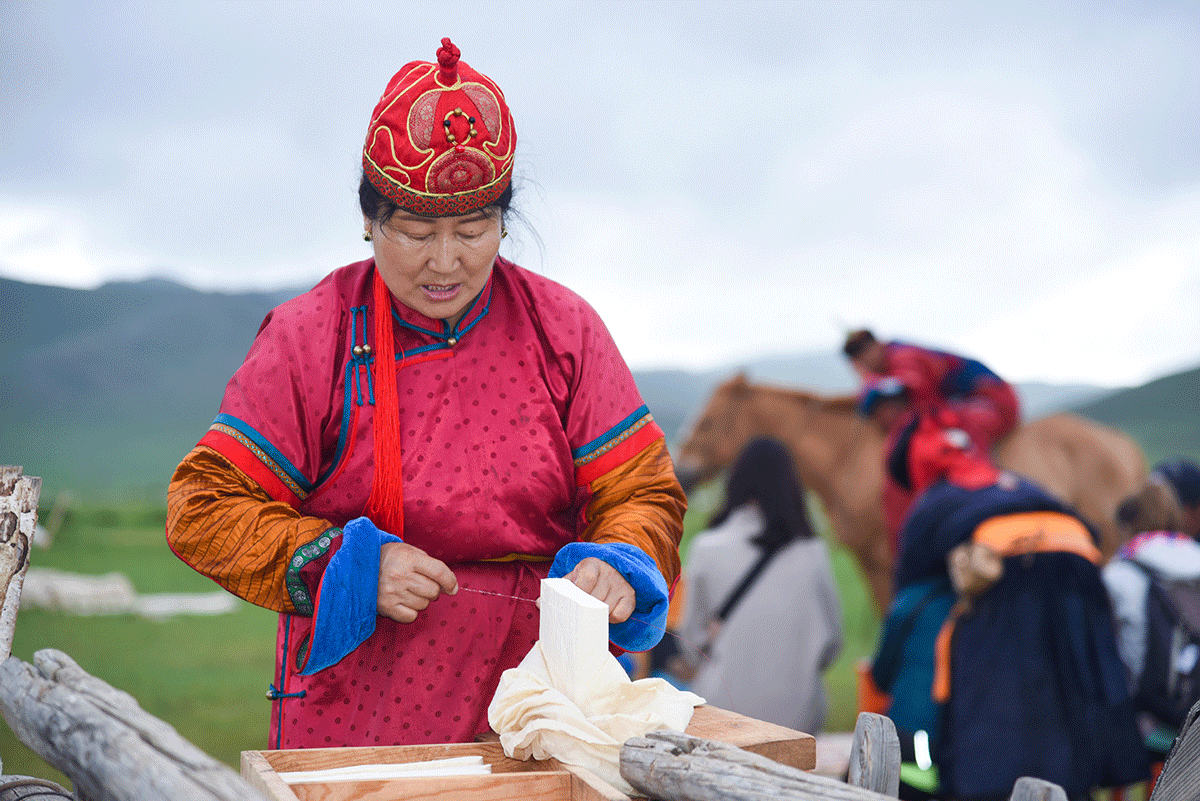
Mongol Nomadic Naadam
4 Days 3 Nights Explore Kharakhorum Visit cultural heritage sites Spot wild horses Enjoy Nomadic Naadam celebration
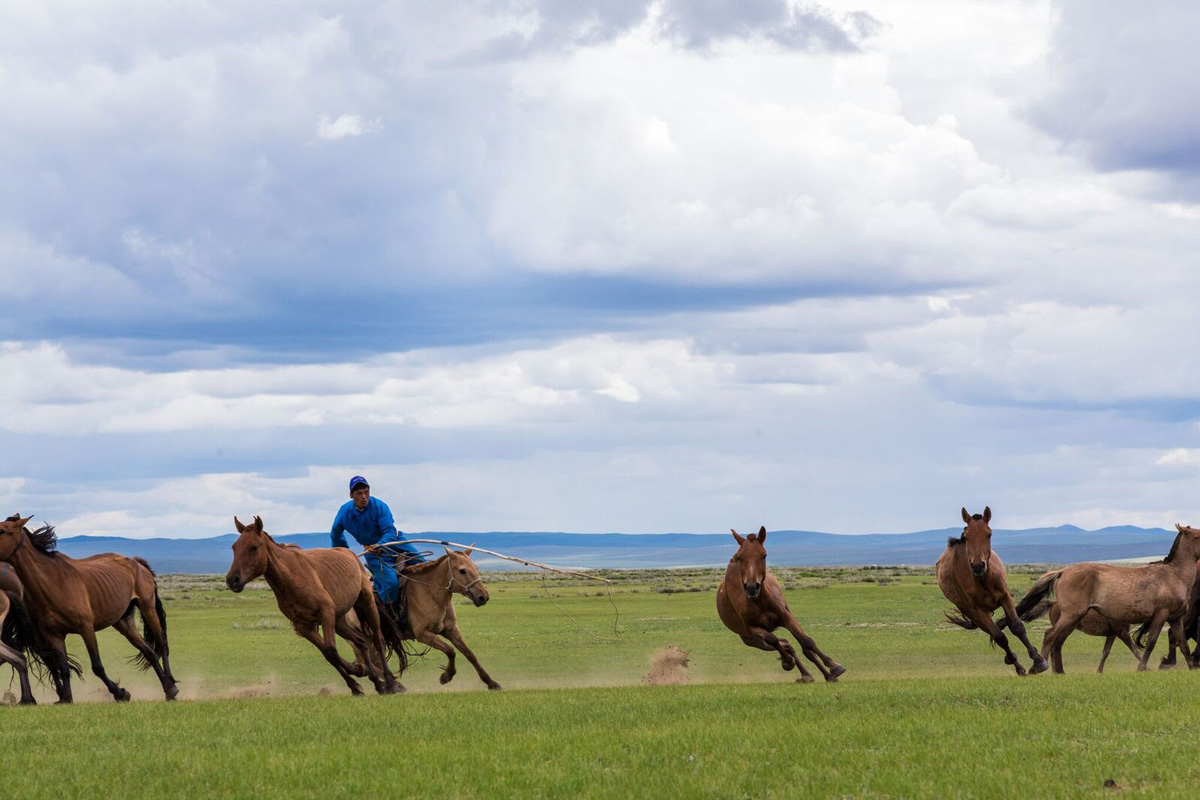
Gurvanbulag Community
5 Days 4 Nights Learning unique nomadic life Tasting traditional cuisine Watching live horse show Hiking through sand dunes
UNESCO heritage workshop focuses on sustainable tourism in waterside ASEAN communities
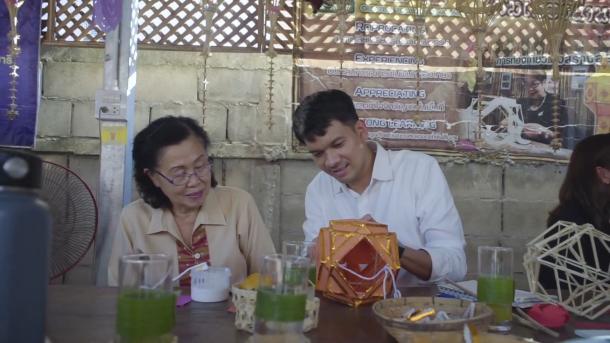
The UNESCO workshop, ‘Integrating Living Heritage and Creative City to Sustainable Tourism in Waterway Cities of Cambodia, Lao PDR and Thailand’ (‘Integrating Living Heritage’ workshop) was held in the heritage destination town of Nan Old City, Thailand, from 4 to 7 February 2024. The workshop was designed for tourism professionals from Cambodia, Lao PDR, and Thailand to engage in an exchange of knowledge and expertise towards developing sustainable tourism models for waterside cities in the three regional Member States—and others, by extension—of the Association of Southeast Asian Nations (ASEAN).
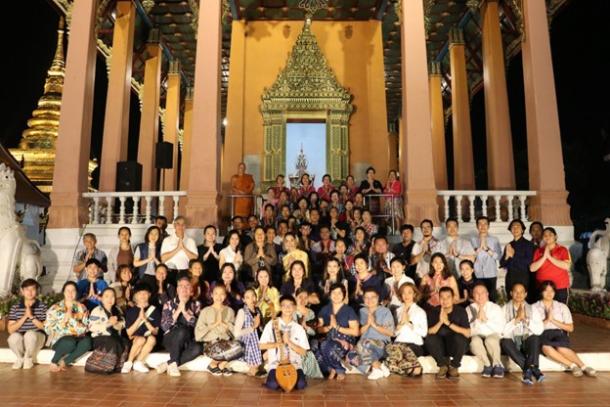
The workshop for trans-boundary networking among the three neighboring countries was made possible with the generous support of the Designated Areas for Sustainable Tourism Administration (DASTA), ASEAN-Türkiye Cooperation, K11, International Training Centre for Intangible Cultural Heritage in the Asia-Pacific Region under the auspices of UNESCO (CRIHAP), and ONYX Hospitality Group. The workshop was facilitated in collaboration with The City Connext and b.Consulting Cambodia.

The ‘Integrating Living Heritage’ workshop aimed to foster meaningful connections among its participants and catalyze various mechanisms for sustainable tourism initiatives in the region, with Nan Old City serving as an illustrative case study. At the core of the workshop was a series of UNESCO-curated activities designed to foster cross-cultural exchange and empower local communities. Led by experts from UNESCO Regional Office in Bangkok, the Thailand Community-Based Tourism Institute (CBT-I), Designated Areas for Sustainable Tourism Administration (DASTA), panel sessions delved into the essence of Intangible Cultural Heritage (ICH) and its pivotal role in shaping inclusive tourism experiences, sustainable tourism, creative cities, and creative tourism.
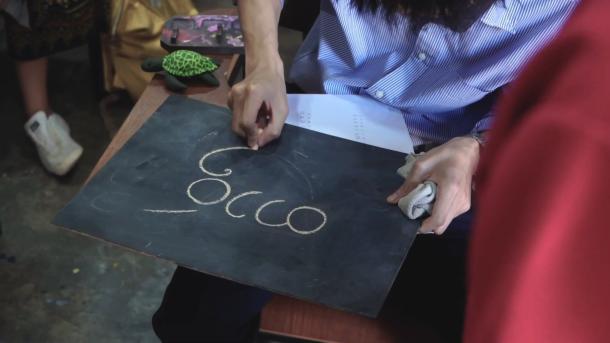
The workshop explored various interconnected topics such as the role of Community-based Tourism (CBT) as a catalyst for sustainable development, and the creation of the CBT social business model. Immersive field visits complemented the programme to allow participants a firsthand experience of Nan’s vibrant culture. In addition, hands-on workshops provided participants with practical skills and tools to navigate the complexities of sustainable tourism development, such as the crafting of compelling narratives that might resonate with diverse audiences, to designing innovative tourism experiences rooted in the local culture and community.
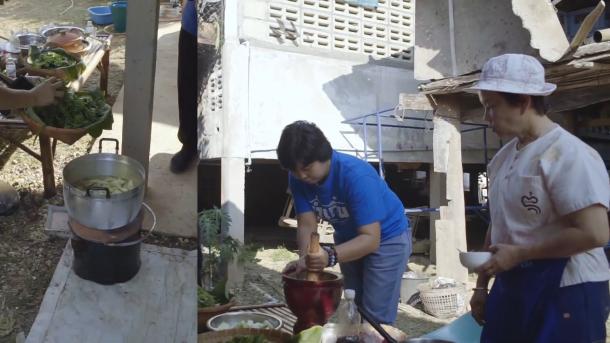
Throughout the workshop, participants learned how to integrate elements of ICH into tourism practices, while building robust networks for future collaboration. Interactive group activities, such as community-based inventorying simulations and role-playing exercises, provided experiences in navigating the complexities of sustainable tourism development. Networking sessions facilitated knowledge-sharing among professionals from diverse backgrounds, including fashion brands, hotels, restaurants, universities, and local municipal authorities and NGOs, reflecting the role of all stakeholders in collaboratively shaping the future of sustainable tourism in the region.
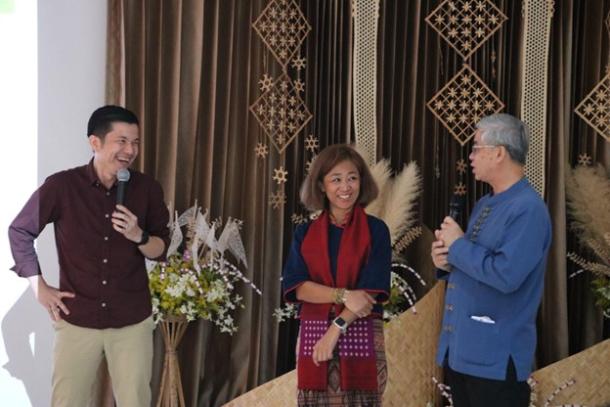
With a large enrollment of youth, the workshop highlighted UNESCO’s priority in empowering young leaders to actively contribute to cultural preservation efforts while embracing innovative approaches to tourism development. Youth participation further underscored the importance of intergenerational dialogue in driving sustainable change.
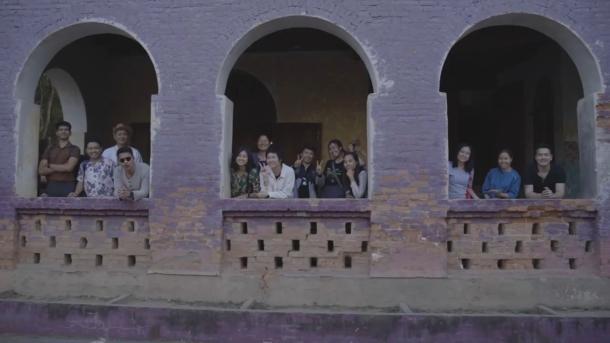
UNESCO is organizing more seminars on sustainable tourism for ASEAN professionals until June 2024. Receive the latest update on planned events and more information by visiting the project portal and the project page .
#SustainableTourism #IntangibleCulturalHeritage #CreativeCities #ASEANWaterwayCities
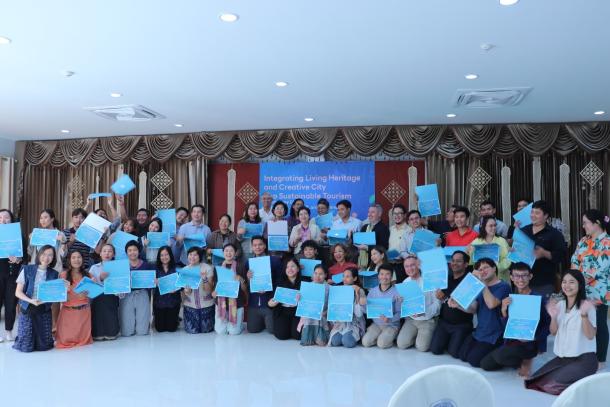
Reporting for this article was contributed by Yizheng Gu, an intern supporting the work of the Culture Unit of the UNESCO Regional Office in Bangkok.
Special thanks to the Development Nan Youth Club and City Connext for the photography and video production.
More from UNESCO Bangkok
Related items.
- Cultural heritage
- Intangible cultural heritage
- Intangible heritage
- Cultural tourism
- Creative cities
- Sustainable Tourism
- Region: Asia and the Pacific
- UNESCO Office in Bangkok and Regional Bureau for Education
- SDG: SDG 8 - Promote sustained, inclusive and sustainable economic growth, full and productive employment and decent work for all
- SDG: SDG 9 - Build resilient infrastructure, promote inclusive and sustainable industrialization and foster innovation
- SDG: SDG 11 - Make cities and human settlements inclusive, safe, resilient and sustainable
- See more add
This article is related to the United Nation’s Sustainable Development Goals .

Other recent news

Sabah Community Based Tourism Fair to be held outside state for the first time
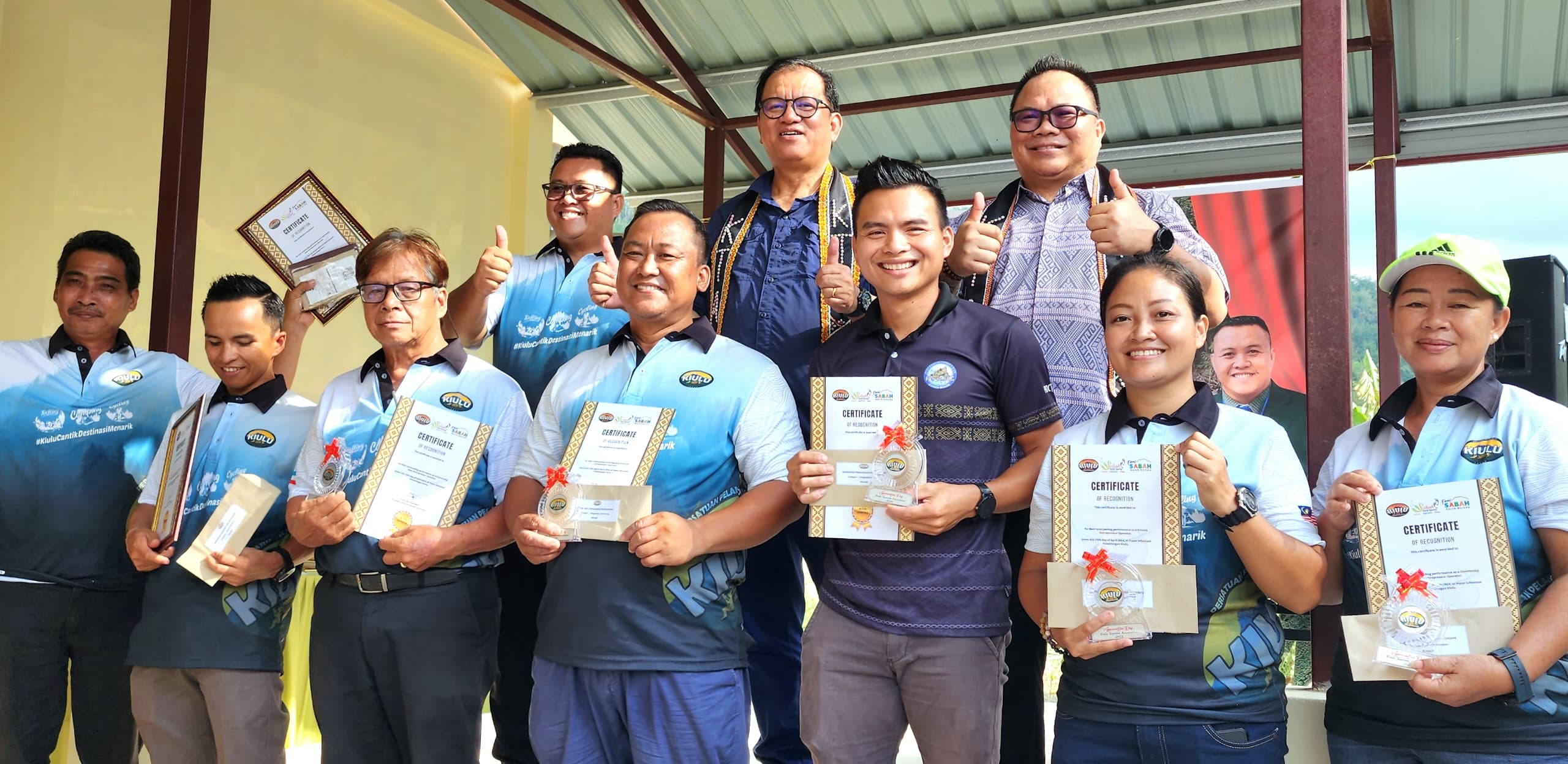
Sabah Tourism Board Chairman Datuk Joniston Bangkuai (middle), STB Chief Executive Officer Julinus Jimit (sixth from left) and Kiulu Tourism Association President Mejin Manginggow (eight from left) posed for the camera after the handing over of the screen panel and appreciation programme in Kiulu on Monday.
KIULU (April 15): Sabah Community Based Tourism Fair 2024 will make its maiden appearance outside Sabah for the first time.
Scheduled to be held in October at the IOI City Mall, Putrajaya, Sabah Tourism Board chairman Datuk Joniston Bangkuai said it was time for local community based operators to venture out of their comfort zone and venture into bigger markets.
“This event offers tour operators and rural tourism product operators to get together and discuss how to better package rural destinations for new markets,” he said at the handing over of the screen panel and 2024 Kiulu Tourism Association Appreciation programme, here, Monday.
A total of 26 community based tourism operators and 40 private entrepreneurs attended the programme.
He added that in addition, a Mentor and Mentee Programme will be introduced in Kiulu which provides a platform for successful tourism operators to share their success stories with newcomers.
“We (STB) are currently identifying mentors and mentees for the programme. The sessions will be done in phases,” said the Kiulu assemblyman.
In addition, Joniston, who is also the Assistant Tourism, Culture and Environment Minister announced that three Sabah rural operators have been shortlisted for this year’s Asean Tourism Standard Accreditation.
The three – Murug-Turug Eco Tourism, Lingga Eco Tourism and Bambangan Lama Eco Tourism, had met the 10 criterias set for the prestigious award.
“The main criterias emphasis on management, business direction, standard operating procedures and how the tourism activities would impact on the local economy.
“Most importantly, all these must be documented,” he said, adding that winning the award would strengthen Sabah’s growing international reputation for rural tourism.
Sponsored links

IMAGES
COMMENTS
Community based tourism not only enriches the experiences of travelers but also gives back to the communities, empowering them to sustain their livelihoods. There are over a couple of dozen tourism-based communities all around Mongolia that travelers can interact with. Some near to town while some extremely far. We bring you that much closer to ...
OUR SDG ACHIEVEMENTS via community based tourism in mongolia. AT GERtoGER we are able to tangibly prove how we advance the UN's MDGs/SDGs in our day-to-day community based tourism operations for DECADES (SINCE I started AUTHORing IT from 2002):. SDG 1 - NO POVERTY: up to 80% of Humanitarian Trips' finances are returned to rural nomads, drivers, etc.; 20% towards rural communities ...
Community Based Tourism. Our communities welcome you to Mongolia. Find out how you can experiences the nomadic way of life. ... Mongolia.travel uses cookies to improve your user experience. Cookies are small text files that are saved on your computer or mobile device when you visit the site. You can change your cookie preferences at any time.
5. Download podcasts and audiobooks for those long road trips. Mongolia is three times the size of France, and most roads are bumpy tracks, which translates to low average speeds even in a modern 4WD. Expect to spend hours bouncing along through vast, unchanging landscapes - beautiful but somewhat repetitive.
2. Embrace nomadic culture One of the most memorable ways to immerse yourself in traditional Mongolian culture and enjoy the pristine countryside is to spend a night in a ger (yurt) with a nomadic family.Used by Mongolian nomads for thousands of years, these circular, felt-covered structures are designed for a life on the move - they are easily assembled and dismantled to move during the ...
Zanabazar, who was the first leader of Buddhism in Mongolia, founded the monastery and lived and meditated here, calling it the "Land of Happy Solitude.". There are several nearby temples and a meditation cave to explore. 7. Gobi Gurvansaikhan National Park. Best place for desert landscapes.
Community based tourism not only enriches the experiences of travelers but also gives back to the communities, empowering them to sustain their livelihoods. There are over a couple of dozen tourism-based communities all around Mongolia that travelers can interact with. Some near to town while some extremely far. We bring you that much closer to ...
Over a third of Mongolia people are still nomadic herders. Growing trends and shifts toward sustainability and community-based tourism makes Mongolia the ideal destination for travellers who seek just that. Through locally-led tours, visitors can discover the natural beauty, delicious food, exciting festivals and immerse themselves in the ...
Growing trends and shifts toward sustainability and community-based tourism makes Mongolia the ideal destination for travellers who seek just that. Through locally-led tours, visitors can discover the natural beauty, delicious food, exciting festivals and immerse themselves in the cultural heritage of local communities. Explore Our Communities.
3. Hustai National Park (Töv Province) Spotting wild horses through binoculars at Hustai National Park. Photo via Jessie Festa. Home to beautiful landscapes and diverse wildlife, the main reason this is one of the best places to see in Mongolia is its wild horses.
Mongolian Community Based Tourism Development, Responsible Tourism, Local Living, Jeep Tours, Expeditions, TV Producer | GER to GER is the WORLD FIRST Mongolian Community Based Tourism Initiative to be sustainably working with nomadic families and rural communities across Mongolia since 2005 to present. GER to GER has become Mongolia's leading ...
Community-Based Tourism: In some areas, community-based tourism initiatives offer guesthouse stays, providing an opportunity to interact with local communities. Western Mongolia (Bayan-Ulgii Province): Ger Camps and Homestays: In the western part of Mongolia, known for its Kazakh culture and stunning landscapes, you can find ger camps and ...
The Mongolian Tourism Association (MTA) plays an important role in the promotion of Mongolia as a travel destination on both the international market and domestic market. Its activities include the development of new marketing strategies and concepts based on specific themes, events, and attractions. The MTA also brings together and optimizes ...
Where to Go in Mongolia - Itinerary. Day 1: Visiting Ulaanbaatar. Day 2: Getting from Ulaanbaatar to the Gobi desert. Day 3: Visit the Baga Gazryn Chuluu Rock Formations. Day 4: Sleep at a Ger Camp in the Gobi Desert. Day 5: Dalanzagad to Gobi Discovery Ger Camp. Day 6: Hiking in Yolin Am - Mongolia's Ice Valley.
The UNWTO Regional Support Office for Asia and the Pacific (RSOAP) is hosting the seminar, Nomadic Culture and Tourism in Mongolia: Revitalization of Community through Sustainable Tourism on December 16, 2014 in Nara, Japan. In response to Mongolia's increased focus on tourism, diverse stakeholders gather together to discuss the challenges, benefits, and strategies of developing and ...
One of the most remarkable sustainable tourism projects in Mongolia is the community-based ecotourism initiative in Khovsgol province. This project, run by local herders in collaboration with non-governmental organizations and the government, allows visitors to stay with a nomadic family and learn about their traditional way of life while ...
Mongolia, with its vast steppes, rugged mountains, and nomadic traditions, has long been a hidden gem for travelers seeking authentic experiences. However, the increasing global awareness of environmental conservation has prompted a shift in Mongolia's tourism landscape. The nation is transitioning from conventional tourism to a more sustainable approach, emphasizing ecotourism. This change ...
Mongolia: Behind the scenes of our Best in Travel Video. Oct 30, 2023 • 3 min read. Mongolia has so much to offer travelers looking for wide open spaces, adventure and culture. Here's what it is like to travel there. Road Trips.
As Mongolia strives to diversify its economy, creativity and newer initiatives are required to bolster the country's tourism sector. The International Monetary Fund's October 2023 figures ...
The Khusvegi English and Nomadic Culture Camp is a community-led slow tourism initiative in Sagsai Soum (Western Mongolia), helping to foster local leaders driving tourism projects, cultivate storytellers and ambassadors from within the community to narrate their own stories to the world, and preserve eagle hunting and nomadic culture. Marinel ...
According to a 2019 survey cited by Mongolia's tourism ministry, 49 percent of visitors to the country were under 40. ... Inside the home of a woman from the Tsaatan community, a group of ...
Nadaam Festival Mongolia - Naadam Festival Tour 2024. 13-days 12-nights. Visit the Golden Gobi, the ancient capital of Mongols Kharkhorin, and discover nomadic culture first-hand by visiting the Naadam Festival Tour Mongolia 2022. 2 to 12 PAX. starting from 2100 USD.
COMMUNITY BASED TOURS. Essence of Mongolia - 7 Days. From US$ 1,250. 7 Days 6 Nights Hot spring Cultural Heritage sites - Orkhon valley ... Post:P.O. Box 166, Ulaanbaatar 15160, Mongolia Email : [email protected], [email protected]. Show map. PRACTICAL. Tour Schedule; Terms & Conditions;
Around 3,500 South Koreans currently reside in Mongolia. During Oyun-Erdene's meeting with South Korean Prime Minister Han Duck-soo, he highlighted the 60 percent increase in Korean tourism to ...
16 April 2024. The UNESCO workshop, 'Integrating Living Heritage and Creative City to Sustainable Tourism in Waterway Cities of Cambodia, Lao PDR and Thailand' ('Integrating Living Heritage' workshop) was held in the heritage destination town of Nan Old City, Thailand, from 4 to 7 February 2024. The workshop was designed for tourism ...
KIULU (April 15): Sabah Community Based Tourism Fair 2024 will make its maiden appearance outside Sabah for the first time. Scheduled to be held in October at the IOI City Mall, Putrajaya, Sabah ...